
- •Foreword
- •Milestones
- •Executive summary
- •National Profiles
- •The road ahead
- •Preparation and Authorship
- •Acknowledgments
- •List of Acronyms
- •Executive Summary
- •Table of Contents
- •List of Figures
- •List of Tables
- •1 Introduction
- •2 Installation Trends
- •3 Industry Trends
- •4 Technology Trends
- •5 Performance Trends
- •6 Cost Trends
- •7 Wind Power Price Trends
- •8 Policy and Market Drivers
- •9 Future Outlook
- •References
- •Appendix: Sources of Data Presented in this Report

vk.com/id446425943

 The road ahead
The road ahead
In the year since KPMG International published its first Autonomous Vehicles Readiness Index, countries across the world have made rapid strides in preparing for an AV future.
Governments have been drafting new rules, companies have been testing their vehicles, the media has been analyzing the benefits and risks of adoption, and consumers have been considering their willingness to ride a driverless car.
In the exciting months and years to follow, many governments will be eager to ensure that the policy environment, investment-attractiveness, infrastructure-readiness and consumer acceptance keep pace with evolving technology. Through this report, KPMG International hopes to have provided insight on best practices for developing autonomous technology and what countries can do to improve in a number of areas.
The road ahead: key insights for governments
——Advanced AV markets could invest more in technology and innovation: Countries like the Netherlands and Singapore, which are already at the top of the index, could far outpace other countries if they focused on Pillar 2. In particular, investing in AV-related firms and R&D, industry partnerships, and an innovation-friendly business environment could cement their position at the top.
——Countries leading in technology and innovation could work on achieving greater policy and institutional clarity: The countries that are leading the world in technology and innovation — Germany, Israel, Japan, Norway and the US — have middling scores in their AV regulatory environment and institutions. Adapting and revisiting their regulations, and establishing an AVfocused institution could take these countries to the top of the rankings.
——Most countries that do well on infrastructure readiness should reform their policy and legislative environment: Six of the 10 countries that lead the world on infrastructure readiness (Pillar 3) — Australia, Austria, Japan, South Korea, Sweden and the UAE — do not feature in the top 10 of policy/legislative environment (Pillar 1). Since these countries have some of the more capital-intensive parameters like network connectivity, 4G coverage, and roads in place, to improve their positions, they could work on relatively low-hanging fruit like establishing AV regulations and institutions.
——Less-developed AV markets could take advantage of higher consumer interest in AVs if other areas, including policy and technology, are addressed: Countries with the lowest overall scores like Brazil, India, Mexico and Russia, have the highest scores in our new survey testing respondents’ willingness to ride in an AV.This is good news in the long term for AV manufacturers given the size of these consumer markets, but only if governments actively develop other areas.
402019 Autonomous Vehicles Readiness Index
©2019 KPMG International Cooperative (“KPMG International”). KPMG International provides no client services and is a Swiss entity with which the independent member firms of the KPMG network are affiliated.

vk.com/id446425943
Our role in your decisions
As AV technology evolves, stakeholders across sectors will have to strategically, flexibly and nimbly prepare for a transformation of the world as we know it.
——Transport authorities will develop and adapt governance and legislation to address complex themes like data security, safety, and the ethics of artificial intelligence.
——Infrastructure operators will grapple with an increasing pace of change and shorter planning horizons.
——Manufacturers will develop new operating models to be commercially viable.
——Investors will have to engage with new investment classes and design innovative value capture models.
——Consumers will come to understand a new transportation paradigm enabled by artificial intelligence.
KPMG member firms can help you explore your options and achieve your objectives. Our past and ongoing experience in the sector has prepared us to advise in the following areas.
——We help local, regional and national transport authorities and infrastructure providers develop and execute strategies to keep pace with AV disruption.
——We help local investment authorities identify and pitch to AV prospects for foreign direct investment.
——We help private sector companies and funds analyze and identify opportunities for investment and partnerships in the AV value chain.
——We produce cutting-edge research on AVs that enables a multitude of stakeholders to understand the dynamic and uncertain space.
About KPMG
KPMG’s Global Public Sector Transport network works with public transport authorities to embrace emerging technologies to help increase capacity, optimize asset life cycle and leverage existing data. We help governments and transport providers to understand and shape the future of public transport, while supporting them in improving the experiences of customers today.
We understand that clients need to enhance their performance while cutting costs and using existing assets, and we support them through realizing the value of their land and increasing ancillary revenues, such as from digital advertising. Our teams also support them in helping to maximize opportunities from disruptive technologies including EVs mobility-as-a-service, service, smart assets and transport systems, data and analytics.
For more information, visit kpmg.com/publictransport.
KPMG’s Global Government & Public Sector practice works to deliver meaningful results through a deep understanding of the issues, an appreciation of how the public sector works, and global and local insight into the cultural, social and political pressures facing governments today. Our network of professionals, many of whom have held senior public sector roles, consistently strive to combine their practical, hands-on experience with insight from our global network to help our industry clients implement transformational strategies, economically, efficiently and effectively. We understand the continuing impact of innovation and disruption on governments as they search for more efficient ways to deploy technology to empower change within their organizations. For further information, please visit us online at kpmg.com/government.
2019 Autonomous Vehicles Readiness Index 41
© 2019 KPMG International Cooperative (“KPMG International”). KPMG International provides no client services and is a Swiss entity with which the independent member firms of the KPMG network are affiliated.

vk.com/id446425943

 Appendix: Results
Appendix: Results
and methodology
The 25 countries have been assessed on
25 different measures, gathered into four pillars. Four measures are scored for this index by KPMG International and ESI ThoughtLab, which used publicly available information, including media reports, press releases and other material. One measure uses a consumer survey carried out
by Branded Research in each of the countries.
A further 20 variables draw on existing research by KPMG International and other organizations.
The variables under the four pillars are combined to arrive at an aggregate score for each. All variables are given equal weight in arriving at the overall pillar score. Before the data is combined it is normalized, as the variables have different measurement units, using the min-max method. This converts the variables to a range between zero and one, by subtracting the minimum value and dividing by the range of the variable values.
Therefore the top-ranked country receives one and the bottom country zero.
Pillars have differing number of variables, so each pillar score is scaled to give them the same maximum possible value. This means that each
pillar has equal weight in the overall score for each country.
ESI ThoughtLab

422019 Autonomous Vehicles Readiness Index
©2019 KPMG International Cooperative (“KPMG International”). KPMG International provides no client services and is a Swiss entity with which the independent member firms of the KPMG network are affiliated.

vk.com/id446425943
2019 Autonomous Vehicles Readiness Index 43
© 2019 KPMG International Cooperative (“KPMG International”). KPMG International provides no client services and is a Swiss entity with which the independent member firms of the KPMG network are affiliated.

vk.com/id446425943


 Policy and legislation
Policy and legislation
Overview
——Singapore leads this pillar overall and gains the highest scores on five of its seven measures, including a World Economic Forum assessment of effectiveness of lawmaking bodies and
a KPMG measure of government change readiness.
——Singapore also shares the top rating in an assessment of its AV regulations with Australia, Finland and the Netherlands, and for having
a single government entity for AV work with Hungary.
——Along with Canada, the Czech Republic and South Korea, Singapore also gains top marks in the assessment of government-funded AV pilots.
——The UK, second-placed in this pillar, leads on a new measure assessing the data-sharing environment, added as such sharing enables
greater collaboration between government and companies in AV development.
Methodology
The pillar is calculated from seven equally weighted factors, one of which is new for the 2019 edition of the index.
AV regulations, government-funded AV pilots and
AV-focused agency: each of these three factors is scored out of seven for this index based on a review of media articles, government press releases and government regulations.
On AV regulations, countries that have regulations that are supportive of AV use and place few restrictions on when, where and how testing of AVs may occur are scored higher and countries that place greater restrictions on testing are scored lower. The maximum score is awarded to Australia, Finland, Singapore and the Netherlands. The lowest scores go to Mexico, then Brazil and India.
A similar approach is taken for government-funded AV pilots. The maximum score is awarded to Canada, the Czech Republic, Singapore and South Korea. Brazil and Mexico receive the minimum score, followed by India and Russia.
With the AV-focused agency variable, governments that spread the responsibility for AVs across a large number of government entities are given lower marks; those that take the most common approach, of placing responsibility in an existing agency, gain middling marks; and those establishing an AV or transportation technology and innovation-focused agency that has sole responsibility gain the highest marks. As well as providing innovators with a single point of contact, such focus demonstrates a government’s commitment. Hungary and Singapore are awarded maximum marks, followed by Austria, New Zealand and the UAE. India gets the minimum score, followed by Brazil and Mexico.
Government readiness for change: scores are based on KPMG International’s 2017 Change readiness index, updated for 2018.127 This is
a composite index that assesses regulation, government strategic planning and the rule of law among other measures. Singapore, the UAE and Sweden receive the highest scores and Brazil, Mexico and Russia the lowest.
Effectiveness of legislative process and efficiency of the legal system in challenging regulations: both from the World Economic Forum’s Networked Readiness Index for 2018, as judged by business executives in each country.128 The effectiveness
of the legislative process is included to measure a country’s ability to pass regulations necessary for the development of AVs. Singapore, New Zealand and the UK gain the highest scores, while Brazil, Mexico and South Korea receive the lowest.
The measure on challenging regulations through the legal system is included to gauge the ability of AV manufacturers and others to challenge unfavorable government rules. On this, Finland, the US and New Zealand receive the highest scores while Hungary, Brazil and the Czech Republic get the lowest ones.
Data-sharing environment: from the World Wide Web Foundation’s Open data barometer for 2016, the latest edition which covers all 25 AVRI countries.129 Countries adopting open and shared data approaches score higher, as this enables greater collaboration between government and
private industry to encourage AV development. The UK, Canada and France rank highest while China, Hungary and the UAE rank lowest.
442019 Autonomous Vehicles Readiness Index
©2019 KPMG International Cooperative (“KPMG International”). KPMG International provides no client services and is a Swiss entity with which the independent member firms of the KPMG network are affiliated.
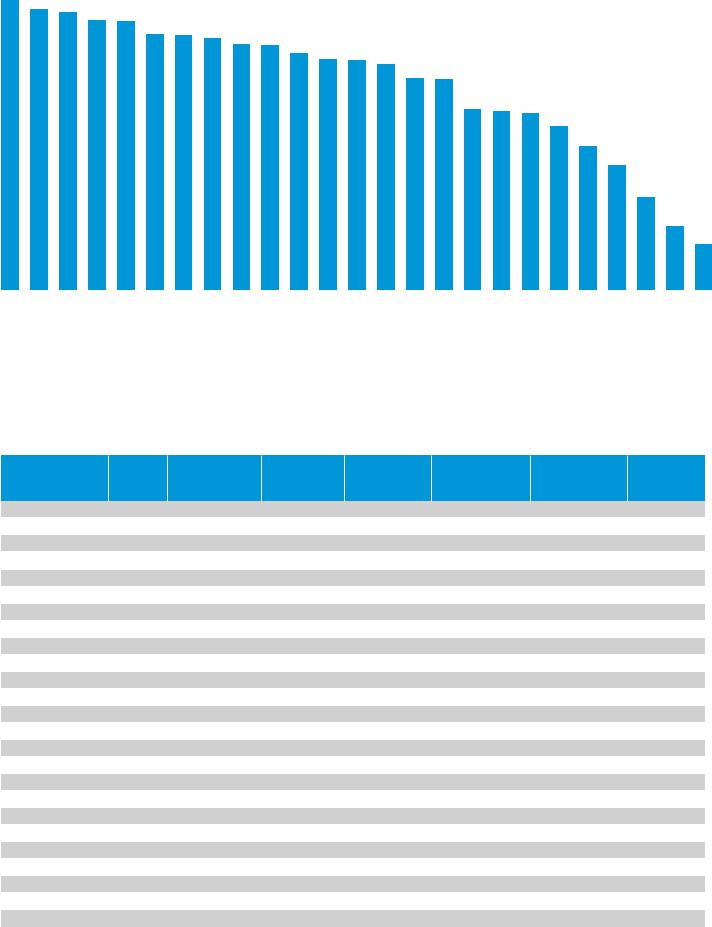
vk.com/id446425943
Pillar 1: aggregate scores by country
7.85 |
7.60 |
|
|
|
|
|
|
|
|
|
|
|
|
|
|
|
|
|
|
|
|
|
|
|
|
7.53 |
|
|
|
|
|
|
|
|
|
|
|
|
|
|
|
|
|
|
|
|
|
|
|
|
|
7.30 |
7.27 |
|
|
|
|
|
|
|
|
|
|
|
|
|
|
|
|
|
|
|
|
|
|
|
|
|
|
|
|
|
|
|
|
|
|
|
|
|
|
|
|
|
|
|
|
||
|
|
|
|
|
6.92 |
6.90 |
6.82 |
6.65 |
6.63 |
|
|
|
|
|
|
|
|
|
|
|
|
|
|
|
|
|
|
|
|
|
|
|
|
|
|
|
|
|
|
|
|
|
|
|
|
|
|||
|
|
|
|
|
|
|
|
6.41 |
|
|
|
|
|
|
|
|
|
|
|
|
|
|
||
|
|
|
|
|
|
|
|
|
|
6.24 |
6.23 |
|
|
|
|
|
|
|
|
|
|
|
|
|
|
|
|
|
|
|
|
|
|
|
|
6.12 |
|
|
|
|
|
|
|
|
|
|
|
||
|
|
|
|
|
|
|
|
|
|
|
|
|
|
|
|
|
|
|
|
|
|
|
|
|
|
|
|
|
|
|
|
|
|
|
|
|
|
|
5.74 |
5.71 |
|
|
|
|
|
|
|
|
|
|
|
|
|
|
|
|
|
|
|
|
|
|
|
|
|
4.88 |
4.84 |
4.79 |
|
|
|
|
|
|
|
|
|
|
|
|
|
|
|
|
|
|
|
|
|
|
|
|
|
|
|
|
|
|
|
|
|
|
|
|
|
|
|
|
|
|
|
|
|
|
|
|
|
|
4.44 |
|
|
|
|
|
|
|
|
|
|
|
|
|
|
|
|
|
|
|
|
|
|
|
|
|
3.89 |
|
|
|
|
|
|
|
|
|
|
|
|
|
|
|
|
|
|
|
|
|
|
|
|
|
3.37 |
|
|
|
|
|
|
|
|
|
|
|
|
|
|
|
|
|
|
|
|
|
|
|
|
|
2.50 |
|
|
|
|
|
|
|
|
|
|
|
|
|
|
|
|
|
|
|
|
|
|
|
|
|
1.71 |
|
|
|
|
|
|
|
|
|
|
|
|
|
|
|
|
|
|
|
|
|
|
|
|
|
1.23 |
Singapore |
United Kingdom |
New Zealand |
Finland |
The Netherlands |
Germany |
Norway |
Canada |
United States |
Sweden |
United Arab Emirates |
Australia |
Austria |
France |
Japan |
South Korea |
Czech Republic |
Israel |
Spain |
China |
Hungary |
Russia |
India |
Mexico |
Brazil |
Pillar 1: (Policy and legislation) normalized indicator values by country
|
Country |
AV |
AV department |
|
KPMG Change |
|
WEF — |
|
WEF — Efficiency |
|
Number of |
|
Assessment of |
|
|
|
regulations |
within government |
|
Readiness |
|
Effectiveness of |
|
of the legal system |
|
government-funded |
|
the data-sharing |
|
|
|
|
transportation dept. |
|
Government |
|
lawmaking bodies |
|
in challenging |
|
AV pilots |
|
environment |
|
|
|
|
|
|
Capability pillar |
|
|
|
regulations |
|
|
|
|
|
|
Singapore |
|
1.000 |
|
1.000 |
|
1.000 |
|
0.697 |
|
1.000 |
|
0.411 |
|
|
1.000 |
|
|
|
|
|
|
|||||||
|
|
|
|
|
|
|
|
|
|
|
|
|
|
|
|
United Kingdom |
0.917 |
0.857 |
|
0.673 |
|
0.847 |
|
0.781 |
|
0.833 |
|
1.000 |
|
|
|
|
|
|
|
|
|
|
|
|
|
|
|
|
|
New Zealand |
0.917 |
0.929 |
|
0.845 |
|
0.882 |
|
0.874 |
|
0.667 |
|
0.743 |
|
|
|
|
|
|
|
|
|
|
|
|
|
|
|
|
|
Finland |
1.000 |
0.714 |
|
0.892 |
|
0.786 |
|
1.000 |
|
0.833 |
|
0.451 |
|
|
|
|
|
|
|
|
|
|
|
|
|
|
|
|
|
The Netherlands |
1.000 |
0.714 |
|
0.766 |
|
0.732 |
|
0.837 |
|
0.917 |
|
0.688 |
|
|
|
|
|
|
|
|
|
|
|
|
|
|
|
|
|
Germany |
0.750 |
0.857 |
|
0.778 |
|
0.679 |
|
0.867 |
|
0.833 |
|
0.621 |
|
|
|
|
|
|
|
|
|
|
|
|
|
|
|
|
|
Norway |
0.917 |
0.643 |
|
0.856 |
|
0.792 |
|
0.654 |
|
0.833 |
|
0.674 |
|
|
|
|
|
|
|
|
|
|
|
|
|
|
|
|
|
Canada |
0.750 |
0.714 |
|
0.622 |
|
0.732 |
|
0.617 |
|
1.000 |
|
0.870 |
|
|
|
|
|
|
|
|
|
|
|
|
|
|
|
|
|
United States |
0.833 |
0.714 |
|
0.527 |
|
0.422 |
|
0.986 |
|
0.917 |
|
0.771 |
|
|
|
|
|
|
|
|
|
|
|
|
|
|
|
|
|
Sweden |
0.667 |
0.714 |
|
0.968 |
|
0.785 |
|
0.730 |
|
0.667 |
|
0.625 |
|
|
|
|
|
|
|
|
|
|
|
|
|
|
|
|
|
United Arab Emirates |
0.833 |
0.929 |
|
0.990 |
|
0.748 |
|
0.739 |
|
0.667 |
|
0.081 |
|
|
|
|
|
|
|
|
|
|
|
|
|
|
|
|
|
Australia |
1.000 |
0.714 |
|
0.663 |
|
0.622 |
|
0.592 |
|
0.500 |
|
0.765 |
|
|
|
|
|
|
|
|
|
|
|
|
|
|
|
|
|
Austria |
0.833 |
0.929 |
|
0.648 |
|
0.456 |
|
0.518 |
|
0.833 |
|
0.629 |
|
|
|
|
|
|
|
|
|
|
|
|
|
|
|
|
|
France |
0.750 |
0.714 |
|
0.480 |
|
0.624 |
|
0.545 |
|
0.833 |
|
0.815 |
|
|
|
|
|
|
|
|
|
|
|
|
|
|
|
|
|
Japan |
0.333 |
0.571 |
|
0.537 |
|
0.780 |
|
0.720 |
|
0.833 |
|
0.691 |
|
|
|
|
|
|
|
|
|
|
|
|
|
|
|
|
|
South Korea |
0.833 |
0.857 |
|
0.380 |
|
0.216 |
|
0.391 |
|
1.000 |
|
0.766 |
|
|
|
|
|
|
|
|
|
|
|
|
|
|
|
|
|
Czech Republic |
0.833 |
0.714 |
|
0.484 |
|
0.231 |
|
0.225 |
|
1.000 |
|
0.309 |
|
|
|
|
|
|
|
|
|
|
|
|
|
|
|
|
|
Israel |
0.667 |
0.643 |
|
0.435 |
|
0.364 |
|
0.572 |
|
0.750 |
|
0.331 |
|
|
|
|
|
|
|
|
|
|
|
|
|
|
|
|
|
Spain |
0.833 |
0.714 |
|
0.341 |
|
0.425 |
|
0.245 |
|
0.500 |
|
0.668 |
|
|
|
|
|
|
|
|
|
|
|
|
|
|
|
|
|
China |
0.500 |
0.643 |
|
0.367 |
|
0.460 |
|
0.564 |
|
0.917 |
|
0.000 |
|
|
|
|
|
|
|
|
|
|
|
|
|
|
|
|
|
Hungary |
0.583 |
1.000 |
|
0.232 |
|
0.330 |
|
0.000 |
|
0.833 |
|
0.046 |
|
|
|
|
|
|
|
|
|
|
|
|
|
|
|
|
|
Russia |
0.500 |
0.857 |
|
0.133 |
|
0.304 |
|
0.302 |
|
0.167 |
|
0.360 |
|
|
|
|
|
|
|
|
|
|
|
|
|
|
|
|
|
India |
0.167 |
0.000 |
|
0.221 |
|
0.417 |
|
0.682 |
|
0.167 |
|
0.288 |
|
|
|
|
|
|
|
|
|
|
|
|
|
|
|
|
|
Mexico |
0.000 |
0.143 |
|
0.093 |
|
0.200 |
|
0.225 |
|
0.000 |
|
0.670 |
|
|
|
|
|
|
|
|
|
|
|
|
|
|
|
|
|
Brazil |
0.167 |
0.143 |
|
0.000 |
|
0.000 |
|
0.157 |
|
0.000 |
|
0.488 |
|
|
Source: KPMG International, 2019 |
|
|
|
|
|
|
|
|
|
|
|
|
|
|
|
|
|
|
|
|
|
|
2019 Autonomous Vehicles Readiness Index |
45 |
||||
© 2019 KPMG International Cooperative (“KPMG International”). KPMG International provides no client services and is a Swiss entity with which the independent member firms of the KPMG network are affiliated.

vk.com/id446425943



 Technology and
Technology and
innovation
Overview
——Israel is the clear leader with the top scores for industry partnerships, AV company headquarters and AV investments, all adjusted for population.
——Japan leads on number of AV-related patents, with data from PatSeer to August 2018 finding 5,272, followed by the US with 4,476 and China with 3,548. Japan also has the most patents per capita, the measure used in the index.
——The World Economic Forum finds that Finland has the best availability of the latest technology and the US has the best capacity for innovation.
——Norway has by far the highest market share for EVs of more than 39 percent. EVs are a precursor for AVs, which are expected to be mostly electric.
Methodology
The pillar is calculated from seven equally weighted factors, two fewer than in the 2018 AVRI.
Industry partnerships: the measure is scored out of seven for this index, based on a review of news coverage from local and global media, research from consulting firms and blogs maintained by
AV industry experts. The rapid and disruptive nature of AV technology has made partnerships between vehicle makers and technology suppliers essential, and many have been formed recently. Those countries that are home to companies that have established a large number of partnerships are given higher scores. Canada, Germany, Israel, South Korea and the US all gain the maximum score while Mexico scores the lowest, followed by Brazil, India and Russia.
AV technology firm headquarters: based on a list of AV-related technology companies built from those published by Vision System Intelligence130 and Comet Labs,131 updated for this edition with data from Crunchbase Pro on AV companies founded since the 2018 report.132 The US has the highest number of headquarters at 258 followed by the UK with 39 and Germany with 26. Numbers
are scaled by national population for the index, with the result that Israel, Finland and Sweden gain the highest scores and Czech Republic, Mexico, New Zealand and the UAE are ranked lowest.
AV-related patents: this measure uses data from PatSeer133 on all AV-related patents and patent applications made by August 2018 for the
25 countries. Numbers are scaled by national populations, and on this basis Japan, South Korea and Germany score highest while the Czech Republic, Singapore and the UAE all get the minimum score.
Industry investments in AV: using data from Crunchbase Pro covering investments since 2007, this measure is based on the countries of investing organizations, rather than where the investment is made. Again, this is scaled by national populations. The leading countries for investment on a per capita basis are Israel, Norway and the US while the Czech Republic, Finland, Hungary, Mexico, New Zealand and the UAE all get the minimum score.
Availability of the latest technology and capacity for innovation: both from the World Economic Forum’s Networked readiness index, based on responses from business executives.134 They judge that Finland, Norway and Israel have the greatest access to the latest technologies and so receive the highest scores while Russia, China and Brazil have the lowest. Executives see the US, Sweden and Israel as having the greatest capacities for innovation and Hungary, Brazil and Mexico as having the least.
Market share of electric cars: data for most countries comes from the International Energy Agency’s Global EV outlook 2018 135 while information for other countries is gathered from country-specific data sources. Countries are scored more highly for bigger market shares for EVs, given that most AVs will be electric. Norway, Sweden and the Netherlands rank highest, while the Czech Republic, Hungary, Israel and Russia all get the minimum score.
462019 Autonomous Vehicles Readiness Index
©2019 KPMG International Cooperative (“KPMG International”). KPMG International provides no client services and is a Swiss entity with which the independent member firms of the KPMG network are affiliated.
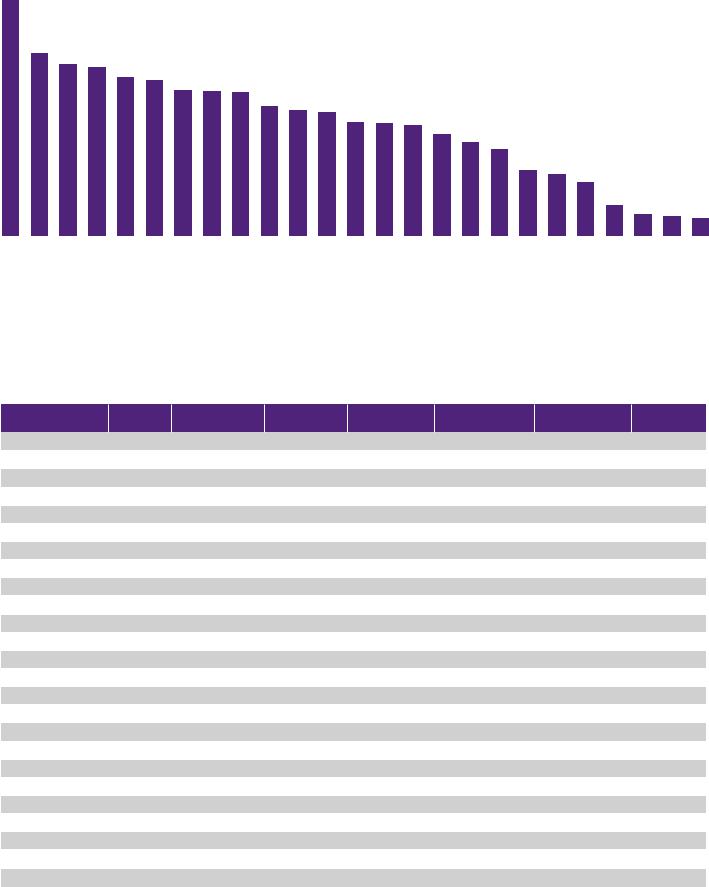
vk.com/id446425943
Pillar 2: aggregate scores by country
6.38 |
|
|
|
|
|
|
|
|
|
|
|
|
|
|
|
|
|
|
|
|
|
|
|
|
|
4.94 |
4.65 |
|
|
|
|
|
|
|
|
|
|
|
|
|
|
|
|
|
|
|
|
|
|
|
|
4.56 |
|
|
|
|
|
|
|
|
|
|
|
|
|
|
|
|
|
|
|
|
|
|
|
|
|
4.28 |
|
|
|
|
|
|
|
|
|
|
|
|
|
|
|
|
|
|
|
|
|
|
|
|
|
4.20 |
|
|
|
|
|
|
|
|
|
|
|
|
|
|
|
|
|
|
|
|
|
|
|
|
|
3.92 |
3.91 |
|
|
|
|
|
|
|
|
|
|
|
|
|
|
|
|
|
|
|
|
|
|
|
|
3.87 |
|
|
|
|
|
|
|
|
|
|
|
|
|
|
|
|
||
|
|
|
|
|
|
|
|
|
3.49 |
3.38 |
3.34 |
|
|
|
|
|
|
|
|
|
|
|
|
|
|
|
|
|
|
|
|
|
|
|
3.06 |
|
|
|
|
|
|
|
|
|
|
|
|
||
|
|
|
|
|
|
|
|
|
|
|
|
3.04 |
2.99 |
2.74 |
|
|
|
|
|
|
|
|
|
|
|
|
|
|
|
|
|
|
|
|
|
|
|
|
|
2.52 |
|
|
|
|
|
|
|
|
|
|
|
|
|
|
|
|
|
|
|
|
|
|
|
|
|
2.32 |
|
|
|
|
|
|
|
|
|
|
|
|
|
|
|
|
|
|
|
|
|
|
|
|
|
|
|
|
|
|
|
|
|
|
|
|
|
|
|
|
|
|
|
|
|
|
|
|
|
|
|
1.77 |
1.65 |
|
|
|
|
|
|
|
|
|
|
|
|
|
|
|
|
|
|
|
|
|
|
|
|
1.44 |
|
|
|
|
|
|
|
|
|
|
|
|
|
|
|
|
|
|
|
|
|
|
|
|
|
|
|
|
|
|
|
|
|
|
|
|
|
|
|
|
|
|
|
|
|
|
|
|
|
|
|
0.80 |
0.55 |
|
|
|
|
|
|
|
|
|
|
|
|
|
|
|
|
|
|
|
|
|
|
|
|
0.50 |
0.46 |
|
Israel |
Norway |
United States |
Germany |
Japan |
Sweden |
South Korea |
Finland |
United Kingdom |
The Netherlands |
Canada |
France |
Austria |
United Arab Emirates |
Singapore |
New Zealand |
Australia |
Czech Republic |
China |
Spain |
Hungary |
India |
Mexico |
Russia |
Brazil |
Pillar 2: (Technology and innovation) normalized indicator values by country
|
Country |
Industry |
AV tech firm HQ |
|
AV-related patents |
|
Investment in |
|
WEF — Availability of |
|
WEF — Capacity for |
|
Market share of |
|
|
|
partnerships |
|
|
|
|
AV-related firms |
|
the latest technology |
|
innovation |
|
electric cars |
|
|
Israel |
|
1.000 |
|
0.045 |
|
1.000 |
|
0.946 |
|
0.968 |
|
0.000 |
|
|
1.000 |
|
|
|
|
|
|
|||||||
|
|
|
|
|
|
|
|
|
|
|
|
|
|
|
|
Norway |
0.917 |
0.126 |
|
0.009 |
|
0.155 |
|
0.971 |
|
0.662 |
|
1.000 |
|
|
|
|
|
|
|
|
|
|
|
|
|
|
|
|
|
United States |
1.000 |
0.176 |
|
0.340 |
|
0.141 |
|
0.931 |
|
1.000 |
|
0.031 |
|
|
|
|
|
|
|
|
|
|
|
|
|
|
|
|
|
Germany |
1.000 |
0.069 |
|
0.752 |
|
0.030 |
|
0.751 |
|
0.901 |
|
0.041 |
|
|
|
|
|
|
|
|
|
|
|
|
|
|
|
|
|
Japan |
0.833 |
0.029 |
|
1.000 |
|
0.009 |
|
0.843 |
|
0.588 |
|
0.026 |
|
|
|
|
|
|
|
|
|
|
|
|
|
|
|
|
|
Sweden |
0.750 |
0.179 |
|
0.214 |
|
0.124 |
|
0.937 |
|
0.904 |
|
0.161 |
|
|
|
|
|
|
|
|
|
|
|
|
|
|
|
|
|
South Korea |
1.000 |
0.043 |
|
0.863 |
|
0.040 |
|
0.633 |
|
0.438 |
|
0.033 |
|
|
|
|
|
|
|
|
|
|
|
|
|
|
|
|
|
Finland |
0.917 |
0.199 |
|
0.044 |
|
0.000 |
|
1.000 |
|
0.813 |
|
0.066 |
|
|
|
|
|
|
|
|
|
|
|
|
|
|
|
|
|
United Kingdom |
0.833 |
0.130 |
|
0.246 |
|
0.123 |
|
0.855 |
|
0.778 |
|
0.043 |
|
|
|
|
|
|
|
|
|
|
|
|
|
|
|
|
|
The Netherlands |
0.667 |
0.129 |
|
0.016 |
|
0.071 |
|
0.907 |
|
0.855 |
|
0.069 |
|
|
|
|
|
|
|
|
|
|
|
|
|
|
|
|
|
Canada |
1.000 |
0.109 |
|
0.097 |
|
0.034 |
|
0.782 |
|
0.576 |
|
0.028 |
|
|
|
|
|
|
|
|
|
|
|
|
|
|
|
|
|
France |
0.833 |
0.044 |
|
0.119 |
|
0.044 |
|
0.735 |
|
0.780 |
|
0.043 |
|
|
|
|
|
|
|
|
|
|
|
|
|
|
|
|
|
Austria |
0.667 |
0.050 |
|
0.131 |
|
0.046 |
|
0.685 |
|
0.797 |
|
0.004 |
|
|
|
|
|
|
|
|
|
|
|
|
|
|
|
|
|
United Arab Emirates |
0.833 |
0.000 |
|
0.000 |
|
0.000 |
|
0.787 |
|
0.713 |
|
0.028 |
|
|
|
|
|
|
|
|
|
|
|
|
|
|
|
|
|
Singapore |
0.833 |
0.039 |
|
0.000 |
|
0.073 |
|
0.771 |
|
0.606 |
|
0.002 |
|
|
|
|
|
|
|
|
|
|
|
|
|
|
|
|
|
New Zealand |
0.667 |
0.000 |
|
0.026 |
|
0.000 |
|
0.743 |
|
0.666 |
|
0.028 |
|
|
|
|
|
|
|
|
|
|
|
|
|
|
|
|
|
Australia |
0.500 |
0.055 |
|
0.184 |
|
0.068 |
|
0.576 |
|
0.573 |
|
0.003 |
|
|
|
|
|
|
|
|
|
|
|
|
|
|
|
|
|
Czech Republic |
0.750 |
0.000 |
|
0.000 |
|
0.000 |
|
0.543 |
|
0.509 |
|
0.000 |
|
|
|
|
|
|
|
|
|
|
|
|
|
|
|
|
|
China |
0.750 |
0.005 |
|
0.062 |
|
0.005 |
|
0.023 |
|
0.310 |
|
0.056 |
|
|
|
|
|
|
|
|
|
|
|
|
|
|
|
|
|
Spain |
0.500 |
0.009 |
|
0.029 |
|
0.017 |
|
0.462 |
|
0.257 |
|
0.010 |
|
|
|
|
|
|
|
|
|
|
|
|
|
|
|
|
|
Hungary |
0.667 |
0.067 |
|
0.017 |
|
0.000 |
|
0.371 |
|
0.000 |
|
0.000 |
|
|
|
|
|
|
|
|
|
|
|
|
|
|
|
|
|
India |
0.167 |
0.003 |
|
0.002 |
|
0.002 |
|
0.121 |
|
0.322 |
|
0.002 |
|
|
|
|
|
|
|
|
|
|
|
|
|
|
|
|
|
Mexico |
0.000 |
0.000 |
|
0.008 |
|
0.000 |
|
0.269 |
|
0.146 |
|
0.001 |
|
|
|
|
|
|
|
|
|
|
|
|
|
|
|
|
|
Russia |
0.167 |
0.002 |
|
0.036 |
|
0.003 |
|
0.000 |
|
0.180 |
|
0.000 |
|
|
|
|
|
|
|
|
|
|
|
|
|
|
|
|
|
Brazil |
0.167 |
0.001 |
|
0.009 |
|
0.002 |
|
0.046 |
|
0.136 |
|
0.001 |
|
|
|
|
|
|
|
|
|
|
|
|
|
|
|
|
Source: KPMG International, 2019
2019 Autonomous Vehicles Readiness Index 47
© 2019 KPMG International Cooperative (“KPMG International”). KPMG International provides no client services and is a Swiss entity with which the independent member firms of the KPMG network are affiliated.

vk.com/id446425943


 Infrastructure
Infrastructure
Overview
——The Netherlands leads on infrastructure through having the most EV charging stations scaled
by the size of its road network, as well as consistently high scores on the other measures.
——Singapore tops a measure of high-performance mobile network coverage from the GSM Association, while South Korea has the most extensive 4G coverage, with connectivity being essential for AVs.
——The UAE has the best-quality roads as assessed by the World Economic Forum, and leads on the change readiness of its technology infrastructure. Germany scores highest on a World Bank measure of road infrastructure focused on logistics and trucking.
Methodology
The pillar is calculated from six equally weighted factors, unchanged from the 2018 index.
Density of EV charging stations: data for most countries is from the International Energy Agency’s
Global EV outlook 2018 136 while information for other countries is gathered from the US Bureau of Transportation Statistics137 and country-specific data sources. Numbers of chargers are scaled by length of paved roads in each country, using data from the CIA’s World factbook.138 As most AVs are likely to be EVs, their adoption will require the availability
of electric charging stations, so countries with a higher density of charging stations score more. The highest-scoring countries are the Netherlands, Norway and South Korea, while the lowest are India, Brazil and Russia.
Quality of mobile internet: a measure of mobile internet infrastructure assessed by the GSM Association, which represents mobile network operators. The measure awards availability of highperformance mobile internet network coverage, speed, the number of servers and network bandwidth, given AVs need to receive and transmit data.139 Singapore, Norway and Australia have the highest connectivity infrastructure scores while India, Russia and Mexico have the lowest.
4G coverage: based on data from researcher OpenSignal, this measure is included to reflect the importance to AVs of wide access to mobile data networks.140 Most countries are developing much-faster 5G networks, but so far only a few test networks are in place. South Korea, Japan and Norway have the most extensive 4G coverage while Brazil, Israel and Russia have the least.
Quality of roads: from the World Economic Forum’s Global competiveness report, assessed by business executives in each country.141 AVs will work better on high-quality roads and their absence will limit a country’s adoption of them. The UAE, Singapore and the Netherlands have the best roads on this measure while Brazil, Russia and Hungary have the worst.
Logistics infrastructure: this measure considers the quality of roads specifically for logistics, using the World Bank’s Logistic performance index 2018.142 It is included as freight is likely to be one of the first users of AVs. Germany, Japan and Sweden have the highest quality road infrastructure from a logistics perspective while Russia, Mexico and India have the lowest.
Technology infrastructure change readiness: scores are based on KPMG International’s 2017 Change readiness index, updated for 2018.143 This measures the quality of the country’s technology infrastructure, using a number of indicators, providing an additional measure of the technology infrastructure that will help support the use of AVs. The UAE, Singapore and the Netherlands lead this measure, with India, Mexico and China scoring least.
482019 Autonomous Vehicles Readiness Index
©2019 KPMG International Cooperative (“KPMG International”). KPMG International provides no client services and is a Swiss entity with which the independent member firms of the KPMG network are affiliated.
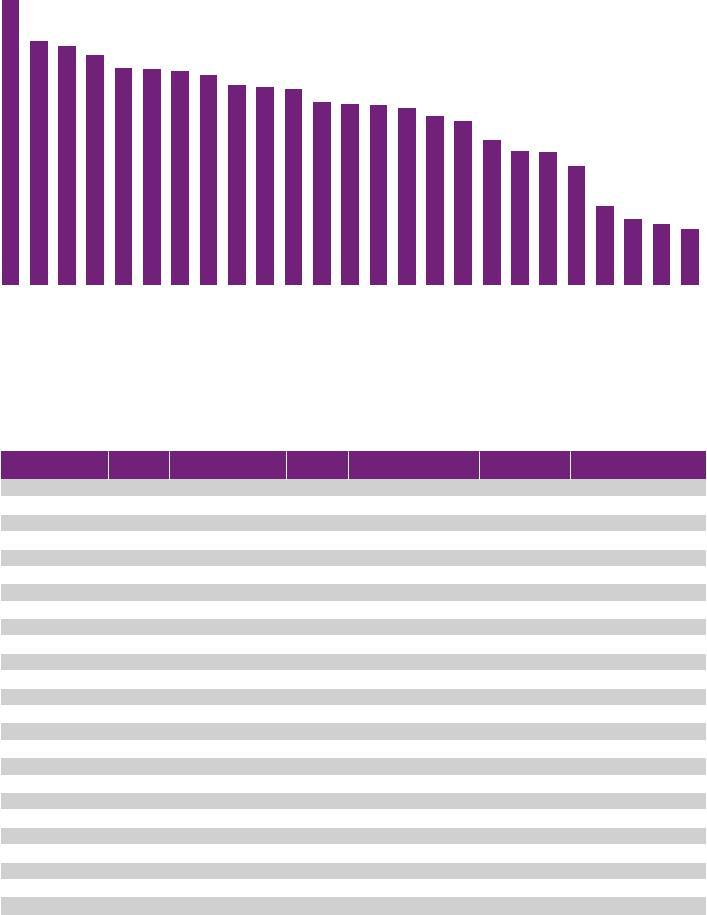
vk.com/id446425943
Pillar 3: aggregate scores by country
7.72 |
|
|
|
|
|
|
|
|
|
|
|
|
|
|
|
|
|
|
|
|
|
|
|
|
|
6.62 |
6.48 |
6.23 |
|
|
|
|
|
|
|
|
|
|
|
|
|
|
|
|
|
|
|
|
|
|
|
|
|
|
|
|
|
|
|
|
|
|
|
|
|
|
|
|
|
|
|
|
|
|
|
|
|
|
5.88 |
5.84 |
5.80 |
5.69 |
|
|
|
|
|
|
|
|
|
|
|
|
|
|
|
|
|
|
|
|
|
|
|
|
5.41 |
|
|
|
|
|
|
|
|
|
|
|
|
|
|
|
|
|
|
|
|
|
|
|
|
|
5.36 |
5.30 |
|
|
|
|
|
|
|
|
|
|
|
|
|
|
|
|
|
|
|
|
|
|
|
|
|
|
4.94 |
4.91 |
4.87 |
4.79 |
|
|
|
|
|
|
|
|
|
|
|
|
|
|
|
|
|
|
|
|
|
|
|
|
4.57 |
|
|
|
|
|
|
|
|
|
|
|
|
|
|
|
|
|
|
|
|
|
|
|
|
|
4.43 |
|
|
|
|
|
|
|
|
|
|
|
|
|
|
|
|
|
|
|
|
|
|
|
|
|
|
3.93 |
|
|
|
|
|
|
|
|
|
|
|
|
|
|
|
|
|
|
|
|
|
|
|
|
|
3.63 |
3.60 |
|
|
|
|
|
|
|
|
|
|
|
|
|
|
|
|
|
|
|
|
|
|
|
|
|
3.21 |
|
|
|
|
|
|
|
|
|
|
|
|
|
|
|
|
|
|
|
|
|
|
|
|
|
2.13 |
|
|
|
|
|
|
|
|
|
|
|
|
|
|
|
|
|
|
|
|
|
|
|
|
|
1.78 |
1.63 |
1.51 |
|
|
|
|
|
|
|
|
|
|
|
|
|
|
|
|
|
|
|
|
|
|
|
||
|
|
|
|
|
|
|
|
|
|
|
|
|
|
|
|
|
|
|
|
|
|
|
|
|
The Netherlands |
Singapore |
Japan |
South Korea |
United Arab Emirates |
Sweden |
Norway |
United States |
Australia |
Austria |
Finland |
United Kingdom |
Germany |
Spain |
France |
Canada |
New Zealand |
China |
Czech Republic |
Hungary |
Israel |
Mexico |
India |
Russia |
Brazil |
Pillar 3: (Infrastructure) normalized indicator values by country
Country |
EV charging |
GSMA global connectivity |
4G coverage |
Quality of roads from the WEF |
|
LPI infrastructure |
KPMG change readiness |
|
|
stations |
index — Infrastructure |
|
global competiveness index |
|
score |
technology infrastructure score |
|
|
|
|
|
|
|
|
|
|
The Netherlands |
1.000 |
0.772 |
0.756 |
0.933 |
|
0.899 |
0.784 |
|
|
|
|
|
|
|
|
|
|
Singapore |
0.090 |
1.000 |
0.640 |
0.994 |
|
0.805 |
0.882 |
|
|
|
|
|
|
|
|
|
|
Japan |
0.121 |
0.690 |
0.923 |
0.875 |
|
0.925 |
0.784 |
|
|
|
|
|
|
|
|
|
|
South Korea |
0.256 |
0.747 |
1.000 |
0.766 |
|
0.597 |
0.784 |
|
|
|
|
|
|
|
|
|
|
United Arab Emirates |
0.102 |
0.549 |
0.488 |
1.000 |
|
0.780 |
1.000 |
|
|
|
|
|
|
|
|
|
|
Sweden |
0.121 |
0.725 |
0.719 |
0.745 |
|
0.918 |
0.667 |
|
|
|
|
|
|
|
|
|
|
Norway |
0.523 |
0.887 |
0.853 |
0.445 |
|
0.572 |
0.588 |
|
|
|
|
|
|
|
|
|
|
United States |
0.044 |
0.649 |
0.780 |
0.445 |
|
0.799 |
0.706 |
|
|
|
|
|
|
|
|
|
|
Australia |
0.005 |
0.862 |
0.696 |
0.508 |
|
0.748 |
0.784 |
|
|
|
|
|
|
|
|
|
|
Austria |
0.039 |
0.675 |
0.396 |
0.835 |
|
0.881 |
0.745 |
|
|
|
|
|
|
|
|
|
|
Finland |
0.008 |
0.806 |
0.594 |
0.653 |
|
0.767 |
0.706 |
|
|
|
|
|
|
|
|
|
|
United Kingdom |
0.143 |
0.678 |
0.268 |
0.637 |
|
0.786 |
0.784 |
|
|
|
|
|
|
|
|
|
|
Germany |
0.157 |
0.700 |
0.122 |
0.709 |
|
1.000 |
0.588 |
|
|
|
|
|
|
|
|
|
|
Spain |
0.005 |
0.621 |
0.620 |
0.749 |
|
0.667 |
0.588 |
|
|
|
|
|
|
|
|
|
|
France |
0.064 |
0.643 |
0.195 |
0.857 |
|
0.767 |
0.667 |
|
|
|
|
|
|
|
|
|
|
Canada |
0.058 |
0.747 |
0.583 |
0.638 |
|
0.610 |
0.412 |
|
|
|
|
|
|
|
|
|
|
New Zealand |
0.007 |
0.819 |
0.216 |
0.482 |
|
0.761 |
0.667 |
|
|
|
|
|
|
|
|
|
|
China |
0.220 |
0.569 |
0.529 |
0.454 |
|
0.610 |
0.235 |
|
|
|
|
|
|
|
|
|
|
Czech Republic |
0.057 |
0.590 |
0.721 |
0.268 |
|
0.428 |
0.353 |
|
|
|
|
|
|
|
|
|
|
Hungary |
0.062 |
0.593 |
0.773 |
0.252 |
|
0.308 |
0.412 |
|
|
|
|
|
|
|
|
|
|
Israel |
0.033 |
0.406 |
0.094 |
0.574 |
|
0.346 |
0.686 |
|
|
|
|
|
|
|
|
|
|
Mexico |
0.046 |
0.294 |
0.433 |
0.429 |
|
0.044 |
0.176 |
|
|
|
|
|
|
|
|
|
|
India |
0.000 |
0.000 |
0.690 |
0.413 |
|
0.082 |
0.000 |
|
|
|
|
|
|
|
|
|
|
Russia |
0.003 |
0.187 |
0.105 |
0.067 |
|
0.000 |
0.725 |
|
|
|
|
|
|
|
|
|
|
Brazil |
0.003 |
0.420 |
0.000 |
0.000 |
|
0.094 |
0.490 |
|
Source: KPMG International, 2019 |
|
|
|
|
|
|
|
|
|
|
|
|
|
2019 Autonomous Vehicles Readiness Index |
49 |
||
© 2019 KPMG International Cooperative (“KPMG International”). KPMG International provides no client services and is a Swiss entity with which the independent member firms of the KPMG network are affiliated.

vk.com/id446425943


 Consumer
Consumer
acceptance
Overview
——Singapore scores highest overall, partly due to all of the city-state’s population living in an AV test area.
——Indians, closely followed by Mexicans, are the most accepting of AVs according to research carried out for this report with 100 people in each of the 25 countries. Britons then Americans are the least accepting.
——Sweden leads on technology change readiness, based on KPMG research, with the Netherlands leading a World Economic Forum index on technology readiness.
——China leads on market penetration of ride-hailing, followed by the US and the UK, based on data from Statista on the proportion of people who have used a ride-hailing app.
Methodology
The pillar is calculated from five equally weighted factors, with consumer opinions added for this version of the AVRI and ride-hailing market penetration moved from the technology and innovation pillar.
Consumer opinions of AVs: Branded Research144 asked 100 people from online panels in each of the 25 countries to respond to the following question: “What is your general opinion of autonomous vehicles?” Branded Research actively adjusts
its overall audience and recruitment process to ensure that the natural fallout on consumer studies is generally representative of each country, with
a minimal margin of error. Branded Research conducted its research in September 2018 for 24 of the 25 countries, and in India in October 2018. More positive opinions produce higher scores, reflecting the importance of public acceptance of AVs as to whether they will be adopted. Respondents in India, Mexico and the UAE were
the most enthusiastic with those in the UK, the US and Canada the least.
Population living in test areas: this measure uses data on cities carrying out AV testing collected by Bloomberg Philanthropies and Aspen Institute.145 The proportion of national populations living in test areas is then calculated based on city populations from the McKinsey Global Institute’s Urban World app.146 The more people see AVs on the road,
the more comfortable that they are likely to use them when they become available, so countries with a higher proportion of population that live in cities where AV pilots and testing are underway scored the highest. The countries with the highest proportions are Singapore, the Netherlands and Canada. There are currently no AV testing areas in Austria, Hungary, India and Mexico.
Civil society technology use: scores are based on this sub-indicator of KPMG International’s 2017 Change readiness index, updated for 2018.147 This is included as the use of other types of consumer technology indicates the potential for consumers to embrace AVs. The leading countries are Sweden, the Netherlands and Norway while the lowestscoring are India, Brazil and Russia.
Consumer adoption of technology: scored using the World Economic Forum’s Global competiveness report, which includes the availability of latest technologies, mobile broadband subscriptions, internet access and internet bandwidth.148 The top countries are the Netherlands, the UK and Sweden while India, China and Mexico score the lowest.
Online ride-hailing market penetration: a new measure using data from Statista149 on the percentage of people in each country who have used a ride-hailing service. Statista conducts
nationally representative surveys in each country. People in China, the US and the UK are most likely to have used such a service, while those in India, Japan and Hungary are least likely to have done so.
502019 Autonomous Vehicles Readiness Index
©2019 KPMG International Cooperative (“KPMG International”). KPMG International provides no client services and is a Swiss entity with which the independent member firms of the KPMG network are affiliated.
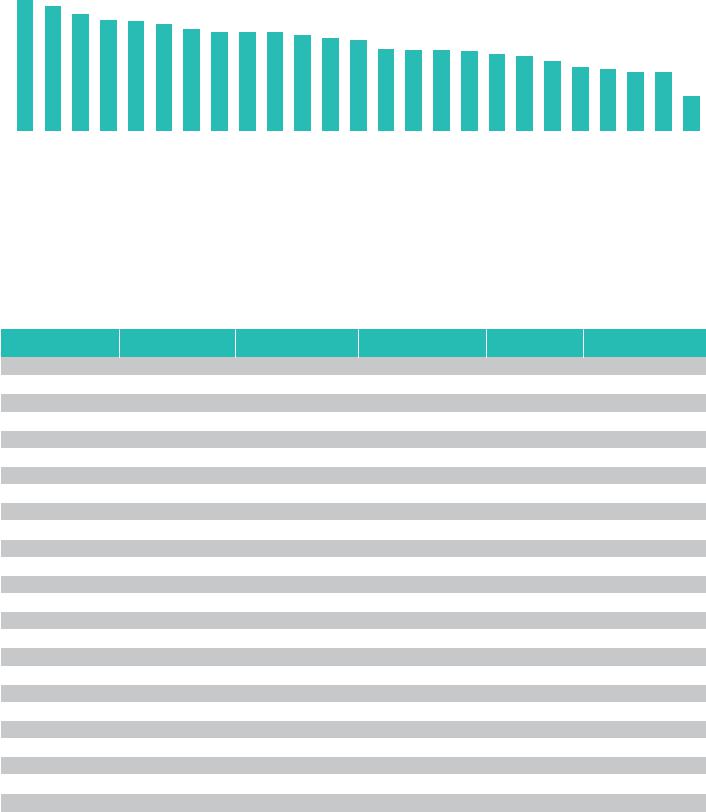
vk.com/id446425943
Pillar 4: aggregate scores by country
6.87 |
6.58 |
|
|
|
|
|
|
|
|
|
|
|
|
|
|
|
|
|
|
|
|
|
|
|
|
|
|
|
|
|
|
|
|
|
|
|
|
|
|
|
|
|
|
|
6.11 |
5.81 |
5.78 |
5.59 |
|
|
|
|
|
|
|
|
|
|
|
|
|
|
|
|
|
|
|
5.36 |
|
|
|
|
|
|
|
|
|
|
|
|
|
|
|
|
|||
|
|
|
|
5.18 |
5.18 |
5.17 |
5.04 |
|
|
|
|
|
|
|
|
|
|
|
|
||
|
|
|
|
|
4.84 |
|
|
|
|
|
|
|
|
|
|
|
|||||
|
|
|
|
|
|
4.75 |
|
|
|
|
|
|
|
|
|
|
|||||
|
|
|
|
|
|
|
|
|
|
|
|
|
|
|
|
|
|
|
|
||
|
|
|
|
|
|
|
|
|
|
|
4.28 |
4.21 |
4.20 |
4.18 |
4.03 |
3.93 |
3.64 |
|
|
|
|
|
|
|
|
|
|
|
|
|
|
|
|
|
|
|
|
|
|
|
|||
|
|
|
|
|
|
|
|
|
|
|
|
|
|
|
|
|
3.34 |
3.21 |
3.06 |
3.05 |
|
|
|
|
|
|
|
|
|
|
|
|
|
|
|
|
|
|
|
|
|
|
1.80 |
Singapore |
The Netherlands |
Norway |
Sweden |
Finland |
United States |
United Arab Emirates |
Israel |
New Zealand |
United Kingdom |
Canada |
Australia |
Germany |
China |
France |
Austria |
Spain |
Japan |
South Korea |
Czech Republic |
Mexico |
Brazil |
Hungary |
Russia |
India |
Pillar 4: (Consumer acceptance) normalized indicator values by country
Country |
Consumer survey data on |
Percent of population living |
KPMG change readiness |
WEF technology |
Ridesharing market |
|
AV acceptance |
in test areas |
technology use sub index |
readiness (GCI) |
penetration |
|
|
|
|
|
|
Singapore |
0.654 |
1.000 |
0.832 |
0.921 |
0.408 |
|
|
|
|
|
|
The Netherlands |
0.466 |
0.775 |
0.985 |
1.000 |
0.429 |
|
|
|
|
|
|
Norway |
0.599 |
0.339 |
0.960 |
0.931 |
0.565 |
|
|
|
|
|
|
Sweden |
0.466 |
0.351 |
1.000 |
0.987 |
0.424 |
|
|
|
|
|
|
Finland |
0.489 |
0.288 |
0.929 |
0.888 |
0.614 |
|
|
|
|
|
|
United States |
0.103 |
0.355 |
0.852 |
0.966 |
0.832 |
|
|
|
|
|
|
United Arab Emirates |
0.968 |
0.219 |
0.787 |
0.835 |
0.168 |
|
|
|
|
|
|
New Zealand |
0.529 |
0.282 |
0.886 |
0.922 |
0.261 |
|
|
|
|
|
|
Israel |
0.489 |
0.524 |
0.559 |
0.947 |
0.359 |
|
|
|
|
|
|
United Kingdom |
0.000 |
0.298 |
0.924 |
0.995 |
0.652 |
|
|
|
|
|
|
Canada |
0.201 |
0.670 |
0.848 |
0.856 |
0.223 |
|
|
|
|
|
|
Australia |
0.372 |
0.366 |
0.884 |
0.806 |
0.261 |
|
|
|
|
|
|
Germany |
0.372 |
0.133 |
0.932 |
0.946 |
0.255 |
|
|
|
|
|
|
China |
0.783 |
0.043 |
0.222 |
0.330 |
1.000 |
|
|
|
|
|
|
France |
0.364 |
0.209 |
0.685 |
0.862 |
0.217 |
|
|
|
|
|
|
Austria |
0.348 |
0.000 |
0.792 |
0.884 |
0.310 |
|
|
|
|
|
|
Spain |
0.693 |
0.000 |
0.571 |
0.793 |
0.266 |
|
|
|
|
|
|
Japan |
0.442 |
0.301 |
0.505 |
0.895 |
0.098 |
|
|
|
|
|
|
South Korea |
0.725 |
0.020 |
0.362 |
0.784 |
0.293 |
|
|
|
|
|
|
Czech Republic |
0.560 |
0.000 |
0.529 |
0.738 |
0.196 |
|
|
|
|
|
|
Mexico |
0.992 |
0.000 |
0.225 |
0.339 |
0.299 |
|
|
|
|
|
|
Brazil |
0.834 |
0.103 |
0.174 |
0.450 |
0.223 |
|
|
|
|
|
|
Hungary |
0.591 |
0.000 |
0.346 |
0.613 |
0.147 |
|
|
|
|
|
|
Russia |
0.866 |
0.000 |
0.176 |
0.444 |
0.207 |
|
|
|
|
|
|
India |
1.000 |
0.000 |
0.000 |
0.000 |
0.000 |
|
|
|
|
|
|
Source: KPMG International, 2019
2019 Autonomous Vehicles Readiness Index 51
© 2019 KPMG International Cooperative (“KPMG International”). KPMG International provides no client services and is a Swiss entity with which the independent member firms of the KPMG network are affiliated.
vk.com/id446425943
Endnotes
1‘Honda Joins with Cruise and General Motors to Build New Autonomous Vehicle’, Honda News, 3 October 2018: http://hondanews. com/releases/honda-joins-with-cruise-and- general-motors-to-build-new-autonomous- vehicle and ‘Ford Creates ‘Ford Autonomous Vehicles LLC’; Strengthens Global Organization to Accelerate Progress, Improve Fitness’, Ford Media Center, 24 July 2018: https://media.ford.com/content/fordmedia/ fna/us/en/news/2018/07/24/ford-creates-ford- autonomous-vehicles-llc.html
2Global status report on road safety 2018, World Health Organization, December 2018. https://www.who.int/violence_injury_ prevention/road_safety_status/2018/en/
3‘Human error as a cause of vehicle crashes’, Bryant Walker Smith, Center for Internet and Society at Stanford Law School, 18 December 2013: https://cyberlaw.stanford. edu/blog/2013/12/human-error-cause-vehicle- crashes
4‘Uber halts autonomous car tests after fatal crash in Arizona’, Mark Bergen and Eric Newcomer, Bloomberg, 19 March 2018: https://www.bloomberg.com/news/ articles/2018-03-19/uber-autonomous-car- involved-in-fatal-crash-in-arizona and ‘Tesla's
Autopilot Was Involved in Another Deadly Car Crash’, Jack Stewart, Wired, 30 March 2018: https://www.wired.com/story/tesla-autopilot- self-driving-crash-california/
5‘2017 safest year on record for commercial passenger air travel: groups’, David Shepardson, Reuters, 1 January 2018: https://www.reuters. com/article/us-aviation-safety/2017-safest-year- on-record-for-commercial-passenger-air-travel- groups-idUSKBN1EQ17L
6‘Autonomy delivers: An oncoming revolution in the movement of goods,’ KPMG LLP, November 2018: https://advisory.kpmg.us/content/dam/ advisory/en/pdfs/2018/autonomy-delivers-final- secured-web.pdf
7‘New survey data reveals increases in driver compensation’, AmericanTrucking Association, 27 March 2018: https://www.trucking.org/ article/New-Survey-Data-Reveals-Increases-in- Driver-Compensation
8The automobile industry pocket guide 201819, European Automobile Manufacturers Association: https://www.acea.be/ publications/article/acea-pocket-guide
9‘UK and seven major companies join campaign for vehicle electrification’, International Energy Agency, 11 September 2018: https://www.iea.org/newsroom/ news/2018/september/uk-and-seven- major-companies-join-campaign-for-vehicle- electrification.html
10‘Reinventing the wheel’, Economist Intelligence Unit, June 2018: https:// innovationmatters.economist.com/ reinventing-the-wheel-moving-eiu
11Marketplace of change: automobile insurance in the era of autonomous vehicles, KPMG in the US, October 2015: https://assets.kpmg.com/content/dam/ kpmg/pdf/2016/06/id-market-place-of- change-automobile-insurance-in-the-era-of- autonomous-vehicles.pdf
12‘UK motor insurance market could shrink up to 41% by 2040 — Bank of England’, Louie Bacani, Insurance
Business, 20 March 2017: https://www. insurancebusinessmag.com/uk/news/ technology/uk-motor-insurance-market- could-shrink-up-to-41-by-2040--bank-of- england-63108.aspx
13‘Lov om utprøving av selvkjørende kjøretøy’ (text of new law in Norwegian), Lovdata Foundation: https://lovdata.no/dokument/NL/ lov/2017-12-15-112
14‘Driverless car tests roll out on south China streets’, Charles Clover, Yuan Yang and Sherry Fei Ju, Financial Times, 5 February 2018: https://www.ft.com/content/8481ee48- 0975-11e8-8eb7-42f857ea9f09
15‘Toespraak van minister Van Nieuwenhuizenbij de opening van de Intertraffic Beurs‘, speech by Cora Van Nieuwenhuizen (in English), Government of the Netherlands, 26 March 2018: https://www.rijksoverheid.nl/regering/ bewindspersonen/cora-van-nieuwenhuizen/ documenten/toespraken/2018/03/26/ speech-by-cora-van-nieuwenhuizen-minister- of-infrastructure-and-water-management-at- the-opening-of-intertraffic-amsterdam-20- march-2018
16‘Uber halts autonomous car tests after fatal crash in Arizona’ as above.
17‘California scraps safety driver rules for self-driving cars’, Daisuke Wakabayashi, NewYorkTimes, 26 February 2018: https:// www.nytimes.com/2018/02/26/technology/ driverless-cars-california-rules.html
18‘EU motors ahead with rules for self-driving cars’, Peter Campbell, FinancialTimes, 14 May 2018: https://www.ft.com/content/f3a76e4c- 5772-11e8-b8b2-d6ceb45fa9d0
19‘Japan looks to launch driverless car system inTokyo by 2020’, Stanley White, Reuters,
4 June 2018: https://www.reuters.com/article/ us-japan-economy-strategy/japan-looks-to- launch-driverless-car-system-in-tokyo-by-2020- idUSKCN1J00VN
20‘Ford Creates ‘Ford Autonomous Vehicles LLC’; Strengthens Global Organization to Accelerate Progress, Improve Fitness’, Ford Media Center, 24 July 2018: https:// media.ford.com/content/fordmedia/fna/ us/en/news/2018/07/24/ford-creates-ford- autonomous-vehicles-llc.html
21‘Uber’s Vision of Self-Driving Cars Begins to Blur’, Mike Isaac, Daisuke Wakabayashi and Kate Conger, 19 August 2018, NewYork
Times: https://www.nytimes.com/2018/08/19/ technology/uber-self-driving-cars.html
22Automated and electric vehicles act 2018,
House of Commons library, 15 August 2018: https://researchbriefings.parliament.uk/ ResearchBriefing/Summary/CBP-8118
23‘Yandex launches the first autonomous ridehailing service in Europe’,Yandex, 28 August 2018: https://yandex.com/company/blog/ yandex-launches-the-first-autonomous-ride- hailing-service-in-europe
24‘Alphabet’s Waymo begins charging passengers for self-driving cars’,Tim Bradshaw and Richard Waters, Financial Times, 26 October 2018: https://www. ft.com/content/7980e98e-d8b6-11e8-a854- 33d6f82e62f8
25‘Office of FutureTransportTechnologies revealed’, Australian deputy prime minister, 4 October 2018: http://minister.infrastructure. gov.au/mccormack/releases/2018/october/ mm178_2018.aspx
26‘Ford, Walmart and Postmates team up for self-driving goods delivery’, Brian Wolf, Ford, 14 November 2018: https://media.ford.com/ content/fordmedia/fna/us/en/news/2018/11/14/ ford--walmart-and-postmates-team-up-for- self-driving-goods-deliv.html and Custom Autonomous Cargo Vans to Deliver Groceries in Walmart’s Pilot with Udelv, Walmart, January 2019: https://news.walmart. com/2019/01/08/custom-autonomous-cargo- vans-to-deliver-groceries-in-walmarts-pilot- with-udelv
27‘Electric driverless truck set to gain approval for public roads’, Patrick McGee, Financial Times, 2 December 2018: https://www. ft.com/content/f76ef090-f47f-11e8-ae55- df4bf40f9d0d
28‘Toespraak van minister Van Nieuwenhuizenbij de opening van de Intertraffic Beurs‘ as above
29‘Self-driving vehicles’ (in English), Government of the Netherlands: https://www.government. nl/topics/mobility-public-transport-and-road- safety/self-driving-vehicles
30‘VDL scoort miljoenenorders voor productie zelfrijdende voertuigen’ (in Dutch), Het Financieele Dagblad, 24 October 2017: https://fd.nl/ondernemen/1224174/vdl-scoort- miljoenenorders-voor-productie-zelfrijdende- voertuigen
31‘NTU, LTA and JTC unveil Singapore’s first autonomous vehicle test centre’, Land Transport Authority, 22 November 2017: https://www.lta.gov.sg/apps/news/page. aspx?c=2&id=10ceddae-472a-4920-8d4c- e73babfcecb0
32‘A self-driving shuttle bus will hit the road at NUS from March next year — here’s what you need to know’, Sean Lim, 12 November 2018,
Business Insider Singapore: https://www. businessinsider.sg/a-self-driving-shuttle-bus- will-hit-the-road-at-nus-from-march-next-year- heres-what-you-need-to-know/
522019 Autonomous Vehicles Readiness Index
©2019 KPMG International Cooperative (“KPMG International”). KPMG International provides no client services and is a Swiss entity with which the independent member firms of the KPMG network are affiliated.
vk.com/id446425943
33‘Dyson chooses Singapore over Britain to build electric car’, Paul Sandle, Reuters, 23 October 2018: https://www.reuters.com/ article/us-britain-dyson-singapore/dyson- chooses-singapore-over-britain-to-build-electric- car-idUSKCN1MX2MO
34‘Lov om utprøving av selvkjørende kjøretøy’ as above
35‘Autonomous future at Forus’, Kolumbus: https://www.kolumbus.no/en/news-archive/ autonomous-future-at-forus/
36‘Scandinavia gets its first autonomous public buses, but there's a big catch’, Stig Øyvann, ZDNet, 18 May 2018: https://www.zdnet.com/ article/scandinavia-gets-its-first-autonomous- public-buses-but-theres-a-big-catch/
37‘Autonomous vehicles: expect up to 50 driverless buses on Oslo streets by 2021’, Stig Øyvann, ZDNet, 23 October 2018: https://www.zdnet.com/article/autonomous- vehicles-expect-up-to-50-driverless-buses-on- oslo-streets-by-2021/
38Applied Autonomy website: https://www. appliedautonomy.no/en/home/
39‘Ta en selvkjørende buss til stranden i sommer!’ (‘Take a self-drive bus to the beach this summer!’), Acando Oslo: https:// www.acando.no/hva-vi-tror-pa/smart-city/ selvkjorende-buss-pa-fornebu/
40Preparing for the future of transportation: automated vehicles 3.0, US Department of Transportation, 4 October 2018: https://www. transportation.gov/av/3
41‘News’, DriveOhio: https://www.driveohio.org/ news/
42Michigan Economic Development Corporation: https://www.michiganbusiness. org/
43‘Gov Charlie Baker signs Massachusetts electric vehicle bill into law’, Shira Schoenberg, MassLive, 13 January 2017: https://www. masslive.com/politics/index.ssf/2017/01/gov_ charlie_baker_signs_massachusetts_electric_ vehicle_bill_into_law.html
44Connected and Automated Vehicle Program, Virginia Department ofTransportation, 2018: http://www.virginiadot.org/programs/ connected_and_automated_vehicles.asp
45‘World's first electrified public road opens in Sweden’, The Local, 13 April 2018: https:// www.thelocal.se/20180413/worlds-first- electric-road-opens-in-sweden
46‘Stockholm gets Scandinavia's first driverless buses on public road’, Emma Löfgren, The Local, 27 December 2017: https://www.thelocal.se/20171227/ stockholm-gets-scandinavias-first- driverless-buses-on-public-road
47‘Volvo's self-driving cars will soon hit the streets in Sweden’, The Local, 14 September 2018: https://www.thelocal.se/20180914/ volvos-self-driving-cars-will-soon-hit-the-road- in-sweden
48‘Electric driverless truck set to gain approval for public roads’, as above.
49‘Martti, developed for adverse weather conditions, is the first Finnish robot car to challenge snow and ice’, VTT, 15 December 2017: https://www.vttresearch.com/media/ news/martti-developed-for-adverse-weather- conditions-is-the-first-finnish-robot-car-to- challenge-snow-and-ice and ‘VTT’s robot car, Martti, now “speaks 5G” and takes another step towards full automation’, VTT, 20 August 2018: https://www.vttresearch.com/media/ news/vtt%E2%80%99s-robot-car-martti-now- speaks-5g-and-takes-another-step-towards-full- automation
50’Nordic conditions drive automated vehicles to the Finnish line’, Good News Finland, 9 August 2017: http://www.goodnewsfinland. com/feature/nordic-conditions-drive- automated-vehicles-to-finnish-line/
51‘Driverless buses take visitors to the Kivistö Housing Fair from 10 July’, HSL, 8 July 2015: https://www.hsl.fi/en/news/2015/driverless- buses-take-visitors-kivisto-housing-fair-10- july-6904
52‘Self-driving bus on Helsinki RobobusLine goes to scheduled service’, City of Helsinki, 15 May 2018: https://www.hel.fi/uutiset/ en/helsinki/robobus-line-goes-to-scheduled- service
53‘Muji and Sensible 4 created Gacha – the first autonomous shuttle bus in the world for all weather conditions’, Sensible 4, Epressi, 31 October 2018: https://www.dezeen. com/2018/11/02/muji-sensible-4-gacha- autonomous-shuttle-bus-finland-driverless- design/
54‘Anyone can be a cabbie — new law transforms Finnish taxi trade’, YLE, 1 July 2018: https://yle.fi/uutiset/osasto/news/ anyone_can_be_a_cabbie__new_law_ transforms_finnish_taxi_trade/10283444
55‘The new RoadTraffic Act aims for a safer future’, Ministry ofTransport and Communications, Finnish Government,
23 November 2017: https://valtioneuvosto.fi/ en/article/-/asset_publisher/uusi-tieliikennelaki- tahtaa-turvallisempaan-tulevaisuuteen
56Automated and electric vehicles act 2018
57From science fiction to reality: people in London and Edinburgh set to be the first to trial self-driving vehicle servicesí, UK Department for Business, Energy and Industrial Strategy, 22 November 2018:
https://www.gov.uk/government/news/from- science-fiction-to-reality-people-in-london- and-edinburgh-set-to-be-the-first-to-trial-self- driving-vehicle-services
58https://publications.parliament.uk/pa/ cm201719/cmselect/cmtrans/590/reportoverview.html
59https://www.lawcom.gov.uk/project/ automated-vehicles/
60https://www.gov.uk/government/news/new- cyber-security-standard-for-self-driving-vehicles
61‘Federal Government adopts action plan on automated driving’, Federal Ministry of
Transport and Digital Infrastructure, 28 August 2017: https://www.bmvi.de/SharedDocs/ EN/publications/strategy-for-automated-and- connected-driving.pdf
62‘Autonomous driving levels 0 to 5: Understanding the differences’, Hope Reese, TechRepublic, 20 January 2016: https://www. techrepublic.com/article/autonomous-driving- levels-0-to-5-understanding-the-differences/
63‘Germany launches task force to kickstart shift to sustainable mobility’, Sören Amelang, Clean Energy Wire, 19 September 2018: https:// www.cleanenergywire.org/news/germany- launches-task-force-kickstart-shift-sustainable- mobility
64‘Mobility for people’, Zukunftsnetz Mobilität NRW: https://www.zukunftsnetz-mobilitaet. nrw.de/sites/default/files/downloads/znm-nrw- infoflyer_znm_din-lang-en_x3-3.pdf
65‘Mohammed bin Rashid approves Dubai AutonomousTransportation Strategy’, Government of Dubai, 25 April 2016: https:// www.dubaifuture.gov.ae/mohammed- bin-rashid-approves-dubai-autonomous- transportation-strategy/
66‘Road to safety: Self-driving cars in the Middle East’, Alicia Buller, Computer Weekly 10 November 2016: https://www. computerweekly.com/news/450402609/
Road-to-safety-Self-driving-cars-in-the-Middle- East
67‘Smart Dubai and IBM to offer first government-endorsed blockchain platform’, Smart Dubai, 30 October 2018: https://smartdubai.ae/newsroom/news- details/2018/10/30/smart-dubai-and-ibm-to- offer-first-government-endorsed-blockchain- platform
68‘Masdar City launches autonomous shuttle’, Gulf News, 22 October 2018: https:// gulfnews.com/uae/transport/masdar-city- launches-autonomous-shuttle-1.2292558
69‘Japan looks to launch driverless car system in Tokyo by 2020’ as above.
70‘Driverless shuttle company signs $20m deal with Chinese’, Chris Hutching, Stuff, 21 June 2018: https://www.stuff.co.nz/ business/104824042/driverless-shuttle- company-signs-20m-production-deal-with- chinese
2019 Autonomous Vehicles Readiness Index 53
© 2019 KPMG International Cooperative (“KPMG International”). KPMG International provides no client services and is a Swiss entity with which the independent member firms of the KPMG network are affiliated.
vk.com/id446425943
71‘Ambitious plan to use Christchurch red zone for autonomous vehicle tests’, Michael Hayward, Stuff, 2 November 2018: https://www.stuff. co.nz/business/108296150/Ambitious-plan-to- use-Christchurch-red-zone-for-autonomous- vehicle-tests
72‘Air taxi trials possible in six years as tech company trials flying vehicle in Canterbury’, Michael Hayward, Stuff, 13 March 2018: https://www.stuff.co.nz/
technology/102203642/air-taxi-trials-possible- in-six-years-as-tech-company-trials-flying- vehicle-in-canterbury
73‘Testing autonomous vehicles in New Zealand’, NZTransport Agency: https:// www.nzta.govt.nz/vehicles/vehicle-types/ automated-and-autonomous-vehicles/testing- autonomous-vehicles-in-new-zealand/
74‘Ontario Government Supports Innovation and Growth in Automated Vehicle Industry’, Ontario Ministry of Transport, 22 January 2019: https://news.ontario.ca/mto/ en/2019/01/ontario-government-supports- innovation-and-growth-in-automated- vehicle-industry.html
75Autonomous Vehicle Innovation Network: https://www.avinhub.ca/ and ‘Automotive Supplier Competitiveness Improvement Program’, Ontario Centres of Excellence: https://www.oce-ontario.org/programs/ commercialization/automotive-supplier- competitiveness-improvement-program- ascip
76Autonomous vehicles and the future of work in Canada, Information and Communications Technology Council, August 2018: https://www.ictc-ctic.ca/ wp-content/uploads/2018/01/ICTC_-
Autonomous-Vehicles-and-The-Future-of- Work-in-Canada-1-1.pdf
77‘Korea builds urban infrastructure for testing autonomous vehicles’, Jun Ji-hye, KoreaTimes, 10 December 2018: http://www.koreatimes. co.kr/www/tech/2018/12/133_260137.html
78‘KT tests driverless bus at Korean airport’, Cho Mu-Hyun, ZDNet, 20 November 2018:
https://www.zdnet.com/article/kt-tests-driverless- bus-at-korean-airport/
79‘New SmartTraffic System to Enhance Safety of Autonomous Cars’, KBS World Radio, 27 March 2018: http://world.kbs.co.kr/service/ news_view.htm?lang=e&Seq_Code=135015
80‘Samsung Reveals DRVLINE™ Platform, Takes Bold StepToward Autonomous Future’, Samsung, 1 August 2018: https://news. samsung.com/us/samsung-reveals-drvline- platform-autonomous-future/
81Issues Related to Regulation Reforms to Activate Autonomous Vehicle Industry”, IITP, 7 September 2018: https://www. iitp.kr/kr/1/notice/reportAndClarify/view. it?ArticleIdx=3222&count=true
82‘Intel buys Mobileye in $15.3 billion bid to lead self-driving car market’, Mark Scott, NewYork Times, 13 March 2017: https://www.nytimes. com/2017/03/13/business/dealbook/intel- mobileye-autonomous-cars-israel.html
83‘Daimler and Mizmaa Ventures co-lead round B at Anagog’, Anagog, 27 February 2018: https://www.anagog.com/project/ daimler-mizmaa-ventures-co-lead-round- b-anagog-mobility-status-ai-innovator/, ‘BP invests in ultra-fast charging battery company StoreDot’, BP, 22 May 2018: https://www.bp.com/en/global/corporate/ media/press-releases/bp-invests-in-ultra- fast-charging-battery-company-storedot. html and ‘SoftWheel is Delighted to Announce Investment by Mitsubishi
Corporation’, Business Wire, 27 September 2018: https://www.businesswire. com/news/home/20180927005303/ en/SoftWheel-Delighted-Announce- Investment-Mitsubishi-Corporation
84Automated vehicles in Australia, National Transport Commission: https://www.ntc.gov. au/roads/technology/automated-vehicles-in- australia/
85‘Office of FutureTransportTechnologies revealed’ as above
86‘NSW Budget caters for the future of driverless cars’,Transport for NSW, 18 June 2018: https://www.transport.nsw.gov.au/ news-and-events/media-releases/nsw- budget-caters-for-future-of-driverless-cars and 'Automated Vehicles GetThe Green Light', Minister for Roads and Road Safety, 23 February 2018: https://www.premier.vic.gov. au/automated-vehicles-get-the-green-light/
87Connected and automated vehicles, Austroads, 22 August 2018: https:// austroads.com.au/drivers-and-vehicles/ connected-and-automated-vehicles 'Connected and automated vehicles (CAV) open data Recommendations', Austroads, 23 August 2018: https://austroads.com.au/ publications/connected-and-automated- vehicles/ap-r581-18; and 'Webinar: operations of automated heavy vehicles in remote and regional areas', Austroads, 25 September 2018: https://austroads.com.au/ publications/freight/web-r579-18
88'Victorian connected and automated vehicle trials',Transurban: https://cavs.transurban. com/content/dam/cavs/documents/victorian- trials-report.pdf
89'Round Australia electric highway', Tesla Owners Australia: https://www.teslaowners. org.au/round-australia
90'Advice on automated and zero emissions vehicles infrastructure', Infrastructure Australia, October 2018: http://www. infrastructurevictoria.com.au/sites/ default/files/files/AVZEV/Advice%20 on%20automated%20and%20zero%20 emissions%20vehicles%20-%20 October%202018.PDF
91‘Slovenia, Austria, Hungary to create driverless region’, SloveniaTimes, 25 March 2018: http:// www.sloveniatimes.com/slovenia-austria- hungary-to-create-driverless-region
92Action Programm on Automated Mobility 2019-2022: https://www.bmvit.gv.at/en/ service/publications/downloads/action_ automated_mobility_2019-2022_ua.pdf
93ALP.Lab, 26 June 2018: https://www.alp-lab. at/2018/07/03/26-06-2018/
94‘BMW starts cooperation withTTTech Auto for developing automated driving functions at the highest safety level’.TTTech Auto, 5 November 2018: https://www.tttech-auto. com/press/bmw-starts-cooperation-with- tttech-auto-for-developing-automated-driving- functions-at-the-highest-safety-level/ and ‘SAIC andTTTech Establish Joint Venture in Shanghai to Deploy the “Smart Brain” for Autonomous Driving Cars in China’,TTTech
Auto, 14 March 2018: https://www.tttech-auto. com/press/saic-and-tttech-establish-joint- venture-in-shanghai-to-deploy-the-smart-brain- for-autonomous-driving-cars-in-china/
95‘Driverless shuttles on test in La Défense’,
Metro Report International, 5 July 2017: https://www.metro-report.com/news/single- view/view/driverless-shuttles-on-test-in-la- defense.html
96‘World premiere in Lyon’, Keolis, 2 September 2016: https://www.keolis.com/en/media/ press-releases/world-premiere-lyon
97‘Development of autonomous vehicles — strategic orientations for public
action’ (summary in English), French Government, May 2018: https://www. ecologique-solidaire.gouv.fr/sites/default/ files/18029_D%C3%A9veloppement- VA_8p_EN_Pour%20BAT-3.pdf
98‘Renault’s EZ-GO robot taxi is the most socially responsible concept in Geneva’,Vlad Savov, The Verge, 8 March 2018: https://www.theverge. com/2018/3/8/17097016/renault-ez-go-robot-taxi- geneva-motor-show-2018
99Faurecia: http://www.faurecia.com/en and Valeo: https://www.valeo.com/en/
100‘Arranca la Plataforma de Vehículo Conectado 3.0’ (in Spanish), ABC, 16 November 2018: https://www.abc.es/motor/ reportajes/abci-arranca-plataforma-vehiculo- conectado-30-201811121517_noticia.html
101‘Barcelona introduces Mobileye to city streets’ Mobileye, 5 December 2017: https://www. mobileye.com/en-uk/2017/12/05/barcelona- introduces-mobileye-city-streets/
102Auto C-its: https://www.autocits.eu/
103‘Successful tests mark important milestone towards a 5G future’, Lancaster University, 10 October 2018: http://www.lancaster. ac.uk/news/successful-tests-mark-important- milestone-towards-a-5g-future
542019 Autonomous Vehicles Readiness Index
©2019 KPMG International Cooperative (“KPMG International”). KPMG International provides no client services and is a Swiss entity with which the independent member firms of the KPMG network are affiliated.
vk.com/id446425943
104 ‘BMW to build Czech test track for self-driving cars’, Andreas Cremer, Reuters, 15 December 2017: https://www.reuters.com/article/us- bmw-czech-investment-idUSKBN1E90Y5
105 ‘Draft bill facilitates autonomous car usage in the Czech Republic’,Tomáš Matejovský and Petr Beneš, Lexology, 20 June 2018: https://www.lexology.com/library/detail. aspx?g=e4bb3c1a-3c28-4aeb-8741- 13f3a712e77a
106 ‘Driverless car tests roll out on south China streets’ as above.
107 ‘Baidu launches public road tests of autonomous cars in China’, Charles Clover, Emily Feng and Sherry Fei Ju, 23 November 2017, FinancialTimes: https://www.ft.com/ content/8c506d06-d02d-11e7-b781- 794ce08b24dc
108 ‘KPMG releases the leading AutoTech 50 List in China for the first time’, 28 March 2018, KPMG China: https://home.kpmg.com/cn/en/ home/news-media/press-releases/2018/03/ the-leading-autotech-50-list-in-china.html
109RoboSense: https://www.robosense.ai/, Surestar: http://www.isurestar.com/index. php/en-Index.html and Horizon Robotics: http://en.horizon.ai/
110Automotive Proving Ground Zala: https:// zalazone.hu/en/
111AImotive: https://aimotive.com/
112‘BMW Group to expand production network in Europe’, 31 July 2018, BMW Group. https://www.bmwgroup-plants.com/ debrecen/en/aktuelles/new-plant.html
113‘Slovenia, Austria, Hungary to create driverless region’ as above
114‘Yandex.taxi’s self-driving car conducts winter testing on Moscow’s public streets’,Yandex, 16 February 2018: https://yandex.com/ company/blog/self-driving-city/
115‘Yandex launches the first autonomous ridehailing service in Europe’ as above
116‘Russia to rapidly scale 5G following launch of first 5G networks in 2020, finds new GSMA study’, Associated Press, 30 October 2018: https://www.apnews.com/5dfe72f2543a49d e977a2ca99a7e1a82
117‘Mexican auto parts makers see new trade deal boosting output’, Sharay Angulo and Anthony Esposito, Reuters, 2 October 2018: https://www.reuters.com/article/us-trade-nafta- autoparts/mexican-auto-parts-makers-see-new- trade-deal-boosting-output-idUSKCN1MB3XU
118‘Mexico grows as world leader on energy reform and renewables’, Mary DeFilippe,
Renewable Energy World, 11 April 2018: https://www.renewableenergyworld.com/ ugc/articles/2018/03/01/mexico-reform-and- renewables.html
119‘Stuck in traffic, Indians are desperate for selfdriving cars’, SuneeraTandon, Quartz India, 18 July 2018: https://qz.com/india/1329942/ indians-are-desperate-for-autonomous-cars/
120‘Metro 3 to get made in India driverless trains’, ChittaranjanTembhekar, Times of India, 20 July 2018: https://timesofindia.indiatimes. com/city/mumbai/metro-3-to-get-made-in- india-driverless-trains/articleshow/65061055. cms
121‘9 Startups In India Working On Self Driving Technology’, Srishti Deoras, Analytics India, 28 November 2017: https://www. analyticsindiamag.com/9-startups-india- working-self-driving-technology/
122‘Revv partners with Mobileye to make its cars safer’, ANI, 1 November 2017: https:// www.aninews.in/news/business/business/ revv-partners-with-mobileye-to-make-its-cars- safer201711011616160003/
123‘Brazil approves tax breaks for Ford, Fiat, other automakers’, Maria Carolina Marcello, Reuters, 9 November 2018: https:// uk.reuters.com/article/uk-brazil-autos/ brazil-approves-tax-breaks-for-ford-fiat-other- automakers-idUKKCN1ND32L
124‘Intelligent Autonomous Robotic Automobile’, Laboratório de Computação de Alto Desempenho, Federal University of Espírito Santo: http://www.lcad.inf.ufes.br/wiki/index. php/IARA
125‘Brazilian university tests self-driving taxi service’, Elton Alisson, Agência FAPESP, 26 August 2015: http://agencia.fapesp.br/ brazilian-university-tests-self-driving-taxi- service/21758/
126‘Toyota reveals world-first flexible fuel hybrid prototype in Brazil’,Toyota, 20 March 2018: https://newsroom.toyota.co.jp/en/ corporate/21633112.html
1272017 Change readiness index, KPMG International, data updated for 2018: https://home. kpmg.com/xx/en/home/insights/2017/07/2017- change-readiness-index.html
128Networked readiness index, World Economic Forum, 2018: http://reports.weforum.org/ network-readiness-index/
129Open data barometer fourth edition, World Wide Web Foundation, 2016: https:// opendatabarometer.org/4thedition/
130‘Segmenting the autonomous vehicle value chain: a look at who is in the “driverless” seat’, Cision PR Web, 8 June 2016: http://www.prweb.com/releases/ vsi/segmentsautonomousvehicle/ prweb13472308.htm
131‘263 self-driving car startups to watch’, Taylor Stewart, Comet Labs, 10 May 2017: https://blog.cometlabs.io/263-self-driving-car- startups-to-watch-8a9976dc62b0
132Crunchbase Pro: https://about.crunchbase. com/products/crunchbase-pro/
133PatSeer: https://patseer.com/
134Networked readiness index as above.
135Table A7, p110, Global EV Outlook 2018,
International Energy Agency: https:// webstore.iea.org/global-ev-outlook-2018
136Tables A10-A12, pp112-13, Global EV outlook 2018 as above.
137Bureau ofTransportation Statistics: https:// www.bts.gov/
138Roadways data, World factbook, CIA: https:// www.cia.gov/library/publications/resources/ the-world-factbook/fields/2085.html
139GSMA Mobile connectivity index,
GSM Association: https://www. mobileconnectivityindex.com/#year=2017
140The state of LTE, OpenSignal, February 2018: https://opensignal.com/reports/2018/02/state- of-lte
141The global competitiveness report 2018,
World Economic Forum: http://reports. weforum.org/global-competitiveness- report-2018/
142Logistics performance index,The World Bank: https://lpi.worldbank.org/
1432017 Change readiness index as above.
144Branded Research: https://gobranded.com/
145‘Initiative on cities and autonomous vehicles’, Bloomberg Philanthropies and Aspen Institute: http://avsincities.bloomberg.org/
146‘Urban world: what’s next?’, McKinsey Global Institute, October 2016 : https://www. mckinsey.com/mgi/overview/in-the-news/ urban-world-app
1472017 Change readiness index as above.
148The global competitiveness report 2018 as above.
149Statista (https://www.statista.com/ outlook/368/ride-hailing)
2019 Autonomous Vehicles Readiness Index 55
© 2019 KPMG International Cooperative (“KPMG International”). KPMG International provides no client services and is a Swiss entity with which the independent member firms of the KPMG network are affiliated.

vk.com/id446425943
KPMG’s Global Mobility Contacts
Global Head of Infrastructure
Richard Threlfall
T: +44 113 231 3437
E: richard.threlfall@kpmg.co.uk
Australia |
Germany |
Norway |
Praveen Thakur |
Moritz Püstow |
Ketil Timm Marcussen |
T: +61 39 288 5808 |
T: +49 30 530199 120 |
T: +47 40 63 93 35 |
E: thakurp@kpmg.com.au |
E: mpuestow@kpmg-law.com |
E: ketil.marcussen@kpmg.no |
Austria |
Hungary |
Russia |
Werner Girth |
Márton Zsótér |
Stepan Svetankov |
T: +43 131 332 3690 |
T: +3618875549 |
T: +74 95 937 4444 |
E: wgirth@kpmg.at |
E: marton.zsoter@kpmg.hu |
E: ssvetankov@kpmg.ru |
Brazil |
India |
Singapore |
Mauricio Endo |
Santosh Kamath |
Satya Ramamurthy |
T: +55 113 940 8322 |
T: +91 226 134 9403 |
T: +65 6213 2060 |
E: mendo@kpmg.com.br |
E: skamath@kpmg.com |
E: sramamurthy@kpmg.com.sg |
Canada |
Israel |
South Korea |
Colin Earp |
Hillel Schuster |
Hyo-Jin Kim |
T: +1 416 777 8898 |
T: +972 3 684 8000 |
T: +82 22 1120 393 |
E: cearp@kpmg.ca |
E: hillelschuster@kpmg.com |
E: hkim68@kr.kpmg.com |
China |
Japan |
Spain |
Philip Ng |
Koichi Iguchi |
Ovidio Turrado |
T: +86 755 254 73308 |
T: +81 33 548 5384 |
T: +34 91 456 8240 |
E: philip.ng@kpmg.com |
E: koichi.iguchi@jp.kpmg.com |
E: oturrado@kpmg.es |
Czech Republic |
Mexico |
Sweden |
Pavel Kliment |
Ignacio Garcia de Presno |
Christoffer Sellberg |
T: +420222123573 |
T: +52 555 246 8300 |
T: +46 31 61 4724 |
E: pkliment@kpmg.cz |
E: igarciadepresno@kpmg.com.mx |
E: christoffer.sellberg@kpmg.se |
Finland |
The Netherlands |
United Arab Emirates |
Henry Beniard |
Loek Kramer |
Ravi Suri |
T: +358207603000 |
T: +31 306 58 2405 |
T: +97 14 403 0443 |
E: henry.beniard@kpmg.fi |
E: kramer.loek@kpmg.nl |
E: ravisuri@kpmg.com |
France |
New Zealand |
United Kingdom |
Laurent des Places |
Istvan Csorogi |
Sarah Owen-Vandersluis |
T: +33 (1) 55 68 68 77 |
T: +6448164868 |
T: +44 207 311 3089 |
E: ldesplaces@kpmg.fr |
E: istvancsorogi@kpmg.co.nz |
E: sarah.ov@kpmg.co.uk |
kpmg.com/socialmedia
Not for distribution in the US.
The information contained herein is of a general nature and is not intended to address the circumstances of any particular individual or entity. Although we endeavor to provide accurate and timely information, there can be no guarantee that such information is accurate as of the date it is received or that it will continue to be accurate in the future. No one should act on such information without appropriate professional advice after a thorough examination of the particular situation.
© 2019 KPMG International Cooperative (“KPMG International”), a Swiss entity. Member firms of the KPMG network of independent firms are affiliated with KPMG International. KPMG International provides no client services. No member firm has any authority to obligate or bind KPMG International or any other member firm vis-à-vis third parties, nor does KPMG International have any such authority to obligate or bind any member firm. All rights reserved.
The KPMG name and logo are registered trademarks or trademarks of KPMG International.
Designed by Evalueserve.
Publication name: 2019 Autonomous Vehicles Readiness Index | Publication number: 136024-G | Publication date: March 2019

vk.com/id446425943
Global downstream outlook to 2035
H1 2019
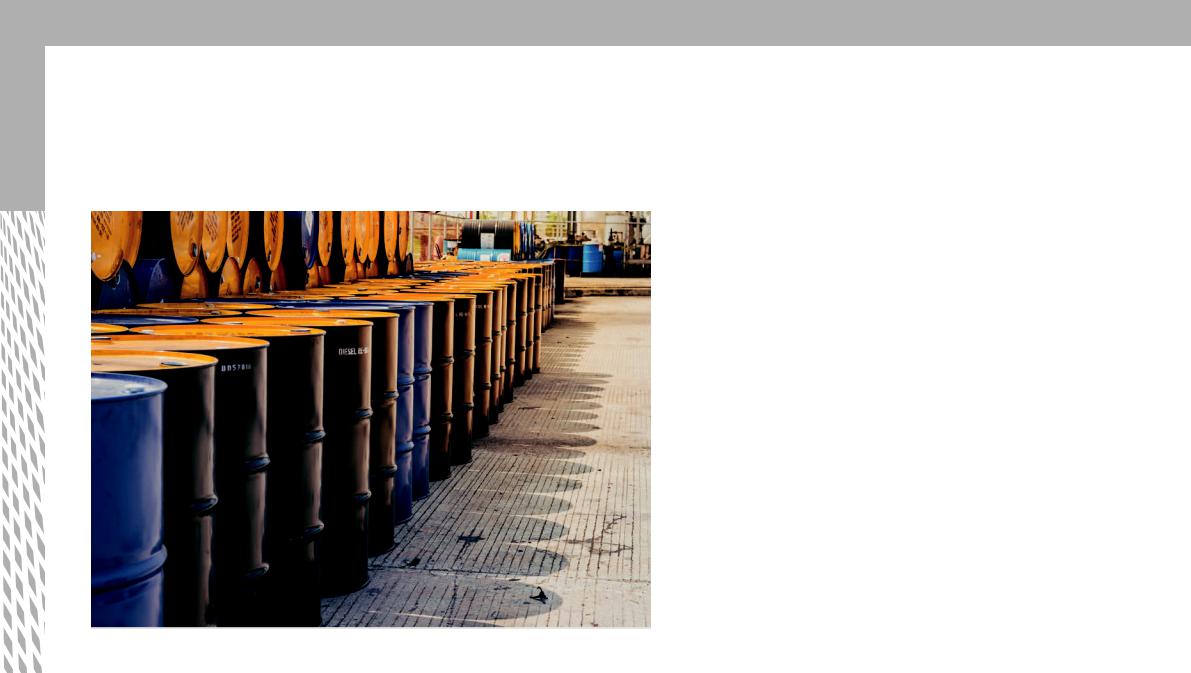
|
Market outlook summary |
Current market trends |
Demand outlook |
Refining outlook |
Prices and margins outlook |
2 |
|
vk.com/id446425943 |
|
|
|
|
|
|
|
|
|
|
|
|
Market outlook summary
Overall
After a strong 2017, the global refining market in 2018 saw strong capacity additions but slow demand growth and declining margins— trends that we expect to continue to see moving forward. As more global capacity is added, we’ll also see utilization rates slip as a result.
Looking ahead, Europe’s utilization rates should dip below 70% by 2023 due to declining demand and the region’s sensitivity to capacity additions in Africa, Asia, and the Middle East.
Asia’s outlook is strong for the long term, but it will not be immune to sliding utilization rates. We expect its utilization levels to dip to 73% by 2023—almost as low as Europe’s—but it should then steadily increase to the lowto mid-80s after 2030.
We’ll see the strongest market conditions in the US Gulf Coast (USGC), where utilization rates will remain in the mid-80s thanks to refinery complexity, access to cheap natural gas, crude pricing at export parity, and strong demand for product exports.

|
Market outlook summary |
Current market trends |
Demand outlook |
Refining outlook |
Prices and margins outlook |
3 |
|
vk.com/id446425943 |
|
|
|
|
|
|
|
|
|
|
|
|
Supply and demand
Global crude supply is growing at 0.2% per annum (p.a.) to 2035, with strong production increases in the Americas and Middle East offsetting falling production in Asia and Africa. However, the higher supply of non- crude-based material, particularly from biofuels, will reduce the need for refining, and we’ll see demand growth slow from the current 1.2% p.a. to 0.5% p.a. until 2035.
The decline in demand will mostly be driven by road transport and power, with the biggest impact seen on diesel. Meanwhile, refining distillation capacity will grow by 1.2% p.a. in the next four to five years, adding almost 7 million barrels per day (MMb/d) of capacity, with most of the capacity additions in Asia and the Middle East.

|
Market outlook summary |
Current market trends |
Demand outlook |
Refining outlook |
Prices and margins outlook |
4 |
|
vk.com/id446425943 |
|
|
|
|
|
|
|
|
|
|
|
|
Balances and flows
Continued capacity additions will lead to overcapacity in the near term, and we’ll see lower utilization in Asia and Europe through 2024 as a result.
As far as changing product flows in the future, the majority will take place in Africa, South Asia, and Southeast Asia—fast-growing regions that will rely on imports to meet future product demand. Asia’s crude slate will also become lighter as the region imports more light tight oil and replaces falling Russian and Asian crude supply with US and Middle Eastern crudes.
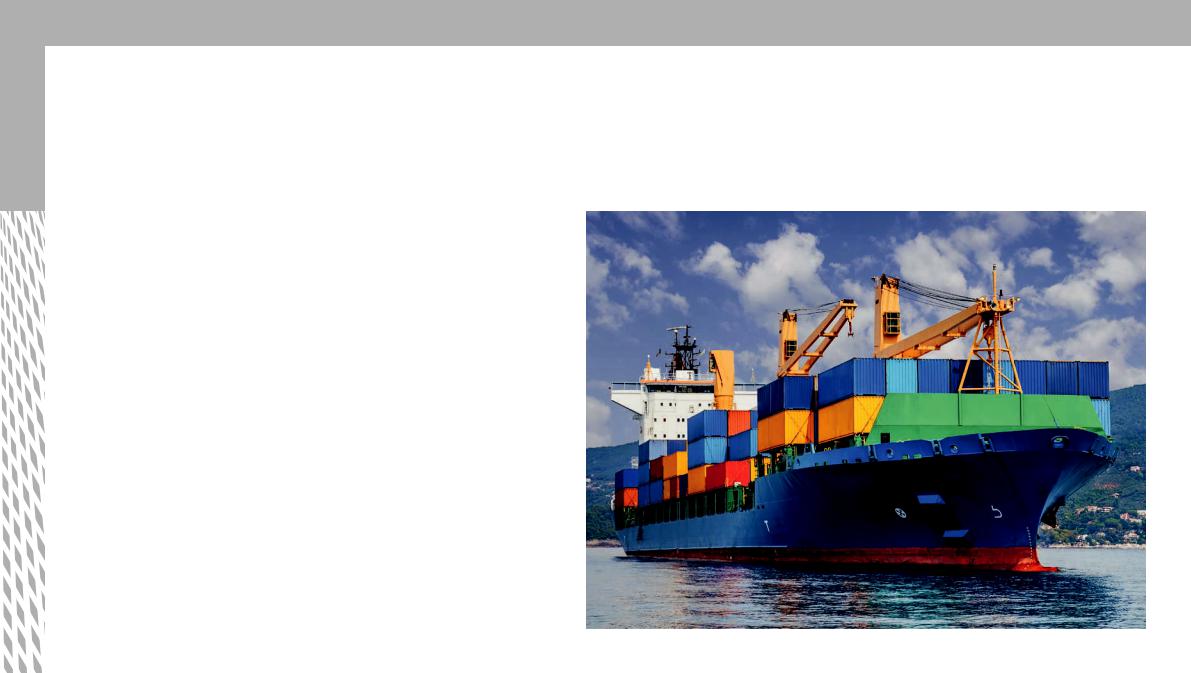
|
Market outlook summary |
Current market trends |
Demand outlook |
Refining outlook |
Prices and margins outlook |
5 |
|
vk.com/id446425943 |
|
|
|
|
|
|
|
|
|
|
|
|
Prices and margins
In the future, MARPOL will be a key player as far as prices and refinery margins go, causing margins to jump initially before tightening markets lead margins to begin to fall.
MARPOL will also increase the light/heavy and diesel gasoline differentials by USD13-17/bbl and USD3-8/bbl, respectively, in 2020, but we expect to see them fall back to historical levels by 2022 as the resid market tightens again and results in a balanced diesel gasoline market.
In addition to products, MARPOL will also push sweet crudes to be priced higher relative to sour crudes from 2020 to 2022; after 2022, these premiums and discounts will revert back to historical levels.
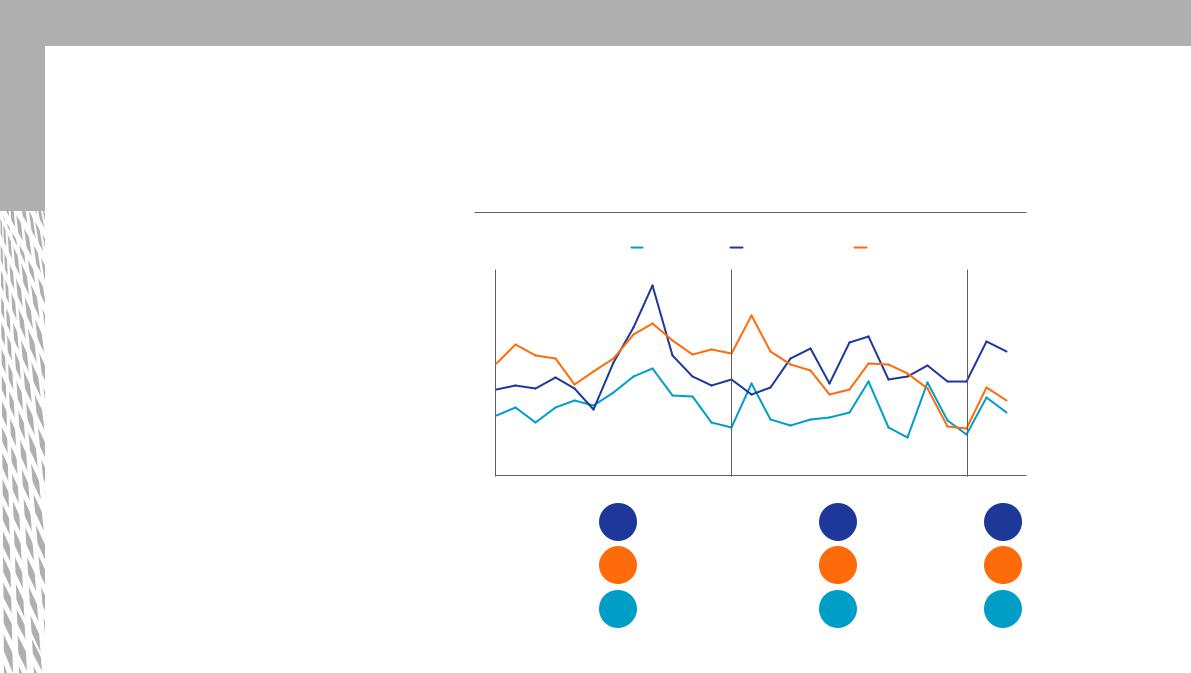
Market outlook summary |
Current market trends |
Demand outlook |
Refining outlook |
Prices and margins outlook |
6 |
vk.com/id446425943 |
|
|
|
|
|
|
|
|
|
|
|
After a strong 2017, refining markets weakened slightly in 2018 in Europe and Asia
•After a relatively strong year in 2017, cracking margins fell on average by USD1.18/bbl and USD0.77/bbl in Asia and Europe, respectively
•The drop in margins came mostly in the second half of 2018, with Asia continuing to see falling margins into early 2019
•European margins remained flat for the majority of 2018 with a slow decline toward the end of the year
•The USGC also saw flat margins on average in 2018, and a slight increase in the first quarter of 2019
Refining margins across hubs: variable cash
USD/barrel |
NWE FCCV1 |
USGC Cracking2 |
Singapore Cracking (RCC)3 |
13 |
|
|
|
12 |
|
|
|
11 |
|
|
|
10 |
|
|
|
9 |
|
|
|
8 |
|
|
|
7 |
|
|
|
6 |
|
|
|
5 |
|
|
|
4 |
|
|
|
3 |
|
|
|
2 |
|
|
|
1 |
|
|
|
0 |
2017 |
2018 |
Q1 2019 |
|
|||
|
6.94 |
6.93 |
7.65 |
Margin |
|
|
|
annual |
7.99 |
6.81 |
4.59 |
average |
|
|
|
|
4.86 |
4.09 |
3.96 |
1 Brent delivered to Northwest Europe; Fluid cataltyic cracking + visbreaking (FCCV)
2 WTI Magellan East Houston (MEH) in US Gulf Coast
3 Dubai delivered to Singapore; Residual catalytic cracking (RCC)
Source: Energy Insights – OilDesk Model (June 2019), Platts
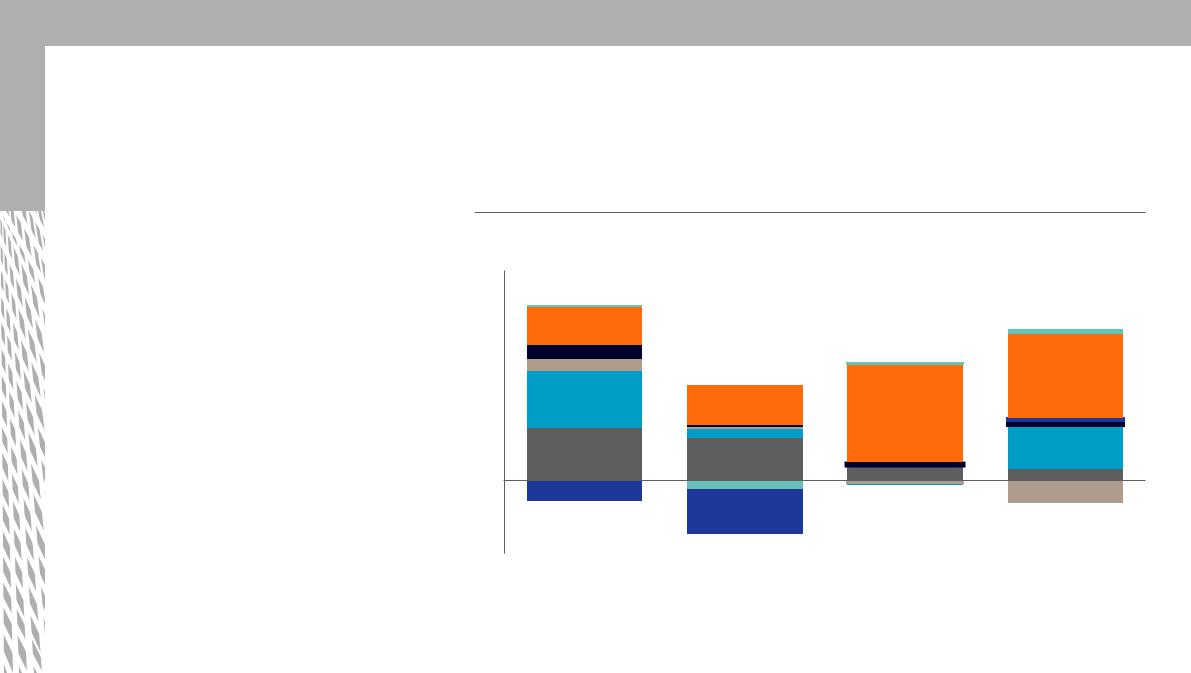
Market outlook summary |
Current market trends |
Demand outlook |
Refining outlook |
Prices and margins outlook |
7 |
vk.com/id446425943 |
|
|
|
|
|
|
|
|
|
|
|
Global refinery capacity additions were strong in 2018, especially in Asia and the Middle East
•Net distillation capacity growth was strong in 2018, adding 950 Kb/d of capacity versus 835 Kb/d in 2017
•Asia was the largest contributor of capacity growth with over 600 Kb/d added in 2018, largely from expansion projects in China and India and Vietnam’s new Nghi Son 200 Kb/d refinery
•The Middle East had over 300 Kb/d of additions, most of which came from two 120-Kb/d condensate splitters at Iran’s Bandar Abbas refinery
•Distillation capacity in Latin America decreased by 156 Kb/d with the closure of the Point a Pierre refinery in Trinidad
Change in refining distillation capacity1
MMb/d |
|
Africa |
|
Asia |
|
Europe |
|
FSU |
|
Middle East |
|
North America |
|
Latin America |
|
|
|
|
|
|
|
||||||||
|
|
|
|
|
|
|
||||||||
1.5 |
|
|
|
|
|
|
|
|
|
|
|
|
|
|
1.0
0.5
0
-0.5
2015 |
2016 |
2017 |
20182 |
1 Based on date of capacity start up 2 Does not include partial capacity additions from Aliaga, Hengli, and RAPID assumed to come online partially in 2019, representing 325 Kb/d in Asia and 186 Kb/d in Europe
Source: McKinsey Refining Capacity Database
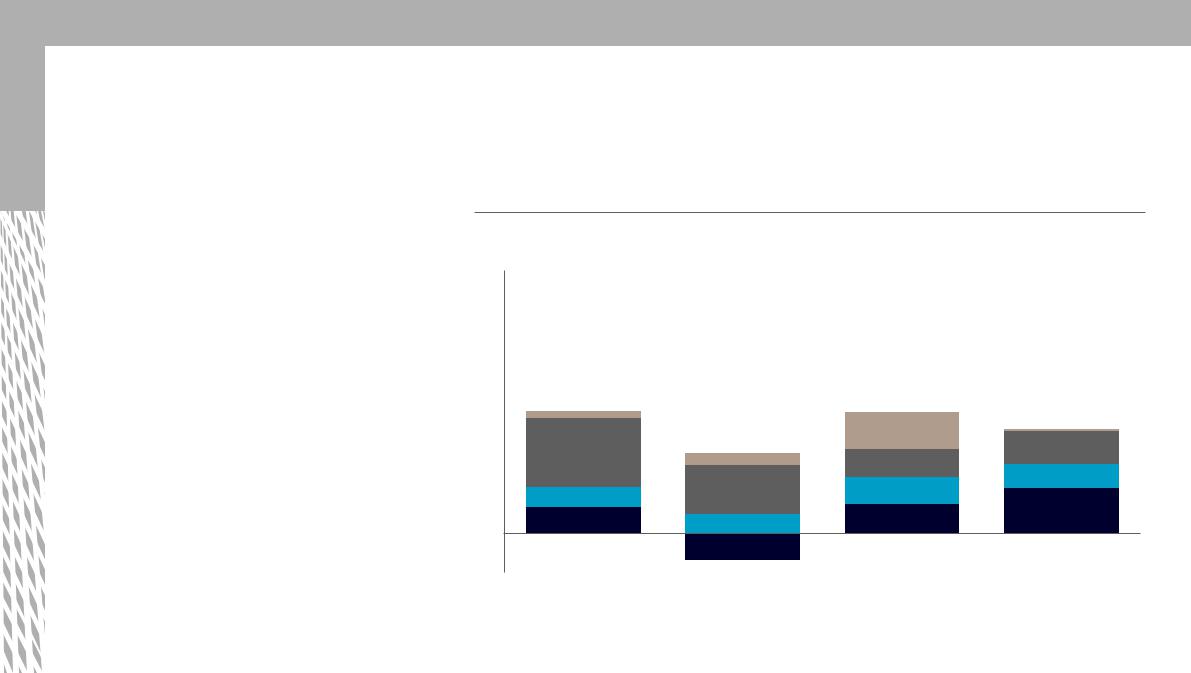
Market outlook summary |
Current market trends |
Demand outlook |
Refining outlook |
Prices and margins outlook |
8 |
vk.com/id446425943 |
|
|
|
|
|
|
|
|
|
|
|
Globally, middle distillate1 demand growth was stronger than gasoline range products in 2018
•Global light product demand growth was ~200 Kb/d lower in 2018, almost entirely a result of naphtha growth falling to ~0
•Diesel/gasoil demand grew the strongest, with 40% growth from both North America and Asia (largely driven by India)
•Jet/kero demand growth was in line with history, although ~40 Kb/d lower than in 2017, with most of the growth slowdown originating in North America
•Gasoline growth remained strong in 2018, with 25% of growth resulting from Europe’s push toward gasoline-powered cars versus diesel
•Naphtha demand growth was marginal in 2018, mostly related to the relative pricing to propane as a chemical feedstock
Change in global light product demand, Year-over-year change
MMb/d |
|
Naphtha |
|
Gasoline |
|
Jet/Kero |
|
Diesel/Gasoil |
|
|
|
|
|||||
|
|
|
|
3.0
2.8
2.6
2.4
2.2
2.0
1.8
1.6
1.4
1.2
1.0
0.8
0.6
0.4
0.2
0 -0.2 -0.4
2015 |
2016 |
2017 |
2018 |
1 Includes jet/kero and diesel/gasoil
Source: Energy Insights – Global Downstream Model (May 2019)
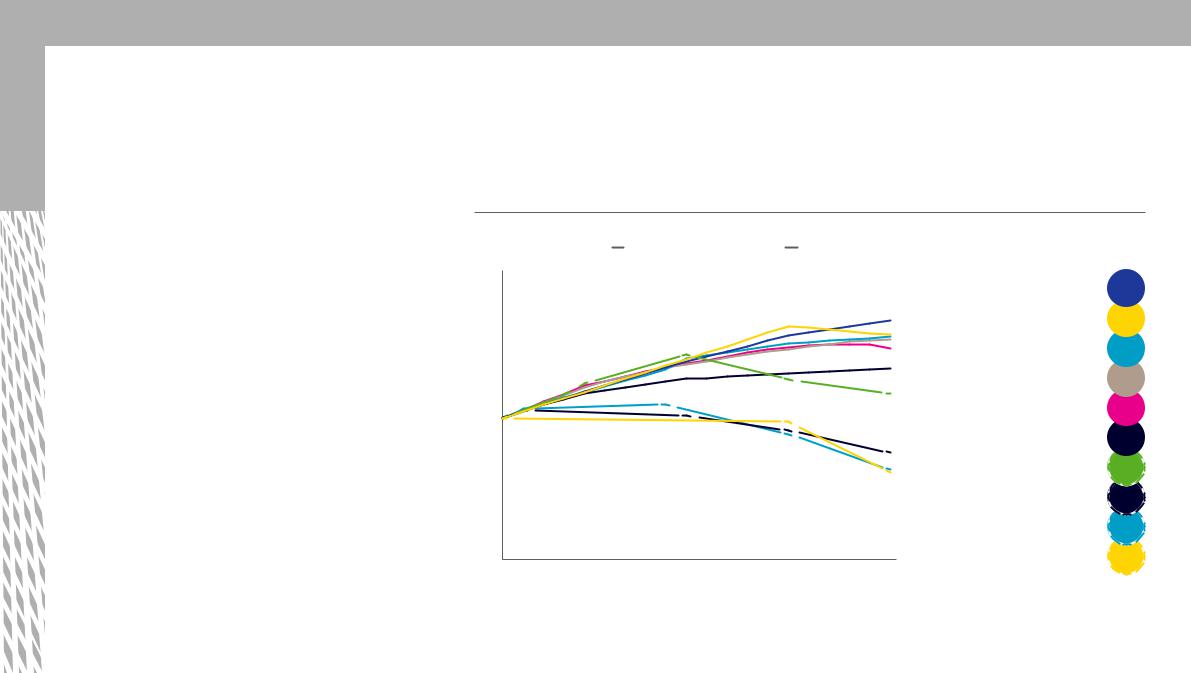
Market outlook summary |
Current market trends |
Demand outlook |
Refining outlook |
Prices and margins outlook |
9 |
vk.com/id446425943 |
|
|
|
|
|
|
|
|
|
|
|
Global oil demand is projected to slow down and peak by the early 2030s, sooner than in most other sources
•Oil demand growth is expected to slow to 0.5% p.a. from 2018 to 2035 in our latest reference case. This represents a significant slowdown compared to the historical average of +1% p.a. over the last three decades
•Our outlook is within the range of other forecasts in the near term to 2030
•In the long term, we forecast an earlier peak in oil demand by the early 2030s compared to other forecasts. This is primarily due to a more bearish outlook for road transport demand due to growing penetration of electric vehicles
Global oil demand1 |
|
|
CAGR |
Indexed to 100 |
Reference case forecasts |
Sustainability cases |
2018-35 |
125 |
|
ExxonMobil |
0.8% |
120 |
|
||
|
Equinor Reform |
0.7% |
|
115 |
|
||
|
|
|
|
110 |
|
IEA New Policies |
0.6% |
|
|
|
|
105 |
|
Global Downstream Model 20181 |
0.6% |
|
|
|
|
100 |
|
Global Downstream Model 20191 |
0.5% |
|
|
|
|
95 |
|
BP Evolving Transition |
0.4% |
|
|
|
|
90 |
|
Shell – Sky |
0.1% |
|
|
|
|
85 |
|
BP Rapid Transition |
-0.4% |
|
|
|
|
80 |
|
IEA Sustainable Development |
-0.7% |
|
|
|
|
|
|
Equinor Renewal |
-0.6% |
7516 17 18 19 20 21 22 23 24 25 26 27 28 29 30 31 32 33 34 35 |
|
||
1 The Global Downstream Model outlooks are based on our Global Energy Perspective Reference Case. Definition of products (e.g., ethane, refinery fuel) may not be consistent across all other forecasts. Source: Energy Insights – Global Downstream Model (May 2019), BP Global Energy Outlook (Feb 2019), ExxonMobil Outlook for Energy (Feb 2018), IEA World Energy Outlook (Oct 2018), Equinor Energy Perspectives (May 2018), Shell Scenarios (Apr 2018)
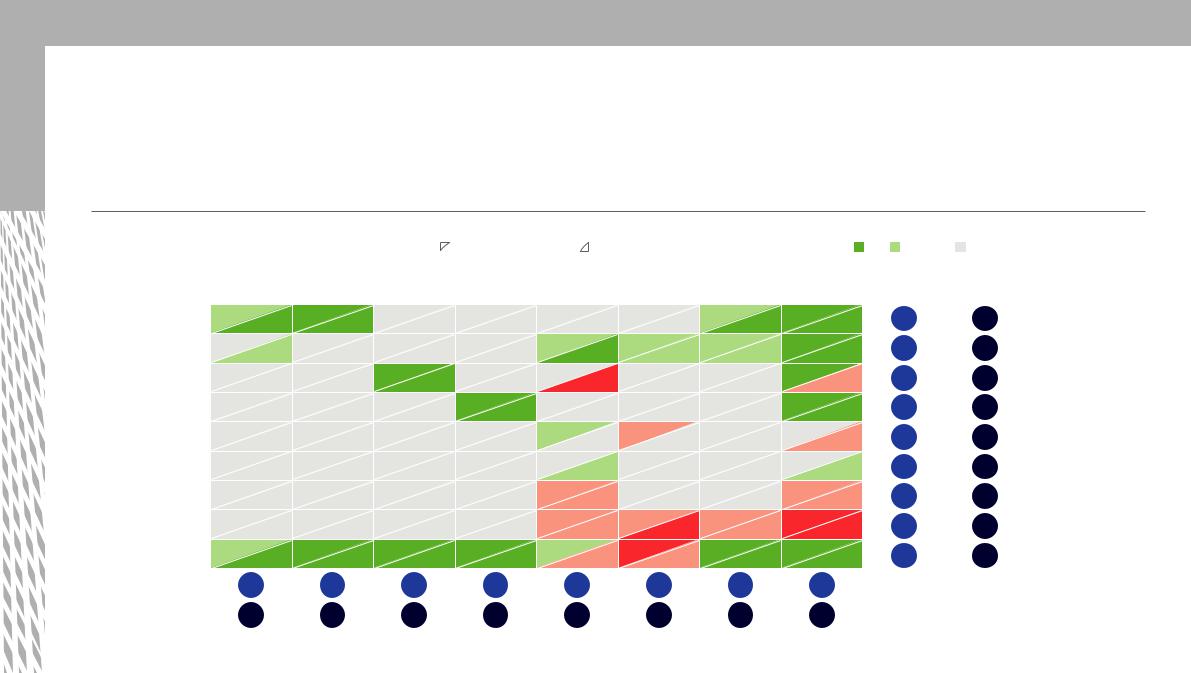
Market outlook summary |
Current market trends |
Demand outlook |
Refining outlook |
Prices and margins outlook |
10 |
vk.com/id446425943 |
|
|
|
|
|
|
|
|
|
|
|
Chemicals and aviation are the main sources of long-term demand growth, while road transport and power have the biggest decline
Global liquids demand 2018-35 |
|
|
|
|
|
|
|
|
|
|
|
|
MMb/d |
|
|
|
2018-25 (short term) |
2018-35 (long term) |
2018-35 delta MMb/d |
>1 |
0.1 to 1 |
-0.1 to 0.1 |
|||
|
|
|
Motor |
|
|
|
|
|
|
|
CAGR |
Total 2018 |
|
LPG1 |
Naphtha |
gasoline |
Jet/Kero |
Gas/Diesel |
Fuel oil |
Other2 |
Total |
(2018-35) |
volume |
||
Chemicals |
|
|
|
|
|
|
|
|
|
|
2.4% |
13.2 |
Other industries |
|
|
|
|
|
|
|
|
|
|
1.0% |
13.9 |
Road transport |
|
|
|
|
|
|
|
|
|
|
-0.1% |
44.2 |
Aviation |
|
|
|
|
|
|
|
|
|
|
2.3% |
7.0 |
Marine |
|
|
|
|
|
|
|
|
|
|
-0.3% |
5.1 |
Other transport |
|
|
|
|
|
|
|
|
|
|
1.4% |
1.8 |
Buildings |
|
|
|
|
|
|
|
|
|
|
-0.5% |
7.7 |
Power |
|
|
|
|
|
|
|
|
|
|
-5.3% |
3.7 |
Total |
|
|
|
|
|
|
|
|
|
|
0.5% |
95.8 |
CAGR (2018-35) |
0.7% |
2.2% |
0.2% |
2.0% |
-0.3% |
|
-0.7% |
1.3% |
0.5% |
|
|
|
Total 2018 volume |
9.3 |
7.1 |
26.0 |
7.8 |
28.6 |
|
7.1 |
9.9 |
95.8 |
|
|
|
 -0.1 to -1
-0.1 to -1  <-1
<-1
1Liquefied petroleum gas
2Includes reformate BTX (feedstock into aromatics unit at refinery), bitumen, lubes, waxes, petcoke, and other oil products Source: Energy Insights – Global Downstream Model (May 2019)
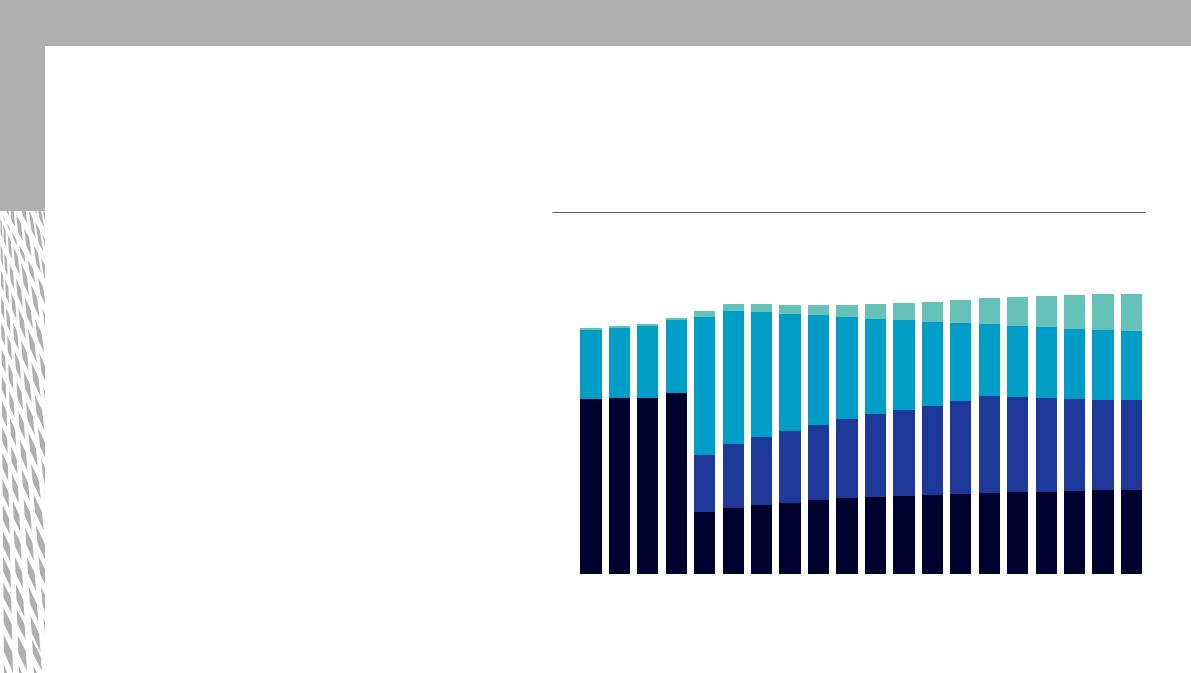
Market outlook summary |
Current market trends |
Demand outlook |
Refining outlook |
Prices and margins outlook |
11 |
vk.com/id446425943 |
|
|
|
|
|
|
|
|
|
|
|
MARPOL provides a temporary boost in gasoil demand in 2020, but gasoil will gradually lose market share to VLSFO and LNG
•TheInternational Maritime Organization’s MARPOL regulations on sulfur in global bunker fuel result in HSFO demand falling by 2.4 MMb/d in 2020 and being replaced by VLSFO and MGO
•Our reference case outlook assumes the mix of low-sulfur bunker fuels is split 50/50 between VLSFO and MGO initially in 2020 but then gradually reverts to VLSFO taking up all of the non-emission control areas share of MGO demand as refiners adapt operations to increase VLSFO production over time
•Scrubber installations are expected on at least 3,000 ships by 2020, up significantly from the previous year’s estimates resulting in more HSFO retained in the bunker pool
•LNG begins to take market share from MGO and VLSFO after 2025
•MARPOL enforcement is still uncertain, but enforcement discussions and carriage bans encourage a lower non-compliance rate than previously expected (assumed to be 8% in 2020 and <5% in 2025+)
Global bunker fuel demand mix |
|
|
|
|
|
|
|
|
|
|
|||
MMb/d |
|
|
|
LNG1 |
|
MGO2 |
|
VLSFO3 |
|
HSFO4 |
|||
|
|
|
|
|
|
||||||||
|
|
|
|
|
|
||||||||
6.0 |
|
|
|
|
|
|
|
|
|
|
|
|
|
|
|
|
|
|
|
|
|
|
|
|
|
|
|
5.5 |
|
|
|
|
|
|
|
|
|
|
|
|
|
5.0 |
|
|
|
|
|
|
|
|
|
|
|
|
|
4.5 |
|
|
|
|
|
|
|
|
|
|
|
|
|
4.0 |
|
|
|
|
|
|
|
|
|
|
|
|
|
3.5 |
|
|
|
|
|
|
|
|
|
|
|
|
|
3.0 |
|
|
|
|
|
|
|
|
|
|
|
|
|
2.5 |
|
|
|
|
|
|
|
|
|
|
|
|
|
2.0 |
|
|
|
|
|
|
|
|
|
|
|
|
|
1.5 |
|
|
|
|
|
|
|
|
|
|
|
|
|
1.0 |
|
|
|
|
|
|
|
|
|
|
|
|
|
0.5 |
|
|
|
|
|
|
|
|
|
|
|
|
|
0 |
|
|
|
|
|
|
|
|
|
|
|
|
|
2016 |
2020 |
2025 |
|
|
2030 |
2035 |
|||||||
1 Liquefied natural gas 2 Marine gasoil 3 Very low sulfur fuel oil 4 High sulfur fuel oil Source: Energy Insights – Global Downstream Model (May 2019)
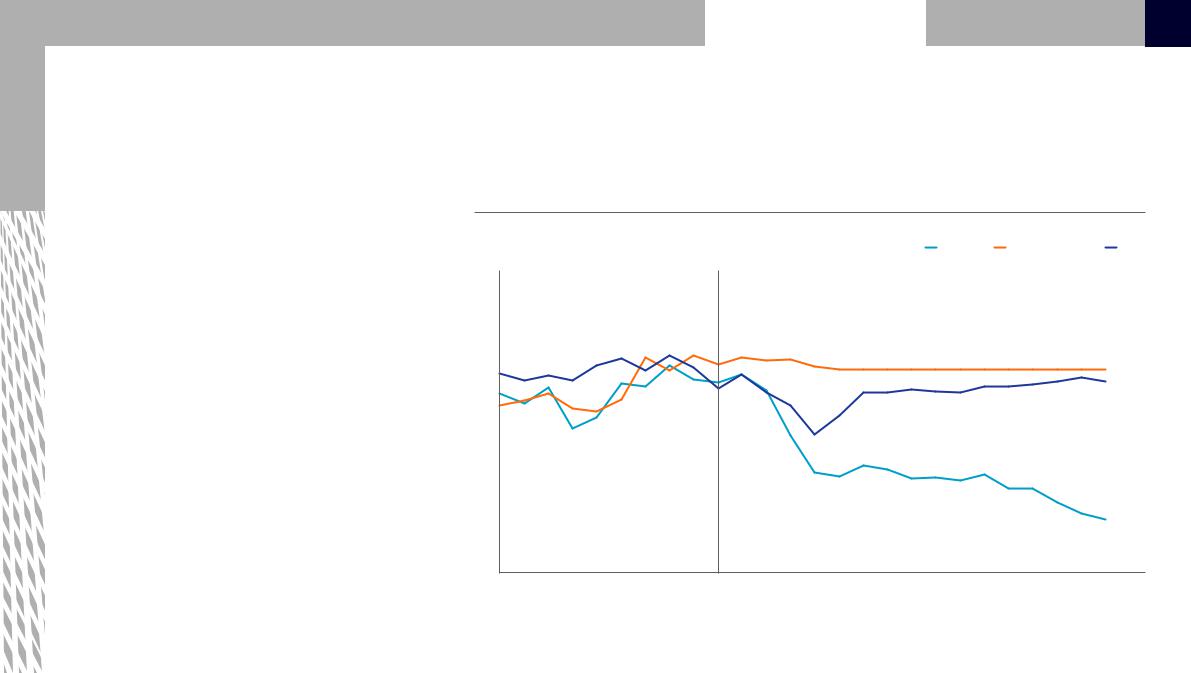
Market outlook summary |
Current market trends |
Demand outlook |
Refining outlook |
Prices and margins outlook |
12 |
vk.com/id446425943 |
|
|
|
|
|
North America and Asia stay at healthier utilization while Europe will decline steeply, likely requiring rationalization
•Refining overcapacity in the next 5-6 years will reduce hub refining utilization in both Asia and Europe, making the marginal configuration more complex
•Start-up of several large refineries in the Middle East and Africa will impact the Asian and European product markets while the US Gulf Coast’s complexity and resource advantage keeps utilization high
•The start-up of the 500-Kb/d Nigerian refinery in 2023 drags European utilization down below 70%, and some rationalization of capacity is likely to happen but is not included in our forecast
•Asia gets tighter after 2025 as a result of growing product demand, and capacity additions will be required. The outlook assumes a new 300-Kb/d refinery addition in India in 2026 and another in 2030, and two 300-Kb/d condensate splitters in China in 2025 and 2027
Regional hub1 refining utilization |
|
|
|
Percent of stream day distillation capacity |
Europe |
North America |
Asia |
100 |
Historical |
|
|
|
Forecast |
|
|
|
|
|
|
|
|
|
90 |
|
|
|
|
|
|
|
|
|
|
|
|
|
|
80 |
|
|
|
|
|
|
|
|
|
|
|
|
|
|
70 |
|
|
|
|
|
|
|
|
|
|
|
|
|
|
60 |
|
|
|
|
|
|
|
|
|
|
|
|
|
|
50 |
|
2012 |
2014 |
2016 |
2018 |
2020 |
2022 |
2024 |
2026 |
2028 |
2030 |
2032 |
2034 |
2036 |
2010 |
||||||||||||||
1 Asia: South Korea, Singapore, Taiwan; North America: US Gulf Coast; Europe: Belgium, Netherlands, the UK Source: Energy Insights – Global Downstream Model May 2019
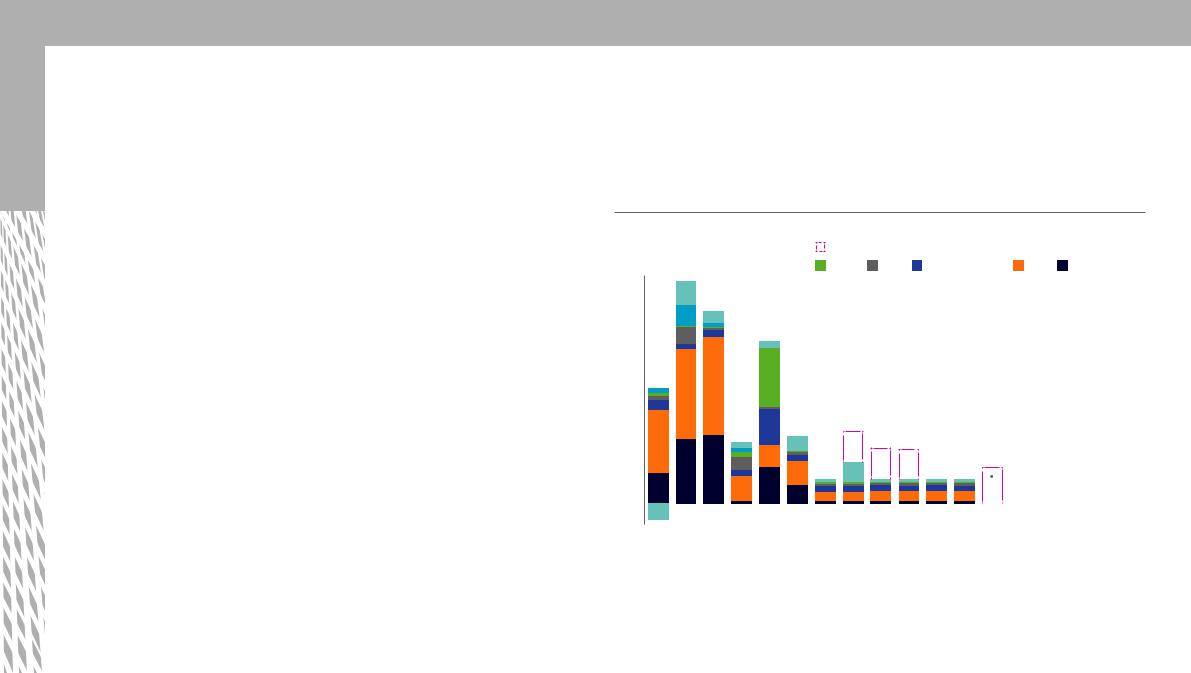
Market outlook summary |
Current market trends |
Demand outlook |
Refining outlook |
Prices and margins outlook |
13 |
vk.com/id446425943 |
|
|
|
|
|
|
|
|
|
|
|
Capacity will grow over 6.8 MMb/d in the next five years, largely from projects in Asia and the Middle East
•Global distillation capacity is growing at 1.2% p.a. from 2019 to 2024 and slowing to 0.4% p.a. from 2024 to 2030, which is mostly creep
•A wave of new refining capacity additions led by greenfield projects in Asia and the Middle East are expected to put pressure on global refining utilization as early as 2019
•2019 capacity growth in Asia will be the highest ever seen in one year in recent history and will disproportionally affect Asian hub utilization, with even more additions in 2020
•New projects in Europe, Africa, the Middle East, and the US will weigh on European and Asian refining utilization in the next five years
•In the long term, it is expected that India will add two 300 Kb/d refineries after 2025, in line with the historical trend of selfsufficiency
•To help meet naphtha demand, it is expected that China will add two 300-Kb/d condensate splitters after 2025
•There are no rationalization assumptions made in the reference case, although no creep is assumed in Europe after 2023; it is likely that rationalization will occur in the long run as utilization falls in Europe
Change in refining distillation capacity1
MMbbl stream day capacity |
Additional capacity required2 |
|
Latin America |
|
Europe |
|
|
||||
|
|
Africa FSU North America Asia Middle East
2.2
2.0 |
|
|
|
|
|
|
|
|
|
|
|
|
|
|
|
|
|
|
|
1.8 |
|
|
|
|
|
|
|
|
|
|
|
|
|
|
|
|
|
|
|
1.6 |
|
|
|
|
|
|
|
|
|
|
|
|
|
|
|
|
|
|
|
1.4 |
|
|
|
|
|
|
|
|
|
|
|
|
|
|
|
|
|
|
|
1.2 |
|
|
|
|
|
|
|
|
|
|
|
|
|
|
|
|
|
|
|
|
|
|
|
|
|
|
|
|
|
No new projects assumed |
|
|
|
||||||
1.0 |
|
|
|
|
|
|
|
|
|
|
|
|
|
||||||
|
|
|
|
|
|
|
|
|
after 2030 in anticipation of |
|
|
||||||||
0.8 |
|
|
|
|
|
|
|
|
|
|
peak global oil demand |
|
|
|
|||||
0.6 |
|
|
|
|
|
|
|
|
|
|
|
|
|
|
|
|
|
|
|
0.4 |
|
|
|
|
|
|
|
|
|
|
|
|
|
|
|
|
|
|
|
0.2 |
|
|
|
|
|
|
|
|
|
|
|
|
|
|
|
|
|
|
|
|
|
|
|
|
|
|
|
|
|
|
|
|
|
|
|
|
|
|
|
0 |
|
|
|
|
|
|
|
|
|
|
|
|
|
|
|
|
|
|
|
|
|
|
|
|
|
|
|
|
|
|
|
|
|
|
|
|
|
|
|
-0.2 |
183 |
19 |
20 |
21 |
22 |
23 |
24 |
25 |
26 |
27 |
28 |
29 |
30 |
31 |
32 |
33 |
34 |
35 |
|
1 Based on start-up date, as of Jan 2019, we assume 0.25% p.a. creep factor until 2030 for all locations except Europe, Japan, and Australia, where creep stops in 2023 2 New capacity will need to be added in Asia to meet growing demand 3 Does not include partial capacity additions from Aliaga, Hengli, and RAPID assumed to come online partially in 2019, representing 325 Kb/d in Asia and 186 Kb/d in Europe
Source: Energy Insights – Global Downstream Model (May 2019), McKinsey Refining Capacity Database, Capacity Additions Database
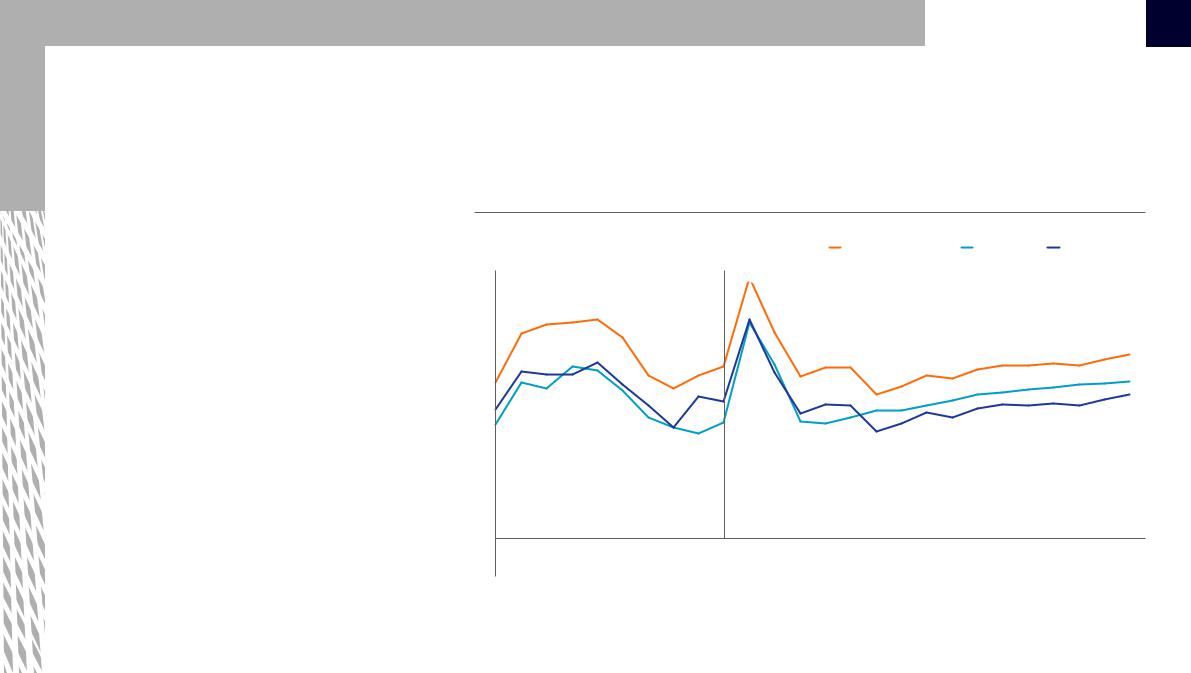
Market outlook summary |
Current market trends |
Demand outlook |
Refining outlook |
Prices and margins outlook |
14 |
vk.com/id446425943 |
|
|
|
|
|
MARPOL will cause a spike in the light-heavy product differential, but market will return to levels similar to 2018 by 2022 and grow
•Light-heavy product price differentials will jump in 2020 on MARPOL implementation as a portion of resid fuels become displaced in bunker demand by low sulfur MGO and VLSFO
•The global excess in resid will depress resid prices to substitution levels, driving up the light-heavy differential across regions by as much as USD17/bbl
•By 2022, product differentials will fall back to 2017-2018 levels as ships install sulfur scrubbers and resid demand in bunker gradually recovers, bringing light-heavy differentials back up
Light-heavy product differentials1 |
|
|
|
|
||
USD/barrel |
|
|
Northwest Europe |
Singapore |
US Gulf Coast |
|
40 |
Historical |
|
Forecast |
|
|
|
35 |
|
|
|
|
|
|
30 |
|
|
|
|
|
|
25 |
|
|
|
|
|
|
20 |
|
|
|
|
|
|
15 |
|
|
|
|
|
|
10 |
|
|
|
|
|
|
5 |
|
|
|
|
|
|
0 |
|
|
|
|
|
|
-5 |
|
2015 |
2020 |
2025 |
2030 |
2035 |
2010 |
||||||
1 Average light product (diesel, gasoline) prices minus fuel oil (3.5% sulfur, 380 cst) Source: Energy Insights – OilDesk Model (June 2019), Platts
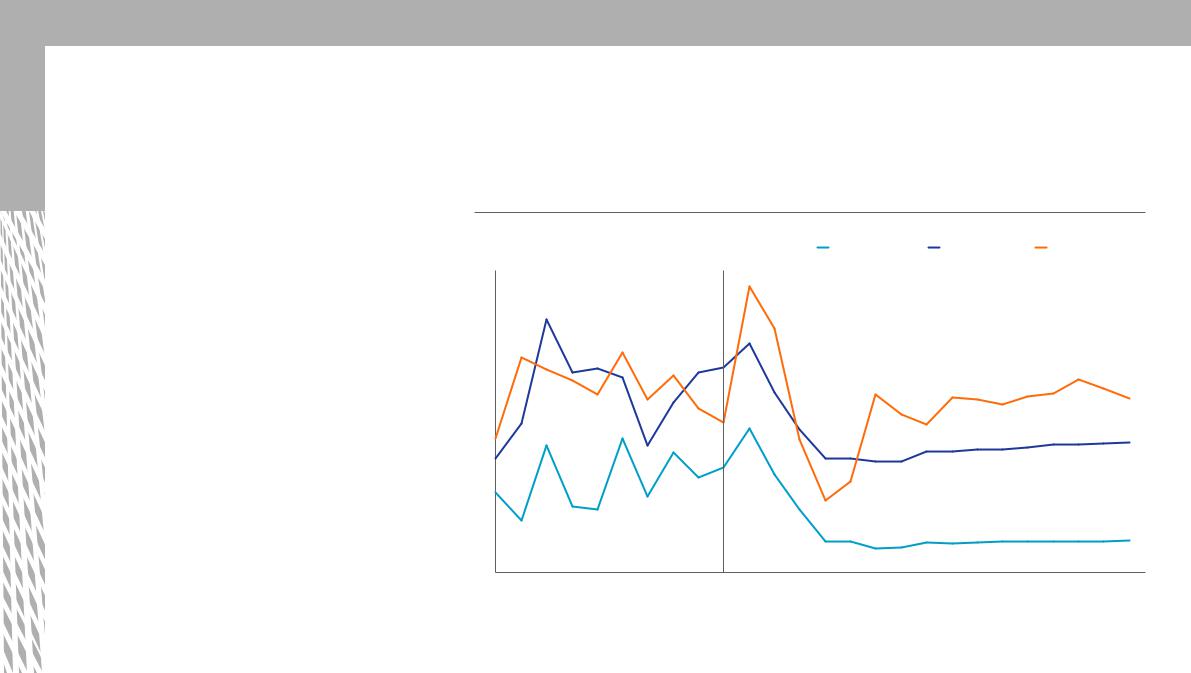
Market outlook summary |
Current market trends |
Demand outlook |
Refining outlook |
Prices and margins outlook |
15 |
vk.com/id446425943 |
|
|
|
|
|
|
|
|
|
|
|
Refiners will benefit from higher margins in 2020 as a result of MARPOL
•Cracking margins across hubs will see a boost in margins in 2020 due to higher distillate demand growth from MARPOL
•More complex configurations (such as coking) will see an even bigger boost in 2020 due to MARPOL
•Margins in hub markets will fall below historical averages following the lower utilization outlook in the near-term, driven by lower demand growth and capacity additions
•The sustained lower margin outlook in Europe after 2025 will likely result in an unknown level of refinery closures across various countries and result in margin cyclicality to levels closer to historical margins
Refining margins by hub (variable cash) |
|
|
|
USD/barrel |
Europe FCCV1 |
USGC FCCA2 |
Singapore RCC3 |
12 |
Historical |
|
Forecast |
|
|
|
10 |
|
|
|
|
|
|
8 |
|
|
|
|
|
|
6 |
|
|
|
|
|
|
4 |
|
|
|
|
|
|
2 |
|
|
|
|
|
|
0 |
|
2015 |
2020 |
2025 |
2030 |
2035 |
2010 |
||||||
1 Brent delivered to Rotterdam 2 Vasconia delivered to Houston; Fluid catalytic cracking and alkylation (FCCA) 3 Dubai delivered to Singapore Source: Energy Insights – OilDesk Model (June 2019), Platts

vk.com/id446425943
About us
We are a global market intelligence and analytics group focused on the energy sector. We enable organizations to make well-informed strategic, tactical, and operational decisions, using an integrated suite of market models, proprietary industry data, and a global network of industry experts. We work with leading companies across the entire energy value chain to help them manage risk, optimize their organizations, and improve performance.
For more information about our global downstream outlook, please contact: info_energyinsights@mckinsey.com
www.mckinsey.com/downstreamoutlook
© Copyright 2019 McKinsey Solutions Sprl
This document contains proprietary information of McKinsey & Company and is intended for internal use by you and your company. Please do not reproduce, disclose, or distribute the information contained herein without McKinsey & Company’s express prior written consent. Nothing herein is intended to serve as investment advice or a recommendation of any particular transaction or investment, the merits of purchasing or selling securities, or an invitation or inducement to engage in investment activity. While this document is based on sources believed to be reliable, McKinsey & Company does not warrant its completeness or accuracy.

vk.com/id446425943
Methodology
Market sizing & forecasts
Key global trends
Newzoo’s Gamer SegmentationTM
Top 35 companies
Global
games
market report
2019

vk.com/id446425943
FOREWORD
FOREWORD
NEWZOO’S 2019 GLOBAL GAMES MARKET
REPORT: CONTENT ISPRESSKING
We are proud to present our 2019 Global Games Market Report. Now more than ever, gaming is at the heart of the entertainment business. The way consumers engage with and through games is continually changing. Not only does this result in more overall engagement, but it also leads to entirely new segments of game enthusiasts.
Brands from every corner of the consumer-facing market are seizing the opportunity that gaming presents, especially when it comes to reaching younger generations. In the last decade alone, the years-long stigma against gamers has all but disappeared. What’s
FORmore, the past year has seen many brands—including the biggest companies in apparel, automotive, and even financial services—connect with gaming in bigger and better ways than ever before.
Gaming’s rise to the mainstream, particularly its shift toward more live events, professional athletes, and entertainment spectacles, presents new crossover opportunities for other sectors within the entertainment business. After all, more than 10 million enthusiasts tuned in when the popular DJ Marshmello hosted a concert within the virtual world of Fortnite. This year marks the first time that Netflix had a presence at E3, the world’s largest gaming event for consumers. What’s more, popular game IP is increasingly being adapted for television, and the biggest games rival Hollywood in terms of grandeur, budget, narrative, and revenues.
Businessmodelsfromgeneralentertainmentandgamesarealsobecomingintertwined. Subscription-based distribution is now the de facto method of content consumption for music and TV, and gaming is increasingly embracing the model. However, content is still king and lies at the heart of any successful subscription service. This is why we foresee a content gold rush going forward, as companies vie for the rights to lucrative gaming IP. The promise of cloud gaming—allowing players to play any game anywhere, anytime, on any platform—brings us into a platform-agnostic future. In this future, we will no longer argue about what’s the best console, nor the differences between PC, console, and
FOREWORD
|
mobile gaming. The only thing that will matter is which services |
|
||
|
offer the best gaming experiences and content. |
|
||
|
The meteoric success of gaming is too impactful for brands |
|
||
|
to ignore, with more and more huge names, including Google |
|
||
|
and Netflix, choosing to enter the fray. Google announced its |
|
||
|
biggest move into gaming in March 2019 when it unveiled Google |
|
||
|
Stadia to the world, as well as the establishment of its own game |
|
||
|
studio. It will leverage YouTube’s massive user base to drive |
|
||
|
Stadia’s success, combining both video and interactive gaming |
|
||
|
|
PRESS |
||
|
content. Meanwhile, Samsung partnered with Hatch to launch |
|
||
|
a 5G-powered game streaming service in the U.S., and Apple is |
|
||
|
testing the waters for its new premium mobile game service, |
|
||
|
Apple Arcade. |
|
|
|
|
At the same time, the mainstream spotlight also attracts the |
|
||
|
public eye. New models of content monetization, pioneered by |
|
||
|
games, have drawn criticism from the community and politicians |
|
||
|
alike. The nine-month freeze on game licenses in China last year |
|
||
|
was perhaps the most impactful consequence. The domestic |
|
||
|
market is well on the road to recovery, but it has certainly taken |
|
||
|
a hit, albeit temporarily. In-game monetization is now the norm |
|
||
|
in the most profitable games, even more so when subscriptions |
|
||
|
start to substitute the traditional paid game business model. |
|
||
©SHUTTERSTOCK |
FOR |
|
|
|
For publishers, finding the right mix of business models in an |
|
|||
extremely dynamic market, with pressure from politics and a |
PETER WARMAN |
|||
diverse game enthusiast community, will be the biggest challenge |
CEO, Newzoo |
|||
COVER |
||||
in the coming years. |
|
|
||
2 |
GLOBAL GAMES MARKET REPORT 2019 |
©2019 Newzoo |
©2019 Newzoo |
GLOBAL GAMES MARKET REPORT 2019 |
3 |

vk.com/id446425943
1.
METHODOLOGY & TERMINOLOGY
METHODOLOGY & TERMINOLOGY
METHODOLOGY
SIZING THE MARKET WITH A VARIETY OF DATA PRESS
Newzoo aims to provide clients with the best possible assessment of the size of the overall games market, broken down into segments and regions. By developing many data points, we ensure that our numbers make sense on a segment, regional, and individual country/market level. Below, we describe our approach in more detail to help clients understand what underpins our forecasts, facilitating comparisons with other data sources.
At the highest level, Newzoo focuses on three key metrics for every market: players, payers, and revenues.
The data on players and payers is mainly based on our own primary consumer research, which continues to form the basis of our understanding of consumers and games. In our primary consumer research, conducted from February to March 2019, more than 62,500 invite-only respondents across 30 key countries/markets were surveyed. The 30 countries/markets together represent more than 90% of global game revenues. Respondents were carefully selected to represent the online population in developed countries and the urban online population in selected major cities in emerging countries in Southeast Asia, Turkey, Saudi Arabia, and India. This research started in 2009 with six countries; now, it is the world’s largest games-related consumer
FORresearch program.
The player and payer ratios resulting from our consumer research are projected against the online population, using UN population and ITU internet penetration metrics. The logic behind the model is that the online population is an important driver of the number of potential gamers and an indicator of how much more structural growth a country can expect in its potential gamer population.
The differences between the player and payer numbers in the Global Games Market Report and our Consumer Insights stem from the use of age boundaries and the core city approach; that is, including only Tier 1 and 2 cities in Asia and the Middle East. In the Global Games Market Report, the total population is considered, while our Consumer Insights use the population aged between 10 and 50 or 65 years to best represent the online urban population in most countries.
The revenue data comes from our predictive games market model, which uses a topdown approach to market sizing. We incorporate macroeconomic and census data from the IMF and UN, such as household income and GDP per capita, transactional and app store revenue data from our data partner Priori Data, our primary consumer research, detailed financial information reported by more than 100 public companies, and third-party research. We also receive valuable input from clients.
©2019 Newzoo |
GLOBAL GAMES MARKET REPORT 2019 |
5 |

vk.com/id446425943
METHODOLOGY & TERMINOLOGY
Market size estimates and growth forecasts for individual segments, countries, and
|
PRESS |
in aggregate for the total industry are validated against our analysis of various contex- |
|
tual metrics. For instance, our market model calculates the average annual spend per |
|
paying gamer, which is then compared with historical numbers, other regions, house- |
|
hold income, and GDP per capita. |
|
Our historical revenues and growth rates reflect the year-end US$ exchange rate. |
|
Our projected growth rates assume steady exchange rates going forward, but we take |
|
into consideration historical growth rates in local currency rather than US$, as this |
|
gives a better picture of underlying growth. |
|
We define revenues as the amount the industry generates in consumer spending |
|
on games; physical and digital full-game copies, in-game spending, and subscription |
|
services like PlayStation Plus and Xbox Game Pass. Mobile revenues include paid |
|
downloads and in-game spending on all stores, including third-party stores, and from |
|
direct downloads. Our revenue numbers exclude taxes, consumer-to-consumer second- |
|
hand trade, advertising revenues earned in and around games, (peripheral) hardware, |
|
business-to-business services, and the traditionally regulated online gambling and |
|
betting industry (e.g., BWIN and William Hill). |
|
In terms of countries and regions, we define the market size as the amount com- |
|
panies generate from consumers in that specific territory, as opposed to the amount |
|
companies based in a particular territory generate worldwide. |
|
The broader conceptual framework supporting our forecasts consists of the expected |
|
FOR |
|
growth of the online population plus the expected development of the key market indicators per region, as illustrated on the right. Overall, our forecasts are always the outcome of an iterative process, reviewing the implications of our assumptions on a very granular level. During this process, we rely on quantifiable metrics, such as historical growth rates, and include hard-to-quantify metrics, such as (gaming) culture, spending behavior, and other societal factors.
METHODOLOGY & TERMINOLOGY
GLOBAL FINANCIAL COMPANY ANALYSIS |
|
|
|
|
|
|
PRESS |
||||
Game revenues of public and non-public companies |
|
|
|
|
|
POPULATION & ECONOMIC CENSUS DATA |
|
(%) |
|
|
|
Projecting organic growth on a local and global scale |
|
PLAYERS PAYING OF |
PLAYERS (#) |
|
|
PRIMARY CONSUMER RESEARCH IN KEY COUNTRIES |
|
SHARE |
|
|
|
Understanding playing and spending behavior |
|
GLOBAL |
|
|
|
|
|
GAMES |
|
|
|
|
|
MARKET |
|
|
|
PARTNER DATA |
|
MODEL |
|
PAYERS (#) |
($) |
|
|
|
|
PLAYER |
|
Actual download, revenue, and play time data |
|
|
|
|
|
|
|
|
|
SPEND/PAYING |
|
LOCAL DATA VALIDATION |
|
|
|
|
|
|
|
|
|
|
|
With commercial companies in specific countries |
|
|
|
|
AVG. |
|
|
|
|
|
|
|
|
|
|
MONEY (#) |
|
THIRD-PARTY RESEARCH |
|
|
|
|
|
FOR |
|
|
|
|
|
Reported on a local and global scale |
|
|
|
|
|
6 |
GLOBAL GAMES MARKET REPORT 2019 |
©2019 Newzoo |
©2019 Newzoo |
GLOBAL GAMES MARKET REPORT 2019 |
7 |

vk.com/id446425943
METHODOLOGY & TERMINOLOGY
TERMINOLOGY
DEFINITION OF MAIN TERMS
Augmented reality (AR): A technologyPRESSthat supplements real-life views of users with computer-generated sensory input as images or sounds.
Boxed revenues: Revenues generated by the sales of games or game-related content delivered on physical storage media (i.e., discs or cartridges). Also includes physical copies ordered in online stores.
Browser PC games: Games played on casual game websites or social networks.
Cloud gaming: Also referred to as gaming on demand, cloud gaming is the ability to play a game on any device without owning the physical hardware required to process it or needing a local copy of the game itself.
Compound annual growth rate (CAGR): The constant growth rate over a period of years. In this report, all CAGRs are based on the years 2018-2022.
Console games: Games played on a TV screen directly or through a console, such as Xbox, PlayStation, and Nintendo, or on handheld devices, such as a Nintendo DS or PS Vita.
FORDigital revenues: Revenues generated by the sales of games or game-related content purchased directly from an online store, without a physical product being delivered. Digital revenues include in-game purchases, subscription revenues, and any additional downloadable content (DLC).
Downloaded/Boxed PC games: PC games downloaded from websites or services (e.g., Steam or Epic Games Store) or purchased as a boxed product (CD/DVD), including client MMO and MOBA games.
Esports: Competitive gaming at a professional level and in an organized format (a tournament or league) with a specific goal (i.e., winning a champion title or prize money) and a clear distinction between players and teams that are competing against each other.
Free-to-play (F2P) games: Games that are (legally) free to download and play, often offering in-game spending opportunities.
Game enthusiasts: All people who engage with games through playing, viewing gaming content, and/or hardware or peripheral ownership.
METHODOLOGY & TERMINOLOGY
Game revenues: Consumer revenuesPRESSgenerated by companies in the global games market, excluding hardware sales, tax, business-to-business services, advertising, and online gambling and betting revenues.
Gamer personas: A new way of segmenting game enthusiasts across their playing, viewing, and owning behavior. Please refer to the Special Focus Topic (page 23) to find the definition of each persona.
Games as a service: Also known as GaaS, games as a service provides game content or access to games on a continuous revenue model; for example, via a game subscription service or a season/battle pass.
Smartphone games: Games played on smartphones.
Online population: All people within a country/market or region who have access to the internet via a computer or mobile device.
Payers or paying gamers: All people who have spent money to play games on a PC, FORconsole, or mobile device.
Pay-to-play (P2P) games:Gamesthatmustbepaidforupfrontorarepaidsubscriptionbased games.
Peripherals: Gaming-related hardware products that are used for gaming, such as gaming mice, keyboards, headsets, controllers, or monitors.
Players or gamers: All people who play (digital) games on a PC, console, or mobile device.
Spend per payer: Annual average revenue generated per payer (game revenues/payers).
Tablet games: Games played on a tablet (e.g., iPad).
Virtualreality (VR): The computer-generated simulation of a three-dimensional image or environment that can be interacted with in a seemingly real or physical way by a person using special electronic equipment, such as a headset with a screen inside or gloves fitted with sensors.
8 |
GLOBAL GAMES MARKET REPORT 2019 |
©2019 Newzoo |
©2019 Newzoo |
GLOBAL GAMES MARKET REPORT 2019 |
9 |

vk.com/id446425943
2.
THE GLOBAL
GAMES MARKET
THE GLOBAL GAMES MARKET
THE GLOBAL GAMES MARKET 2019
AN OVERVIEW PER REGION AND SEGMENT
In 2019, the global games market willPRESSgenerate revenues of $152.1 billion, a +9.6% year- on-year increase. The following section provides an overview of how these revenues are divided per region and segment, and how they will develop toward 2022.
• Mobile gaming (smartphone and tablet) remains the largest segment in 2019, producing revenues of $68.5 billion—45% of the global games market. Of all mobile game revenues, 80%, or $54.9 billion, will come from smartphone games, with tablet gaming accounting for the remaining $13.6 billion.
• Growth in mobile game revenues will continue to outpace growth on PC in the coming years, resulting in a shrinking PC market share toward 2022. Mobile will also outpace console’s revenue growth; still, console’s market share will remain relatively static.
• On PC, browser game revenues will continue to decrease as more gamers switch to FORmobile games. In 2019, revenues will decrease by -15.1% year on year. Competitive play will continue to drive downloaded/boxed PC games, which will generate
$32.2 billion in 2019.
• The current console generation is coming to an end, meaning the installed base for the Xbox One and PlayStation 4 is at its highest. The Nintendo Switch also continues to be successful, which will be bolstered by the upcoming new models. These factors, coupled with the continued shift toward the games-as-a-service business model, will drive 2019’s console games revenues to $47.9 billion, growing at +13.4% year on year.
• Markets in the Asia-Pacific region will generate $72.2 billion in 2019, up +7.6% year on year, accounting for 47% of total global game revenues.
• For the first time since 2015, the U.S. will be the largest gaming market by revenues globally with $36.9 billion this year. Driven by growth in console game revenues, it will overtake China for the #1 position.
©2019 Newzoo |
GLOBAL GAMES MARKET REPORT 2019 |
11 |

vk.com/id446425943
THE GLOBAL GAMES MARKET
KEY DEVELOPMENTS TOWARD 2022
• By 2022, the global games market willPRESSgrow to $196.0 billion with a CAGR (2018-2022) of +9.0%. Owing to the licensing freeze that heavily impacted China, Asia-Pacific
is no longer the fastest-growing region. Driven by improving infrastructure and an increased appetite for games and esports, Latin America is now the fastestgrowing games market in the world, boasting a CAGR of +10.4%.
• Mobile gaming (smartphone and tablet combined) will produce revenues of $95.4 billion in 2022, growing with a CAGR of +11.3% to account for almost half (49%) of the entire games market. Revenues and growth will be driven predominantly by smartphones, with revenues of $79.7 billion by 2022 (a CAGR of +12.8%). Tablet will account for the remaining $15.7 billion. Emerging markets will contribute most to the segment’s growth. However, a range of other factors will also contribute, including more cross-platform titles, more smartphone users, and improvements in hardware and infrastructure.
• Revenues generated by the console segment will reach $61.1 billion in 2022, FORincreasing with a healthy CAGR of +9.7%. Revenues will be boosted both by the imminent release of the next-generation Xbox and PlayStation consoles, the upcoming new Switch model(s), as well as the massive installed base of the
previous (now current) console generation.
• Game revenues for PC will grow at a slower pace than mobile and console revenues. Nevertheless, the overall PC gaming market will grow with a CAGR of +3.5% to total $39.5 billion by 2022. The ongoing consumer shift from browser PC games to downloaded/boxed PC games will reduce the browser segment’s revenues by almost half from 2018 to 2022. Downloaded/boxed PC games will grow with a CAGR of +5.4%, generating $37.3 billion by 2022.
THE GLOBAL GAMES MARKET
2019 GLOBAL GAMES MARKET
PER REGION
EUROPE,MIDDLE EAST, AND AFRICA
$34.7Bn
+11.5% YoY
23%
LATIN AMERICA |
|
ASIA-PACIFIC |
|
$5.6Bn |
2019 TOTAL |
$72.2Bn |
|
$152.1Bn |
|||
4% |
47% |
||
+11.1% YoY |
+9.6% |
+7.6% YoY |
|
|
YoY |
|
|
NORTH AMERICA |
26% |
|
|
PRESS |
|||
$39.6Bn |
|||
+11.7% YoY |
|||
FOR |
|||
This year, the Asia-Pacific (APAC) region will produce game revenues of $72.2 billion, accounting for 47% of total global game revenues. This represents year-on-year growth of +7.6%. China’s licensing freeze has had a huge impact on the region’s revenue growth. Measures aiming to reduce the screen time of those under the age of 16 will also affect revenues in China. The licensing freeze impacts the mobile games market, APAC’s largest segment by far, more than other segments, as it is more dependent on a steady stream of new titles.
North America will, once more, be the second-largest region (by game revenues), taking more than a quarter (26%) of 2019’s total global games market with $39.6 billion. This represents a +11.7% increase from last year, the fastest year-on-year growth rate of any region. Game revenue growth in the Europe, Middle East, and Africa region (EMEA) will be slightly lower than North America’s. With a year-on-year growth of +11.5%, EMEA will generate revenues of $34.7 billion this year, representing 23% of the total global games market. Meanwhile, Latin America will make up 4% of the games market, growing +11.1% year on year to $5.6 billion.
12 |
GLOBAL GAMES MARKET REPORT 2019 |
©2019 Newzoo |
©2019 Newzoo |
GLOBAL GAMES MARKET REPORT 2019 |
13 |
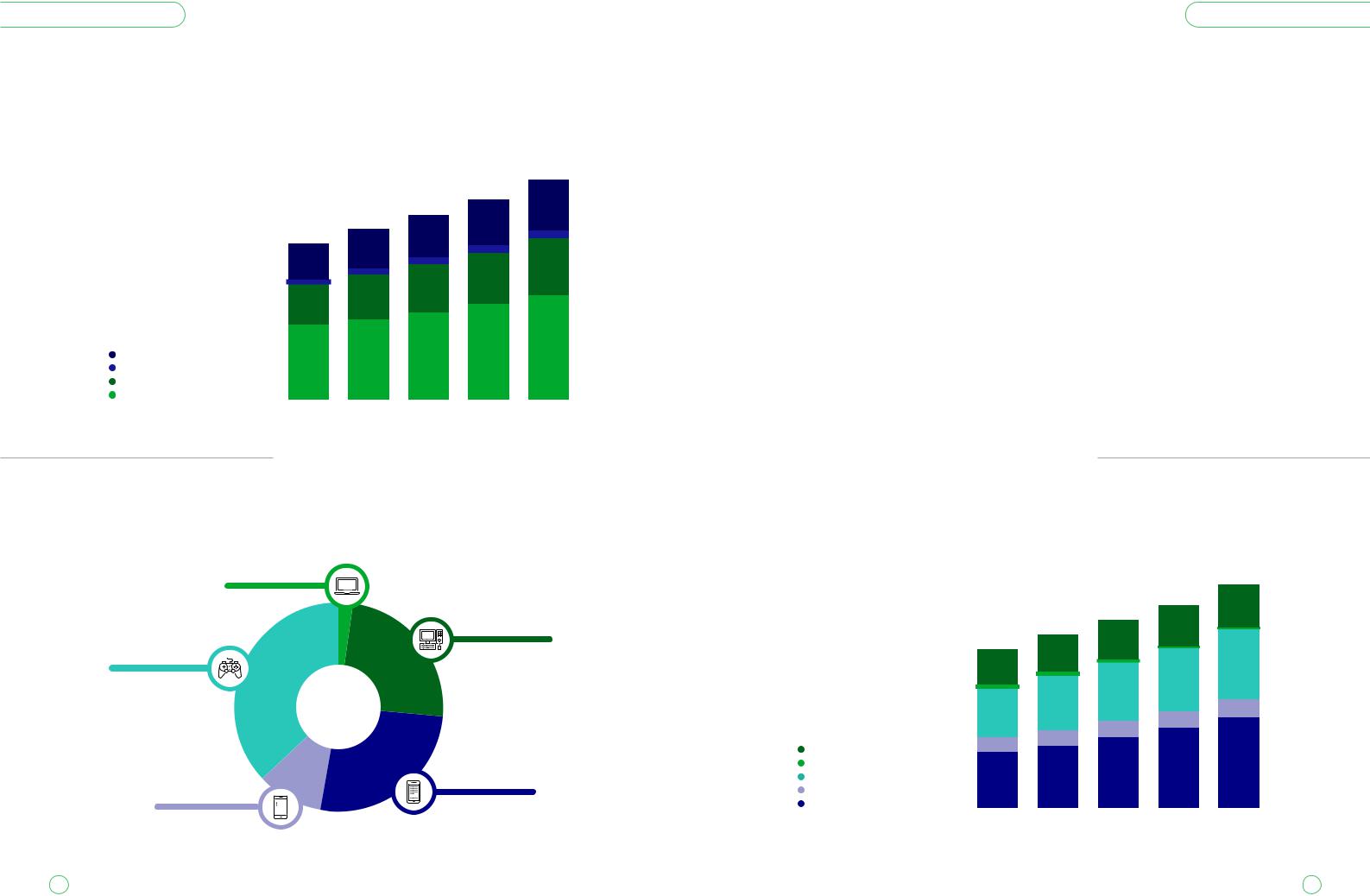
vk.com/id446425943
THE GLOBAL GAMES MARKET |
THE GLOBAL GAMES MARKET |
REGIONAL BREAKDOWN |
|
|
|
|
|
|
In 2019, mobile will again be the largest segment, generating revenues of $68.5 billion and |
||||||
OF GLOBAL GAME REVENUES |
|
|
|
|
|
||||||||
|
|
|
|
|
comprising 45% of the global games market. Of global mobile game revenues, 80%, or $54.9 |
||||||||
TOWARD 2022 |
|
|
|
|
|
|
|
||||||
|
|
|
|
|
|
|
billion, will come from smartphone games, with tablet gaming accounting for the remain- |
||||||
|
|
|
|
|
|
|
|
||||||
|
|
|
|
|
|
$196.0Bn |
ing $13.6 billion. |
|
|
|
|
|
|
|
|
|
|
|
|
Across the board, the games market is in a healthy state, with every segment showing |
|||||||
|
|
|
|
|
|
$178.2Bn |
|
||||||
|
|
|
|
|
|
|
growth. Console is the second-largest segment, boasting revenues of $47.9 billion. It will |
||||||
|
|
|
|
|
$164.6Bn |
|
22% |
||||||
|
|
|
|
|
|
grow to $61.1 billion by 2022 with a CAGR (2018-2022) of +9.7%. In total, PC games will gener- |
|||||||
|
|
|
|
$152.1Bn |
|
22% |
|
||||||
|
$138.7Bn |
22% |
4% |
4% |
ate $35.7 billion in 2019, making it the third-largest segment. Growth in downloaded/boxed |
||||||||
|
|
|
|
23% |
4% |
|
PC games is partially offset by declining browser PC revenues, as browser gamers have |
||||||
|
|
22% |
|
|
26% |
||||||||
|
|
4% |
26% |
mostly transitioned to mobile. Browser PC revenues will continue to decline from $3.5 |
|||||||||
|
|
4% |
26% |
|
|||||||||
|
|
|
|
|
billion this year to $2.2 billion in 2022, a CAGR (2018-2022) of -14.7%. |
|
|
||||||
|
|
|
|
26% |
|
|
|
|
|||||
|
|
|
|
|
|
|
|
|
|||||
|
|
26% |
|
|
|
|
|
PRESS |
|||||
|
|
|
|
|
|
48% |
48% |
|
|||||
EUROPE, MIDDLE EAST & AFRICA |
|
|
47% |
48% |
|
|
|||||||
48% |
|
|
|
||||||||||
LATIN AMERICA |
|
|
|
|
|
|
|||||||
|
|
|
|
|
|
|
|
||||||
NORTH AMERICA |
|
|
|
|
|
|
|
|
|||||
ASIA-PACIFIC |
|
|
|
|
|
|
|
|
|||||
|
|
2018 |
2019 |
2020 |
2021 |
2022 |
|
||||||
2019 GLOBAL GAMES MARKET |
|
|
|
|
SEGMENT BREAKDOWN |
||||||||
PER SEGMENT |
|
|
PRESS |
|
|||||||||
|
|
|
|
|
|
|
OF GLOBAL GAME REVENUES |
|
|
|
|
||
|
|
|
|
|
|
|
|
TOWARD 2022 |
|
|
|
|
|
|
BROWSER PC GAMES |
|
|
|
|
|
|
|
|
|
|
||
|
$3.5Bn |
|
|
|
|
|
|
|
|
|
|
|
$196.0Bn |
|
-15.1% YoY |
|
|
|
DOWNLOADED/BOXED |
|
|
|
$164.6Bn |
$178.2Bn |
19% |
||
|
|
|
|
|
|
PC GAMES |
|
|
|
|
|||
CONSOLE GAMES |
|
|
|
2% |
|
$32.2Bn |
|
$138.7Bn |
$152.1Bn |
|
20% |
1% |
|
|
|
|
|
|
|
|
|
21% |
|
|
|||
$47.9Bn |
|
|
|
|
|
|
|
|
|
1% |
|
||
|
|
|
|
|
+6.6% YoY |
|
|
21% |
|
|
|||
|
|
|
21% |
|
22% |
2% |
|
31% |
|||||
|
|
|
|
|
|
|
|
|
|||||
|
|
|
|
|
|
|
2% |
|
31% |
|
|||
+13.4% YoY |
32% |
|
|
|
|
|
|
|
3% |
|
|
||
|
2019 TOTAL |
|
|
|
|
|
31% |
|
|
||||
|
|
|
|
|
|
|
|
|
|||||
FOR |
$152.1Bn |
|
|
|
|
31% |
32% |
|
|
8% |
|||
|
|
|
|
|
|
8% |
|||||||
|
|
+9.6% |
|
|
|
|
|
|
8% |
|
|||
|
|
|
|
|
|
|
|
|
|
||||
|
|
YoY |
|
|
|
|
|
9% |
|
|
|||
|
|
|
|
|
|
|
|
|
|
||||
|
|
|
|
|
|
|
9% |
|
|
|
|||
|
|
|
|
|
|
DOWNLOADED/BOXED PC |
|
|
|
|
|||
|
|
|
|
|
|
|
|
|
|
|
|||
|
|
36% |
SMARTPHONE GAMES |
|
FOR |
|
|
|
40% |
41% |
|||
TABLET GAMES |
|
9% |
|
|
|
$54.9Bn |
|
CONSOLE |
35% |
36% |
38% |
|
|
$13.6Bn |
|
|
|
|
|
|
|
TABLET |
|
|
|
|
|
|
|
|
|
|
+11.6% YoY |
|
SMARTPHONE |
|
|
|
|
|
|
|
|
|
|
|
|
|
|
|
|
|
|
||
+5.0% YoY |
|
|
|
|
|
|
|
|
2018 |
2019 |
2020 |
2021 |
2022 |
|
|
|
|
|
|
|
|
|
|||||
14 |
GLOBAL GAMES MARKET REPORT 2019 |
©2019 Newzoo |
©2019 Newzoo |
GLOBAL GAMES MARKET REPORT 2019 |
15 |

vk.com/id446425943
3.
KEY GLOBAL
TRENDS
KEY GLOBAL TRENDS
1. A LINK TO THE PAST: PUBLISHERS CAPITALIZE ON
NOSTALGIA |
PRESS |
|
Nostalgia has always been a key selling point in the games market, with some of the biggest franchises today, including Mario, Final Fantasy, and Pokémon, born as far back as the early 1980s. Looking to capitalize on consumers’ nostalgia, companies are rereleasing and remaking retro content—and even hardware—from years gone by.
Porting older games to current hardware has always been commonplace; for example, Nintendo has traditionally ported its older titles to its handheld consoles, such as the Game Boy (Color/Advance), and to console via its Virtual Console and now Nintendo eShop. In the previous console generation (Xbox 360 and PlayStation 3), HD remasters were a possibility. Many publishers realized that consumers are willing to repurchase older titles at a discounted rate for upscaled or slightly updated visuals.
However, the current console generation has seen publishers moving away from rereleases and remasters toward outright, from-the-ground-up remakes, released at premium price points. Two beloved PlayStation platformer franchises from the 90s, Crash Bandicoot and Spyro the Dragon, have seen major success here. Activision now owns the rights to these IPs and remade the first three main games from both franchises in two trilogy collections: the Crash Bandicoot N. Sane Trilogy and the Spyro Reignited Trilogy, respectively. Similar remakes include 2018’s Shadow of the Colossus and Ratchet & Clank on PlayStation 4, Pokémon Let’s Go Eevee and Let’s Go Pikachu on
FORthe Switch, and Resident Evil 2. Each has seen critical and commercial success. There are many highly anticipated remakes on the horizon, such as Final Fantasy VII and Crash Team Racing Nitro-Fueled. Blizzard is getting involved in the PC space with Warcraft III: Reforged and World of Warcraft Classic.
Blizzard’s upcoming remakes show that capitalizing on nostalgia goes beyond shortterm profit. Remakes or remasters can reignite the passion players have (or had) for franchises and allows the publisher to bring these beloved franchises to a modern era, potentially extending the timeline of these games for another decade or more. It also offers an opportunity to modernize the revenue model of these classic titles.
Capitalizing on nostalgia offers publishers the chance to monetize games far beyond the initial success of the game but commercial and critical success isn’t the only benefit for publishers. Remaking games in this manner is less time consuming and more costeffective than designing an entirely new title. After all, the developers already have a foundation, including character design, level layout, and story, from which to build. This provides another way for companies to produce stable revenue alongside games-as-a- service offerings. It also repurposes older content for new and younger audiences, who expect to see high-fidelity visuals in games.
©2019 Newzoo |
GLOBAL GAMES MARKET REPORT 2019 |
17 |

vk.com/id446425943
KEY GLOBAL TRENDS
MINI RETRO CONSOLES TOOK THE MARKET BY STORM, BRIEFLY
On the hardware front, Nintendo kickPRESS-started a trend of companies releasing smaller versions of retro consoles, with the release of the NES Classic Edition in November 2016. It was an unexpected success and consumer demand was far higher than the initial supply, leading the company to manufacture more. Nintendo followed this up with the Super NES Classic Edition in 2017. This success inspired Sony to release the PlayStation Classic in 2018 and Sega to announce the Sega Genesis Mini (Mega Drive mini in Europe) for release in September 2019. Most recently, Capcom announced the Capcom Home Arcade, another plug-and-play arcade system including 16 classic titles and the original controller layout from 80’s-style game arcades. However, consumer demand for these smaller retro consoles already seems to be diminishing. Also, since modern consoles often come with backward compatibility, we expect the market for hardware re-releases to be limited and for retro and nostalgic software re-releases and remakes to have more of a role to play in the games market going forward.
2. THE PERFECT STORM: CLOUD GAMING TAKES OFF
Just as mobile gaming expanded the market by making games accessible to billions of people across the globe, cloud gaming has the potential to expand the market for premium games beyond the current console and PC audience. Cloud gaming presents an opportunity that was unattainable just 10 years ago: any game can be played on any
FORdevice without the consumer having to own the physical hardware required to process the game. As the tech continues to improve and cloud gaming grows, we expect an increase in the overall demand for games as new consumer groups enter the ecosystem. We also expect to see challenges and innovations in business models, game development, content discovery, engagement options, and even shakeups to gameplay itself.
The past year has seen some key players unveiling cloud gaming platforms. Faster Internet and the imminent release of 5G make the technology feasible in more markets than ever, and companies are striking when the iron is hot. Microsoft, for example, announced Project xCloud in October 2018, leaning heavily on this innovative new tech for the upcoming console generation. Earlier this year, Google unveiled Stadia, marking the tech giant’s biggest foray into the games business (outside the Google Play Store). Google is leveraging YouTube’s popularity with Stadia, including a button that shares directly to the video-streaming platform, as well as the ability for players to join streamers’ games. Google also announced its first-party development studio that will create Stadia-exclusive content. Of course, Sony is also active in the cloud gaming space and currently operates the world’s most popular cloud gaming platform, PlayStation Now, which now has more than 700,000 users.
KEY GLOBAL TRENDS
UNLIKELY PARTNERSHIPS AND AN AMBIGUOUS FUTURE
The biggest cloud providers are Amazon Web Services (AWS), Google Cloud, Microsoft Azure, IBM, and Alibaba Cloud. Interestingly, Amazon has not yet revealed plans for a cloud gaming platform or partnership, despite being one of the world’s largest cloud providers. Moreover, Microsoft and Sony signed a memorandum of understanding, with both companies agreeing to work together on their respective cloud gaming solutions. This means that Sony’s cloud gaming platform will be powered by Microsoft’s Azure. While this seems an unlikely partnership, as Sony and Microsoft have been rivals in the console space since the mid-2000s, the two companies are consolidating their efforts in part to offset the looming threat of Google Stadia.
All in all, cloud gaming is due to disrupt the market in some significant ways, including new features for consumers, new content-delivery methods, and potentially new pricing models. We dive even deeper into these areas in the Special Focus Topics section of in the paid version of this report.
3. INSTANT GAMES: BRIDGING THE GAP BETWEEN GAMING AND SOCIAL MEDIA
Instant game platforms are becoming popular across the globe. In China, Tencent’s WeChat mini games are most prominent, already solidifying themselves within the Chinese games ecosystem. In the West, Facebook Instant Games shows great potential.
FORThis has led to other Western-focused platforms, such as Snapchat, introducing similar instant games. In China, Tik Tok is also beginning to introduce them.
PRESS
MINI GAMES ROSE TO PROMINENCE IN CHINA FOLLOWING THE MINI-PROGRAM REVOLUTION
Mini programs were first introduced to Chinese smartphone users at the end of 2017. Since then, they have grown into an integral part of many residents’ lives. Suitable for apps with low-frequency usage, mini programs are less work to design and develop compared to traditional mobile applications. Unlike app stores, where extremely popular apps generate most revenues, the more widespread distribution of mini programs allows for each mini program to enjoy an equal chance of reaching new users. Notably, the most efficient way to acquire users is through group chat, where people share and recommend mini programs to friends. This shows mini programs’ heavy dependence on social networks. Game developers in China have already seen huge potential in this market, with WeChat starting to monetize mini games on Android through rewarded video ads in April 2018.
18 |
GLOBAL GAMES MARKET REPORT 2019 |
©2019 Newzoo |
©2019 Newzoo |
GLOBAL GAMES MARKET REPORT 2019 |
19 |

vk.com/id446425943
KEY GLOBAL TRENDS
FACEBOOK INSTANT GAMES SHOWS STRONG POTENTIAL
Facebook is the world’s biggest social mediaPRESSplatform. More than 2.3 billion people use it each month, with more than 1.5 billion people logging in daily. The tech giant has been involved with gaming to varying degrees throughout the past decade, but Facebook Instant Games hints at the company’s plans to leverage its massive user base to stake a claim of the $152.1 billion global games market.
When Facebook first launched Instant Games’ closed beta in November 2016, there were 17 different games available. In March 2018, however, Facebook threw open the development floodgates, opening Instant Games to any developer wanting to release a game on the platform. Now, it boasts more than 30 billion game sessions played across more than 7,000 titles. The platform has already come a long way, and all signs point to even further growth.
Facebook Instant Games is a platform-agnostic service, meaning any device compatible with the Facebook/Messenger app can also run Instant Games. Users directly access the platform’s games through Facebook’s News Feed, Messenger conversations, or other Facebook surfaces like the new Gaming tab. This means Facebook users can immediately start playing a game without installing another app. Of course, Facebook is an inherently social platform. Through Instant Games, playing titles together can be a seamless part of users’ conversations. Therefore, social games are where Facebook Instant Games’ true potential lies, and this already shows. While there are some outliers (Everwing and Slotmate), most of the platform’s top-grossing titles are social games, including Words
FORWith Friends, Draw Something, 8 Ball Pool, Quiz Planet, and Uno.
It also appears that games featuring social play have far more weekly players and higher retention rates on Instant Games. This speaks volumes for the platform’s potential going forward—especially given the rise of the games-as-a-service model. Most of the top-grossing mobile games, across most markets, all feature this model and the monetization options that come with it.
Adding to Instant Games’ potential, gaming groups are one of Facebook’s biggest and most engaged communities, with more than 100 million people actively participating in 300,000 game-related groups every month. These groups are typically conversing about all things video games. Instant Games’ most popular titles, which combine gaming with online social interaction, have major potential with this group in particular.
KEY GLOBAL TRENDS
THE PLATFORM’S POTENTIAL IN EMERGING MARKETS
All available titles on Facebook InstantPRESSGames were built in HTML5, meaning no downloads are necessary, and users can access games regardless of personal device/network constraints. This gives the platform much growth potential in emerging markets, where Internet infrastructure is more limited. Similarly, Facebook Instant Games is now available on Facebook Lite, an app that allows mobile users across the world to access Facebook on low-spec devices, and quality of Internet connection is not an issue. Compatibility with Facebook Lite makes Instant Games even more accessible in emerging markets such as India, which may have a big role to play in the continued success of the platform. After all, one-tenth of the world’s active smartphones are located in India, a country that will generate $1.5 billion in game revenues this year.
4. GAMING IS A MEANS FOR BRANDS TO REACH YOUNGER AUDIENCES
5. BREAKING BOUNDARIES: GAMING’S PLATFORM-AGNOSTIC FUTURE
6. NEW MONETIZATION MODELS NEEDED FOR A SERVICESFOCUSED GAMES MARKET
FOR7. PREMIUM GAME CONTENT RETURNS TO MOBILE
8. STORE WARS: NEW DISTRIBUTION OPTIONS ON PC EMPOWER DEVELOPERS
9. THE NEW REALITY FOR VR: A HEADSET FOR EVERY KIND OF GAMER
10. PUTTING COMMUNITIES IN THE DRIVER’S SEAT: PC GAMING’S UNIQUE VALUE PROPOSITION
20 |
GLOBAL GAMES MARKET REPORT 2019 |
©2019 Newzoo |
©2019 Newzoo |
GLOBAL GAMES MARKET REPORT 2019 |
21 |

vk.com/id446425943
4.
SPECIAL
FOCUS TOPIC
SPECIAL FOCUS TOPIC
NEWZOO’S GAMER SEGMENTATION™
THE NEW STANDARD FOR A NEW BREED OF
GAME ENTHUSIASTSPRESS
Consumer engagement with games has changed dramatically over the past 10 years. Now more multi-dimensional and fragmented than ever, gamers aren’t just playing games; watching esports and game video content is an equally important part of the puzzle. Hardware and peripheral ownership is, in many cases, another vital component for many game enthusiasts. These new dimensions of gaming demand a new segmentation that captures all its unique, passionate fans.
Personas like ‘’casual gamers’’ and ‘’hardcore gamers’’ don’t cut it anymore, only accounting for a fraction of gamers. The old way of segmenting gamers is linear, incomplete, and offers few benefits to the games business. This is why we spent the past year pouring our consumer insights experience and games market expertise into developing Newzoo’s Gamer Segmentation™ from the ground up. The result: eight unique personas that encompass all aspects of consumer engagement with games: playing, viewing, and owning. Everyone, from game publishers and hardware manufacturers to automotive and apparel brands, stands to benefit from this new standard for segmenting games enthusiasts. Brands can finally discover new personas that fit their brand, grasp a deeper understanding of their target audience’s engagement patterns, and see which groups are growing the fastest and in which markets.
FOREach of the eight personas represents a unique type of game enthusiast in the market. The personas are mutually exclusive, meaning that a person can only belong to one persona group and there is no overlap between them. The eight personas represent every consumer in the global population of game enthusiasts, based on their preferences for playing, viewing, and owning.
©2019 Newzoo |
GLOBAL GAMES MARKET REPORT 2019 |
23 |

vk.com/id446425943
SPECIAL FOCUS TOPIC
REACHING ALL SEGMENTS OF THE GAMES MARKET
Newzoo’s Gamer Segmentation features target groups that fly under the radar of traditional segmentation, revolutionizing how these unique groups of individuals are understood and approached. These groups are growing fastest, and—for the most part—have plenty of disposable income to spend. This includes Popcorn Gamers, who typically do not play many games but love watching game video content/esports. This persona, therefore, is easier to reach through mediums like Twitch and YouTube than with in-game advertising.
Another fast-growing persona is the Cloud Gamer, those who enjoy high-quality game experiences, preferably free-to-play or discounted titles, but only spend on hardware when necessary. The imminent cloud gaming platforms from Microsoft (xCloud) and Google (Stadia), which do not require the consumer to buy expensive hardware, are a
potential game changer for this group.
Backseat Viewers watch game video content or esports but rarely play games. Many consumers in this persona are lapsed gamers who once enjoyed playing games, but due to work and/or family commitments no longer have time to play.
Ultimate Gamers live and breathe games across all spectrums of the market (playing, owning, and viewing). In addition, these consumers are likely to have an interest in computers, electronics, and gadgets, and enjoy watching movies in their spare time. Compared to other personas, they are also likelier to live in a household with children.
PRESS
The Conventional Player resembles the Ultimate Gamer of 10 years ago, before the FORadvent of game video content and the meteoric rise of esports. Watching others play is of little interest to Conventional Players; still, they revel in staying up to date with the latest game releases and developments. Nothing will get in the way of this persona fulfilling their gaming needs, so owning the newest hardware and peripherals also a key
part of their engagement.
All-Round Enthusiasts are also avid gamers, playing for many hours each week. They enjoy a holistic gaming experience, combining playing games, viewing game content, and owning dedicated game hardware. While they may not be as dedicated as Ultimate Gamers, games are still serious business for All-Round Enthusiasts. They are typically full-time workers, so paying for the newest titles and hardware is no issue.
Meanwhile, Time Fillers are consumers who play games, typically on mobile, to pass the time; for example, by playing a game of Candy Crush or Clash of Clans while commuting. They rarely spend more than a few hours gaming each week and don’t see gaming as a major part of their lives.
Lastly, there is the Hardware Enthusiast. These consumers are casual about gaming and don’t play many games each week. When they do play games, however, hardware is vital for their experience. They simply cannot turn a blind eye to the newest gaming gear and peripherals, so they spend big on these products. And their love of computers,
SPECIAL FOCUS TOPIC
electronics, and gadgets extends beyond games.
|
PRESS |
The size of each persona varies per region and per country, as do the demographics per |
|
group. Using our Consumer Insights for games, esports, and mobile, we can dive deeper |
|
into what motivates these groups to engage with games. |
|
You can understand and explore combinations of engagement that are most common |
|
within your user base or target group. You can also grasp a deeper understanding of how |
|
people engage with games and their behavior patterns outside of gaming. For example, |
|
use our data to find out their demographics, media behavior, brand preferences, hobbies |
|
and interests, and spending behavior. The new segmentation and its personas give |
|
brands a complete picture of how modern consumers are engaging with gaming content |
|
through playing, viewing, and owning. |
|
FOR |
|
24 |
GLOBAL GAMES MARKET REPORT 2019 |
©2019 Newzoo |
©2019 Newzoo |
GLOBAL GAMES MARKET REPORT 2019 |
25 |

vk.com/id446425943
5.
RANKING
RANKING
TOP 35 PUBLIC COMPANIES 2018
In 2018, the top 35 public game companies generated $114.0 billion, up from $100.2 billion in 2017. Together, these top 35 companies accounted for 82% of 2018’s global games market revenues—the same share as 2017. Tencent was again the top company, with revenues of $19.8 billion and year-on-year growth of +9%. Compared to the previous year (+51% from 2016 to 2017), the slowed growth for 2018 is a direct result of China’s licensing freeze. The company is hoping to offset this in 2019 by monetizing its PUBG Mobile userbase through new title Game for Peace. The top five companies alone accounted for 43% of global games revenues. Console showed especially strong growth, predominantly driven by the three platform holders: Microsoft, Sony, and Nintendo.
|
RANK |
COMPANY |
Q1 ($M) |
Q2 ($M) |
Q3 ($M) |
Q4($M) |
2018 ($M) |
YOY GROWTH |
||
1 |
TENCENT |
5,502 |
4,687 |
4,903 |
4,641 |
19,733 |
9% |
|
||
|
|
|
|
|
|
|
|
|
|
|
2 |
SONY |
3,079 |
3,117 |
3,612 |
4,410 |
14,218 |
41% |
|
||
|
|
|
|
|
|
|
|
|
|
|
3 |
MICROSOFT |
2,019 |
2,033 |
2,311 |
3,391 |
9,754 |
32% |
|
||
|
|
|
|
|
|
|
|
|
|
|
4 |
APPLE |
2,091 |
2,303 |
2,524 |
2,535 |
9,453 |
18% |
|
||
|
|
|
|
|
|
|
|
|
|
|
5 |
ACTIVISION |
1,872 |
1,537 |
1,352 |
2,131 |
6,892 |
6% |
|
||
BLIZZARD |
|
|||||||||
|
|
|
|
|
|
|
|
|
|
|
6 |
1,383 |
1,463 |
1,522 |
2,129 |
6,497 |
22% |
|
|||
|
|
|
|
|
|
|
|
|
|
|
7 |
NETEASE |
1,346 |
1,546 |
1,590 |
1,694 |
6,177 |
11% |
|
||
|
|
|
|
|
|
|
|
|
|
|
8 |
EA |
1,582 |
1,137 |
1,286 |
1,289 |
5,294 |
4% |
|
||
|
|
|
|
|
|
|
|
|
|
|
9 |
NINTENDO |
697 |
730 |
|
751 |
2,111 |
4,288 |
36% |
|
|
|
|
|
|
|
|
|
|
|
|
|
10 |
BANDAI NAMCO |
807 |
567 |
|
693 |
674 |
2,741 |
13% |
|
|
|
|
|
|
|
|
|
|
|
|
|
11 |
TAKETWO |
450 |
388 |
|
493 |
1,249 |
2,580 |
35% |
|
|
INTERACTIVE |
|
|
||||||||
|
|
|
|
|
|
|
|
|
|
|
|
|
|
|
|
|
|
|
|
|
|
12 |
NEXON |
803 |
424 |
|
615 |
409 |
2,252 |
8% |
|
|
|
|
|
|
|
|
|
|
|
|
|
13 |
UBISOFT |
666 |
449 |
|
416 |
691 |
2,221 |
3% |
|
|
|
|
|
|
|
|
|
|
|
|
|
14 |
NETMARBLE |
475 |
469 |
|
493 |
456 |
1,893 |
-17% |
|
|
|
|
|
|
|
|
|
|
|
|
|
15 |
WARNER BROS |
404 |
432 |
|
435 |
564 |
1,835 |
-5% |
|
|
|
|
|
|
|
PRESS |
|
||||
16 |
SQUARE ENIX |
425 |
288 |
|
447 |
423 |
1,583 |
-9% |
|
|
|
|
|
|
|
|
|
|
|
|
|
17 |
NCSOFT |
366 |
322 |
|
330 |
324 |
1,343 |
-8% |
|
|
|
|
|
|
|
|
|
|
|
|
|
18 |
CYBER AGENT |
359 |
315 |
|
327 |
323 |
1,324 |
7% |
|
|
|
|
|
|
|
|
|
|
|
|
|
19 |
MIXI |
410 |
261 |
|
282 |
268 |
1,222 |
-17% |
|
|
|
|
|
|
|
|
|
|
|
|
|
20 |
KONAMI |
272 |
267 |
|
326 |
346 |
1,210 |
12% |
|
|
|
|
|
|
|
|
|
|
|
|
|
21 |
ARISTOCRAT |
167 |
326 |
|
326 |
326 |
1,146 |
187% |
|
|
LEISURE |
|
|
||||||||
|
|
|
|
|
|
|
|
|
|
|
|
|
|
|
|
|
|
|
|
|
|
22 |
37 INTERACTIVE |
232 |
240 |
|
319 |
300 |
1,091 |
27% |
|
|
|
|
|
|
|
|
|
|
|
|
|
23 |
PERFECT WORLD |
197 |
208 |
|
206 |
285 |
897 |
3% |
|
|
|
|
|
|
|
|
|
|
|
|
|
24 |
SEGA |
184 |
189 |
|
219 |
240 |
832 |
-3% |
|
|
|
|
|
|
|
|
|
|
|
|
|
25 |
CAPCOM |
384 |
122 |
|
181 |
121 |
809 |
49% |
|
|
|
|
|
|
|
|
|
|
|
|
|
26 |
CENTURY |
125 |
228 |
|
222 |
232 |
807 |
573% |
|
|
HUATONG |
|
|
||||||||
|
|
|
|
|
|
|
|
|
|
|
|
|
|
|
|
|
|
|
|
|
|
27 |
DISNEY |
195 |
193 |
|
191 |
216 |
795 |
-9% |
|
|
|
|
|
|
|
|
|
|
|
|
|
28 |
DENA |
223 |
191 |
|
188 |
175 |
777 |
-13% |
|
|
|
|
|
|
|
|
|
|
|
|
|
29 |
IGG |
194 |
194 |
|
180 |
180 |
749 |
23% |
|
|
|
|
|
|
|
|
|
|
|
|
|
30 |
145 |
164 |
|
160 |
219 |
688 |
-3% |
|
||
|
|
|
|
|
|
|
|
|
|
|
31 |
ZYNGA |
162 |
165 |
|
168 |
177 |
671 |
6% |
|
|
|
|
|
|
|
|
|
|
|
|
|
32 |
SEA GROUP |
111 |
108 |
|
113 |
306 |
637 |
74% |
|
|
(GARENA) |
|
|
||||||||
|
|
|
|
|
|
|
|
|
|
|
|
FOR |
|
|
|
|
|
|
|
||
GUNGHO |
129 |
|
130 |
171 |
563 |
-19% |
|
|||
33 |
ENTERTAINMENT |
134 |
|
|
||||||
|
|
|
|
|
|
|
|
|
|
|
|
|
|
|
|
|
|
|
|
|
|
34 |
GREE INC. |
138 |
146 |
|
132 |
125 |
540 |
-16% |
|
|
|
|
|
|
|
|
|
|
|
|
|
35 |
YOUZU |
132 |
121 |
|
119 |
146 |
518 |
5% |
|
|
INTERACTIVE |
|
|
||||||||
|
|
|
|
|
|
|
|
|
|
|
|
|
|
|
|
|
|
|
|
|
|
©2019 Newzoo |
GLOBAL GAMES MARKET REPORT 2019 |
27 |

vk.com/id446425943
Newzoo is the leading global provider of games and esports analytics. We help some of the world’s largest entertainment, technology, and media companies target their audience, track competitors, spot opportunities, and make strategic and financial decisions.
OUR USE CASES (SOLUTIONS)
|
|
|
|
|
|
|
|
|
|
EXPLORE |
CREATE |
|
OPTIMIZE |
|
|||
|
• Trends |
• Strategies |
|
• Marketing |
|
|||
|
• Industries |
• Business plans |
|
• Investments |
|
|||
|
• Markets |
• New products |
|
• Product dev |
|
|||
|
• Forecasts |
• Target groups |
|
• Local efforts |
|
|||
|
|
|
|
|
|
|
|
|
OUR EXPERTISE |
|
|
|
|
|
|
||
|
|
|
|
|
MARKET FORECASTS |
|
||
CONSUMER INSIGHTS |
|
TRACKING DATA |
|
|
||||
|
|
|
Metrics that come straight |
|
Our landmark reports. |
|
||
|
|
|
from the source. Track |
|
In-depth market forecasts |
|
||
|
|
|
your market, optimize |
|
and trends ensure you |
|
||
|
|
|
marketing, and product |
|
never miss an opportunity. |
|
||
|
|
|
PRESS |
|
||||
|
|
|
development while keeping |
|
Includes quarterly updates |
|
||
|
|
|
an eye out for blue-ocean |
|
and access to our forecast |
|
||
|
|
|
opportunities. |
|
dashboards. |
|
||
|
|
|
|
|
|
|
|
|
|
|
|
|
|
|
|
|
|
NEWZOO CLIENT PORTAL
OUR ONE-STOP SHOP
Access to all our reports, dashboards, and custom analysis decks that we create for you in one central place.
QUESTIONS?
Tom Wijman
Sr. Market Analyst tom@newzoo.com
28 |
GLOBAL GAMES MARKET REPORT 2019 |
©2019 Newzoo |

vk.com/id446425943
Capital Markets in 2030
The future of equity capital markets
Written by

vk.com/id446425943
Foreword
Ross Hunter
IPO Centre Leader
Partner, PwC UK
Welcome to Capital Markets in 2030, a report exploring the changing dynamics in global equity capital markets.
Our initial survey of global executives was conducted in 2011. At that time, strong growth was anticipated in emerging economies and, by association, in their equity markets, to the point that they were expected to become the leading global exchanges for new issues in the medium term. We can now see that the New York, London and Hong Kong exchanges are proving to be significantly more resilient than had been anticipated in 2011, enjoying strong momentum in recent years and now expected to maintain their lead.
Although the growth of emerging market exchanges has been more subdued than anticipated in 2011, Chinese and Indian companies are still expected to dominate future new issues. While further progress in the key emerging market economies will support the growth of their exchanges, the pace of the shift in balance to these exchanges has perhaps moderated.
Technology companies have featured strongly in initial public offering (IPO) activity in recent years. This is set to last, as the sector continues to generate significant demand for equity in public markets, and the competition between exchanges to attract ‘unicorns’ and ‘new economy’ companies intensifies, particularly between the US and China (mainland China and Hong Kong).
New York, London and Hong Kong exchanges are proving to be significantly more resilient than had been anticipated in 2011, enjoying strong momentum
in recent years and now expected to maintain their lead.
Ross Hunter
IPO Centre Leader
Alongside this, the range of capital raising options has increased significantly in recent years as the established private equity and venture capital pools have grown, and as they are complemented by numerous alternatives.
Ultimately, in our view, the public equity markets remain the natural destination for many companies, and can play a vital role in the healthy functioning of the global economy. The challenge for the exchanges is how they can adapt to the changing landscape, competing but also collaborating with one another, and complementing other financing alternatives to support the provision of capital across the world.
For companies, the choice of credible exchanges for public listings, as well as a range of private funding options, will continue to expand, offering ever more alternatives when they seek to raise capital.

vk.com/id446425943
Contents
Executive summary |
4 |
Then and now: Are the markets on trend? |
5 |
Which sectors and where? |
6 |
Which markets attract foreign issuers? |
10 |
Looking to 2030 |
12 |
Which countries will lead capital raising in 2030? |
12 |
What drives the choice of exchange? |
15 |
What is holding back EM exchanges? |
16 |
Are public equity markets under threat? |
18 |
Private markets: To rival or to complement? |
19 |
Conclusion |
21 |
About this report |
22 |
vk.com/id446425943
Executive summary
Global capital markets reached new post–financial crisis highs in 2018. This expansion was largely driven by the US economy. Companies now have to consider a growing range of issues that may affect the shape of future capital market activity, such as an increasing focus by regulators and investors on sustainability and governance, and mounting concerns around deglobalisation, rising populism and greater geopolitical risks.
70%
of respondents agree that most successful companies would still choose to go public at some point in their life cycle.
In 2018, The Economist Intelligence Unit conducted a followup to a 2011 survey on behalf of PwC, asking nearly 400 executives at companies from across the globe for their views on the factors that are defining the development of global equity capital markets. This report marks the evolution of these industry leaders’ views.
The 2011 report reflected a degree of post–financial crisis optimism, particularly for emerging market (EM) equity markets. Given the growth dynamics at that time, expectations were for EMs — particularly China and India — to increasingly dominate global equity markets in terms of issuance, sources of capital and the influence of their stock exchanges. The latest survey does demonstrate a continued recognition of the growing role of EMs, but also reflects a sometimes radical modification of business leaders’ perspectives.
•Although developed market (DM) exchanges continue to be favoured for listing, their lead over EMs has narrowed significantly since 2011. The dominance of the New York Stock Exchange (NYSE), the Nasdaq, the London Stock Exchange (LSE) and the Hong Kong Stock Exchange (HKEX) is not as great as before, with Indian exchanges, Shanghai’s SSE and Brazil’s Bovespa moving up the ranks, in recognition of the growing maturity of EM exchanges. Other exchanges that became more attractive are the Australian Securities Exchange (ASX) and Singapore Exchange (SGX), reflecting the growing importance of the Southeast Asia region.
55%
of respondents feel the most attractive private funding option is private equity.
•When looking towards 2030, although our respondents still expect companies from China and India to dominate issuance, views regarding the leading exchanges have changed dramatically. The same four exchanges, NYSE, Nasdaq, LSE and HKEX, are expected to maintain their leading position, reflecting their unmatched levels of resilience and liquidity advantages. In 2011, the medium-term view of the top four exchange destinations was very different — with Shanghai in the top spot, Indian exchanges at number three and Brazil’s Bovespa in fourth place.
•Liquidity remains the top priority (selected as most important by 49% of respondents) when choosing a listing location. Respondents are increasingly focused on valuations (32%) and concerned about the costs of listing (29%). Meanwhile, stock market ecosystems and the size of the investor base have become relatively less important to participants.
•Companies’ options for raising capital have increased.
Some 76% of respondents believe that companies in both DMs and EMs have more choices of both public and private financing routes.
•Private markets are seen as complementary to public markets, not as rivals. Seventy percent of respondents feel that the traditional public listing is becoming a less important source of funding. The most attractive private funding option, selected by 55% of respondents, is private equity. Notwithstanding that finding, 70% agree that most successful companies would still choose to go public at some point in their life cycle.
4 | Capital Markets in 2030 | PwC

vk.com/id446425943
Then and now: Are the markets on trend?
In 2011, survey respondents thought that EM exchanges, most notably China and India, would grow rapidly to rival — if not displace — DM exchanges, particularly London and New York.
The expectation was of high growth in the market capitalisation of companies listed on EM stock exchanges. This was based on overall market bullishness about the rise of EMs and their
increasing share of global GDP, coupled with deeper domestic capital capacity and additional opportunities for access by foreign investors. The market capitalisation of companies
on Chinese exchanges was forecast to outstrip those on US exchanges by 2030. Evidence suggests that EMs are falling behind on this trend line.
Figure 1: Ten largest exchanges by market capitalisation as at December 2018
|
309 |
|
|
|
|
|
|
|
|
|
|
|
|
25,000 |
|
|
|
|
|
|
|
|
|
300 |
|
|
|
|
|
|
|
|
|
|
|
|
|
|
|
20,000 |
|
|
|
|
|
|
|
|
|
250 |
|
|
|
|
|
|
|
180 |
|
|
|
|
200 |
IPO |
Market cap US$bn |
15,000 |
|
|
|
|
|
|
|
|
US$bn 18-2011 value |
||
152 |
|
|
|
|
|
|
|
|
|
|||
|
|
|
|
|
|
|
|
|
|
|||
|
|
|
129 |
|
|
|
|
|
|
150 |
||
10,000 |
|
96 |
|
89 |
|
|
|
|
|
|
||
|
|
|
|
|
82 |
|
|
100 |
||||
|
|
|
|
|
|
|
|
|
||||
|
|
|
|
|
|
52 |
|
|
|
|
||
|
5,000 |
|
|
|
|
|
|
|
|
|
|
|
|
|
|
|
|
|
|
|
25 |
31 |
50 |
|
|
|
|
|
|
|
|
|
|
|
|
|||
|
0 |
NASDAQ |
Japan |
LSE |
Shanghai |
Hong |
Euronext |
Shenzhen |
BSE |
TMX |
- |
|
|
NYSE |
|
|
|||||||||
|
|
|
|
|
|
Kong |
|
|
|
|
|
|
|
|
2011 market cap |
|
Incremental 2018 market cap |
IPO values |
|
|
|||||
Source: World Federation of Exchanges (WFE), exchange data (for LSE only), Dealogic
Note: WFE data includes only domestic market capitalisation
The slower-than-expected growth of EM exchanges is demonstrated when comparing the sizes of the US and Greater China exchanges now and in 2011. The combined US domestic market caps total US$30.4tn; for mainland China and Hong Kong, they total US$10.1tn. In 2011, it was US$15.6tn and US$5.7tn, respectively. US exchanges are now three times the size of their Chinese counterparts, compared with 2.7 times in 2011. The growth of the US market has outstripped expectations, while the growth of China and other EMs has lagged.
In terms of capital raised, the US, London and Hong Kong remain the pre-eminent international centres; mainland China exchanges also show strong growth.
In addition to representing a significant proportion of the new capital raised, the US market has been the major beneficiary of a dramatic increase in technology-related stock valuations. Largely as a result of that, the US S&P 500 index has doubled since 2007, although prices have come under pressure since late autumn 2018.
PwC | Capital Markets in 2030 | 5

vk.com/id446425943
Which sectors and where?
Initial public offering (IPO) activity since 2011 has been heavily influenced by the rise of ‘new economy’ companies. As reflected in Figure 2, technology and financials dominated the listing activity on the leading exchanges in 2016–18. Other notable listings include the IPO of Softbank, which raised US$21.3bn on the Tokyo Stock Exchange in December 2018, the US$5.2bn IPO of Siemens Healthineers and the US$4.4bn IPO of Knorr-Bremse on the Deutsche Börse.
Figure 2: Top IPOs by sector in London, New York, Hong Kong and Shanghai, 2016–18
London 

New York 

Hong Kong 

Shanghai 

0% 10% 20% 30% 40% 50% 60% 70% 80% 90%100%
 Financial
Financial  Technology
Technology  Other
Other
Source: Dealogic
The geographical and cultural proximity for mainland investors to invest via the Stock Connect channel should entice companies to list in Hong Kong.
James Fok
Head of Group Strategy
HKEX
6 | Capital Markets in 2030 | PwC
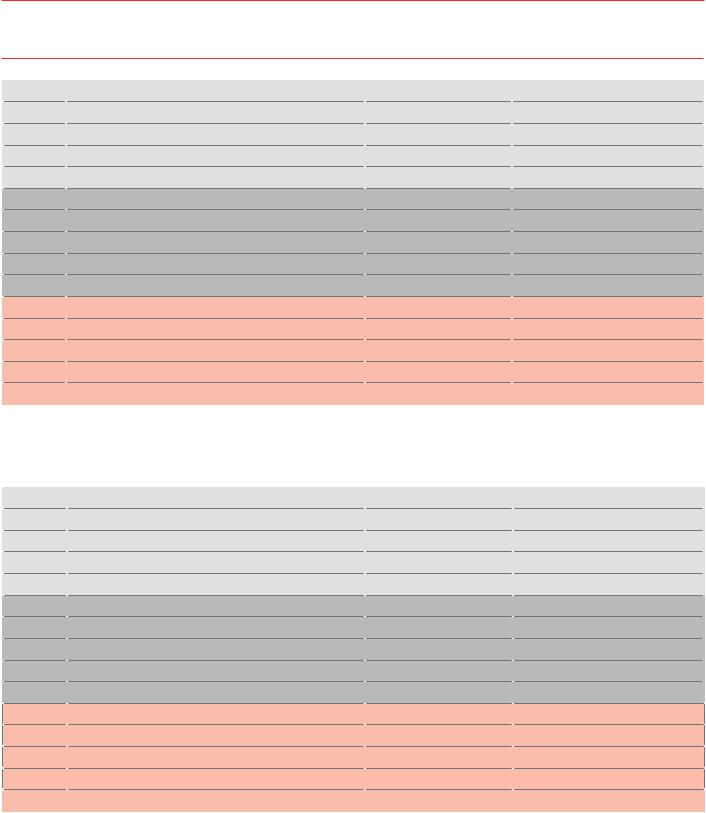
vk.com/id446425943
Figure 3: Top IPOs in London, New York, Hong Kong and Shanghai in 2016–18
London
Year |
IPO |
Total amount US$m |
Sector |
2018 |
Aston Martin Lagonda Global Holdings plc |
1,407 |
Automotive |
|
Smithson Investment Trust plc |
1,084 |
Finance |
|
Vivo Energy plc |
819 |
Oil & Gas |
|
Avast plc |
816 |
Computers & Electronics |
|
Nova Ljubljanska Banka |
764 |
Finance |
2017 |
Allied Irish Banks Plc |
3,832 |
Finance |
|
EN+ Group plc |
1,500 |
Utility & Energy |
|
J2 Acquisition Ltd |
1,210 |
Finance |
|
Sherborne Investors (Guernsey) C Ltd |
906 |
Finance |
|
BioPharma Credit plc |
762 |
Finance |
2016 |
ConvaTec Group plc |
1,939 |
Healthcare |
|
CYBG plc |
566 |
Finance |
|
Metro Bank plc |
564 |
Finance |
|
Countryside Properties plc |
506 |
Real Estate/Property |
|
Civitas Social Housing plc |
436 |
Real Estate/Property |
New York (NYSE and Nasdaq) |
|
|
|
Year |
IPO |
Total amount US$m |
Sector |
2018 |
AXA Equitable Holdings Inc |
3,157 |
Insurance |
|
PagSeguro Digital Ltd |
2,606 |
Computers & Electronics |
|
iQIYI Inc |
2,424 |
Telecommunications |
|
Pinduoduo Inc |
1,743 |
Computers & Electronics |
|
Elanco Animal Health Inc |
1736 |
Healthcare |
2017 |
Snap Inc |
3,910 |
Computers & Electronics |
|
Altice USA Inc |
2,152 |
Telecommunications |
|
Invitation Homes Inc |
1,771 |
Real Estate/Property |
|
Loma Negra CIASA |
1,097 |
Construction/Building |
|
Silver Run Acquisition Corp II |
1,035 |
Finance |
2016 |
ZTO Express (Cayman) Inc |
1,406 |
Transportation |
|
LINE Corp |
1,322 |
Computers & Electronics |
|
Athene Holding Ltd |
1,242 |
Insurance |
|
MGM Growth Properties LLC |
1,208 |
Real Estate/Property |
|
US Foods Holding Corp |
1,176 |
Food & Beverage |
PwC | Capital Markets in 2030 | 7
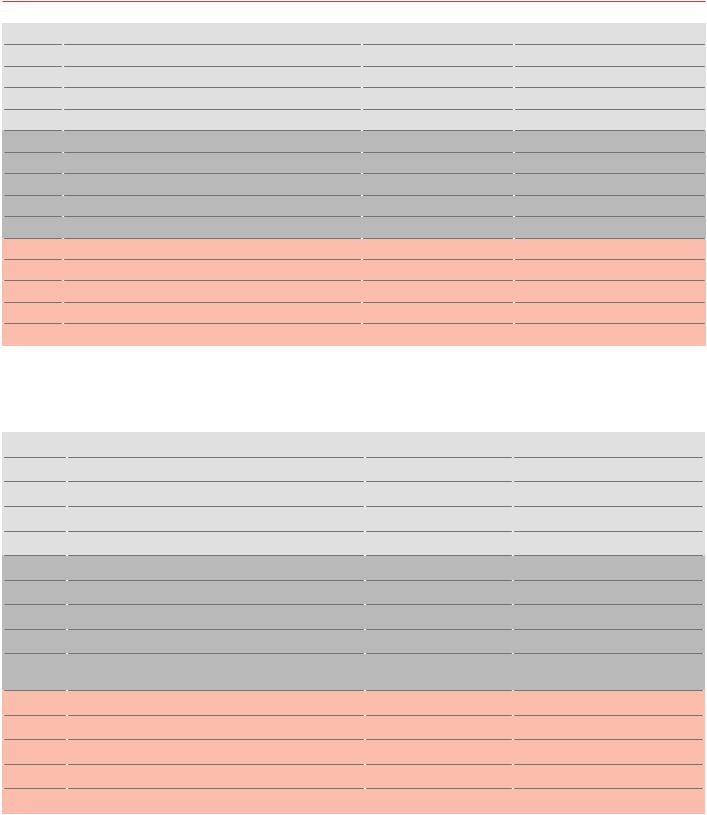
vk.com/id446425943
Hong Kong
Year |
IPO |
Total amount US$m |
Sector |
|
2018 |
China Tower Corp Ltd |
7,491 |
Telecommunications |
|
|
Xiaomi Corp |
5,430 |
Telecommunications |
|
|
Meituan Dianping |
4,222 |
Computers & Electronics |
|
|
Ping An Healthcare & Technology Co Ltd |
1,118 |
Computers & Electronics |
|
|
Jiangxi Bank Co Ltd |
1,095 |
Finance |
|
2017 |
ZhongAn Online P & C Insurance Co Ltd |
1,754 |
Insurance |
|
|
China Literature Ltd |
1,227 |
Computers & Electronics |
|
|
Guangzhou Rural Commercial Bank Co Ltd |
1,191 |
Finance |
|
|
Zhongyuan Bank Co Ltd |
1,190 |
Finance |
|
|
Yixin Group Ltd |
867 |
Computers & Electronics |
|
2016 |
Postal Savings Bank of China Co Ltd |
7,625 |
Finance |
|
|
China Resources Pharmaceutical Group Ltd |
1,941 |
Healthcare |
|
|
China Zheshang Bank Co Ltd |
1,938 |
Finance |
|
|
BOC Aviation Ltd |
1,126 |
Finance |
|
|
China Securities Co Ltd |
1,057 |
Finance |
|
Shanghai |
|
|
|
|
|
|
|
|
|
Year |
IPO |
Total amount US$m |
Sector |
|
|
|
|
|
|
2018 |
Foxconn Industrial Internet Co Ltd |
4,257 |
Computers & Electronics |
|
|
Hebei Yangyuan ZhiHui Beverage Co Ltd |
669 |
Food & Beverage |
|
|
Jiangsu Financial Leasing Co Ltd |
636 |
Finance |
|
|
Bank of Changsha Co Ltd |
399 |
Finance |
|
|
Bank of Chengdu Co Ltd |
385 |
Finance |
|
2017 |
Caitong Securities Co Ltd |
620 |
Finance |
|
|
Huaneng Lancang River Hydropower Co Ltd |
589 |
Utility & Energy |
|
|
Zheshang Securities Co Ltd |
409 |
Finance |
|
|
Shandong Publishing & Media Co Ltd |
409 |
Publishing |
|
|
Jiangsu Provincial Agricultural Reclamation & Develop- |
351 |
Agribusiness |
|
|
ment Co Ltd |
|||
|
|
|
|
|
2016 |
Bank of Shanghai Co Ltd |
1,599 |
Finance |
|
|
Bank of Jiangsu Co Ltd |
1,095 |
Finance |
|
|
Huaan Securities Co Ltd |
744 |
Finance |
|
|
Triangle Tyre Co Ltd |
661 |
Automotive |
|
|
Bank of Guiyang Co Ltd |
640 |
Finance |
|
Source: Dealogic
8 | Capital Markets in 2030 | PwC

vk.com/id446425943
In terms of IPO values per exchange, there has been a significant shift back to DMs over the past seven years. The combined value of Shanghai, Shenzhen and Hong Kong IPOs in 2016–18 was US$142.5bn; for NYSE and Nasdaq, it was marginally less, at US$138.6bn. For 2009–11, the three-year period preceding our previous survey, the figures were US$250.1bn and US$128.9bn, respectively.
Hong Kong IPO proceeds significantly outweighed Shanghai and Shenzhen combined IPO funds raised in 2018, although for the 2016–18 period, mainland China exchanges marginally led the way. This makes it clear that Chinese companies are increasingly finding access to sufficient sources of capital on the mainland. As noted by James Fok, Head of Group Strategy at the HKEX, however, the Hong Kong route offers additional advantages to company founders in terms of ease of sell-down and political de-risking. He also says that “the geographical and cultural proximity for mainland investors to invest via the Stock Connect channel should entice companies to list in Hong Kong.”
The new technology wave and its impact on global capital markets
Looking to 2030, PwC anticipates that technology will remain the most important sector.
Historically, the US market has been a more attractive environment for technology companies, with better valuations and a more knowledgeable investor base, attracting the lion’s share of Chinese technology IPOs, including Alibaba’s recordbreaking US$25bn IPO in 2014. Increasing efforts by leading financial centres to win over such companies will continue to intensify competition between the New York and China (mainland China and Hong Kong) exchanges in particular. Listings of companies such as Xiaomi and Meituan in Hong Kong in 2018 are evidence of this.
A number of recent market and regulatory developments can be expected to help attract more IPOs to Hong Kong and mainland Chinese exchanges, away from the US market:
•The amendment by HKEX of IPO rules in April 2018 to allow dual-class shares for listing companies gives certain shareholders, such as company founders, voting power beyond the proportion of their equity holding. This is popular with ‘new economy’ companies and was previously available only in the US.
•Changes to the HKEX listing rules to relax the three-year profitability requirements for biotech companies paved the way for more of these firms to list in Hong Kong rather than the long-established US market.
•Mainland China is now allowing global technology companies easier access to domestic investors. Authorities have endorsed the Chinese depositary receipts scheme, which will allow Chinese investors to hold a form of shares in firms listed abroad. This scheme is currently available only to the largest companies.
•The Shanghai exchange is moving to a registration process prior to listing, similar to Hong Kong and the US, which is expected to reduce the current lengthy wait for new issuers. Notably, in January 2019 the exchange unveiled trading rules for its much anticipated Technology Innovation Board. It will now allow unprofitable tech firms, including pre-revenue biotech startups, as well as the companies with a dualclass shareholding structure, to list on the new board, giving the Shanghai bourse greater freedom to attract promising technology startups away from New York and Hong Kong.
If local regulatory constraints are alleviated, domestic markets might prove more attractive for fast-growing Chinese
companies, given how well Chinese investors understand these companies and the potential depth of their home market.
PwC | Capital Markets in 2030 | 9

vk.com/id446425943
Which markets attract foreign issuers?
When survey respondents were asked which exchanges they think issuers consider beyond their home exchange when planning an IPO now, DM exchanges continued to dominate, although the proportion favouring EM exchanges has increased significantly since 2011 (see Figure 4).
Figure 4: Which of the following exchanges do you think issuers consider (beyond their home exchange) now when planning an IPO?
NYSE |
|
|
|
|
|
|
|
|
|
|
|
|
|
|
|
|
38% |
|
|
|
|
|
|
|
|
|
|
|
|
|
|
|
|
||
London Stock Exchange |
|
|
|
|
|
|
|
|
|
|
|
|
|
|
|
34% |
|
|
|
|
|
|
|
|
|
|
|
|
|
|
|
|
|
||
Nasdaq |
|
|
|
|
|
|
|
|
|
|
|
|
|
|
32% |
|
|
|
|
|
|
|
|
|
|
|
|
|
|
|
|
|
|||
Hong Kong Stock Exchange |
|
|
|
|
|
|
|
|
|
|
|
|
|
22% |
|
|
|
|
|
|
|
|
|
|
|
|
|
|
|
|
|
|
|
||
Indian exchanges (Bombay Stock Exchange and |
|
|
|
|
|
|
|
|
|
|
|
|
18% |
|
|
|
|
|
|
|
|
|
|
|
|
|
|
|
|
|
|
|
|
||
National Stock Exchange of India) |
|
|
|
|
|
|
|
|
|
|
|
|
|
|
|
|
|
|
|
|
|
|
|
|
|
|
|
|
17% |
|
|
|
|
||
Euronext |
|
|
|
|
|
|
|
|
|
|
|
|
|
|
|
||
|
|
|
|
|
|
|
|
|
|
|
|
|
|
|
|||
Australian Securities Exchange |
|
|
|
|
|
|
|
|
|
|
15% |
|
|
|
|
||
|
|
|
|
|
|
|
|
|
|
|
|
|
|
||||
Deutsche Börse |
|
|
|
|
|
|
|
|
|
14% |
|
|
|
|
|
||
|
|
|
|
|
|
|
|
|
|
|
|
|
|
||||
Shanghai Stock Exchange |
|
|
|
|
|
|
|
|
13% |
|
|
|
|
|
|
||
|
|
|
|
|
|
|
|
|
|
|
|
|
|
||||
Johannesburg Stock Exchange |
|
|
|
|
|
|
|
12% |
|
|
|
|
|
|
|
||
|
|
|
|
|
|
|
|
|
|
|
|
|
|
||||
Singapore Exchange |
|
|
|
|
|
|
11% |
|
|
|
|
|
|
|
|||
|
|
|
|
|
|
|
|
|
|
|
|
|
|||||
Mexican Bolsa |
|
|
|
|
|
10% |
|
|
|
|
|
|
|
|
|
||
|
|
|
|
|
|
|
|
|
|
|
|
|
|
||||
Bovespa (Brazil) |
|
|
|
|
9% |
|
|
|
|
|
|
|
|
|
|
||
|
|
|
|
|
|
|
|
|
|
|
|
|
|
||||
Nigeria Stock Exchange |
|
|
|
5% |
|
|
|
|
|
|
|
|
|
|
|
|
|
|
|
|
|
|
|
|
|
|
|
|
|
|
|
|
|
||
Toronto Stock Exchange |
|
|
4% |
|
|
|
|
|
|
|
|
|
|
|
|
|
|
|
|
|
|
|
|
|
|
|
|
|
|
|
|
|
|||
Tokyo Stock Exchange |
|
2% |
|
|
|
|
|
|
|
|
|
|
|
|
|
|
|
|
|
|
|
|
|
|
|
|
|
|
|
|
|
|
|||
Moscow Exchange |
|
2% |
|
|
|
|
|
|
|
|
|
|
|
|
|
|
|
|
|
|
|
|
|
|
|
|
|
|
|
|
|
|
|||
Korea Exchange |
|
2% |
|
|
|
|
|
|
|
|
|
|
|
|
|
|
|
|
|
|
|
|
|
|
|
|
|
|
|
|
|
|
|||
|
|
|
|
|
|
|
|
|
|
|
|
|
|
|
|
|
|
Source: The Economist Intelligence Unit
The biggest gains were for Indian exchanges, with 18% selecting those now versus 5% in 2011; Shanghai increased from 4% to 13%; and Brazil’s Bovespa was selected by 9% today versus 5% in 2011. Other exchanges that became more attractive were Australian Securities Exchange (ASX) (from 5% to 15%) and Singapore Exchange (SGX) (from 6% to 11%). This change in view since 2011 reflects the strong performance of the Indian market, particularly in 2017 and 2018, and the growing importance of ASX and SGX as regional hubs for Southeast Asia.
Although Greater China remains the primary Asian market, India has seen significant increases in IPO activity after a period of market downturn. India may also benefit from concerns by Asian equity investors over the US’s and China’s growing trade rift, as India is less involved in regional supply chains than other major Asian countries such as China and South Korea.
10 | Capital Markets in 2030 | PwC

vk.com/id446425943
Is the Indian market starting to fulfil its potential?
In 2017–18, 335 IPOs raised US$17.4bn, much more than in the prior five years. This is due to several factors. Political stability under Narendra Modi’s government and a positive economic outlook resulted in a number of large Indian IPOs coming to market in recent years, most notably in the insurance sector. Positive changes to the Indian capital market regulations further contributed to IPO momentum.
India is expected to continue generating healthy levels of IPO activity as a result of its positive economic outlook and deepening domestic liquidity. The uncertainty surrounding this year’s general elections, along with wider geopolitical factors, however, have the potential to dampen investors’ appetites for Indian stocks.
“The long-term prospects are very strong,” says Vikram Limaye, Managing Director and CEO of the National Stock Exchange of India, “with good demographics, increasing living standards and strong GDP growth.” He points
out, “Over the past couple of quarters, macroeconomic indicators have weakened, but underlying earnings growth has strengthened,” which has allowed the Indian economy to stay resilient against the global economy headwinds.
The converse has applied to the DM exchanges, with significant decreases. Some 38% would consider NYSE for a non-domestic listing now versus 74% in 2011. Similarly, London has fallen from 72% to 34%. Tokyo is now referenced by only 2% of respondents, down from 12% in 2011.
This clearly represents increasing recognition that EM exchanges are growing and maturing to meet the needs of a wider population of issuers and investors. “Twenty-five-plus years ago, there were really only five options: London, New York, Tokyo, Frankfurt and Hong Kong, for large international listings,” says David Erickson, senior fellow in finance at the Wharton School at the University of Pennsylvania. “That’s clearly changed and, with the rise of technology and reduction on restrictions, if the access to capital is available locally, companies more often look to list locally. It’s simpler.”
PwC | Capital Markets in 2030 | 11

vk.com/id446425943
Looking to 2030
In 2011, as global markets were recovering from the 2008–09 financial crisis, globalisation was still viewed positively by both governments and their populations, and, despite concerns with respect to European and US growth, risks in emerging and developing economies were seen as less severe. Now, however, with populism and nationalism on the rise around the world, many of the fundamentals of globalisation are being challenged.
As the US looks to exit or modify trade and other international agreements and Europe focuses on its own internal tensions and managing the effects of Brexit, there may be more scope for EM economies to increase their economic and political influence on the global stage. Notably, China has been extending its influence through the Belt and Road Initiative.
In the context of capital markets, domestic growth prospects and their stage of maturity will underpin the relative advancement of EM exchanges.
Which countries will lead capital raising in 2030?
Figure 5: From which countries will most issuers originate in 2030?
China |
|
|
|
|
|
|
|
|
|
|
|
|
|
|
|
|
|
55% |
|
|
|
|
|
|
|
|
|
|
|
|
|
|
|
|
|
||
India |
|
|
|
|
|
|
|
|
|
|
|
|
|
|
|
|
45% |
|
|
|
|
|
|
|
|
|
|
|
|
|
|
|
|
|
|
||
US |
|
|
|
|
|
|
|
|
|
|
|
|
|
|
|
41% |
|
|
|
|
|
|
|
|
|
|
|
|
|
|
|
|
|
|
|
||
Brazil |
|
|
|
|
|
|
|
|
|
|
|
|
|
|
21% |
|
|
|
|
|
|
|
|
|
|
|
|
|
|
|
|
|
|
|
|
||
UK |
|
|
|
|
|
|
|
|
|
|
|
|
|
18% |
|
|
|
|
|
|
|
|
|
|
|
|
|
|
|
|
|
|
|
|
|||
Germany |
|
|
|
|
|
|
|
|
|
|
|
|
14% |
|
|
|
|
|
|
|
|
|
|
|
|
|
|
|
|
|
|
|
|
|
|
||
Singapore |
|
|
|
|
|
|
|
|
|
|
|
12% |
|
|
|
|
|
|
|
|
|
|
|
|
|
|
|
|
|
|
|
|
|
|
|||
Mexico |
|
|
|
|
|
|
|
|
|
|
|
12% |
|
|
|
|
|
|
|
|
|
|
|
|
|
|
|
|
|
|
|
|
|
|
|||
Japan |
|
|
|
|
|
|
|
|
|
|
11% |
|
|
|
|
|
||
|
|
|
|
|
|
|
|
|
|
|
|
|
|
|
||||
South Africa |
|
|
|
|
|
|
|
|
|
9% |
|
|
|
|
|
|
|
|
|
|
|
|
|
|
|
|
|
|
|
|
|
|
|
|
|||
Indonesia |
|
|
|
|
|
|
|
|
8% |
|
|
|
|
|
|
|
|
|
|
|
|
|
|
|
|
|
|
|
|
|
|
|
|
|
|||
Nigeria |
|
|
|
|
|
|
|
7% |
|
|
|
|
|
|
|
|
||
|
|
|
|
|
|
|
|
|
|
|
|
|
|
|
||||
Russia |
|
|
|
|
|
|
|
7% |
|
|
|
|
|
|
|
|
||
|
|
|
|
|
|
|
|
|
|
|
|
|
|
|
||||
South Korea |
|
|
|
|
|
|
5% |
|
|
|
|
|
|
|
|
|
|
|
|
|
|
|
|
|
|
|
|
|
|
|
|
|
|
|
|||
Saudi Arabia |
|
|
|
|
|
4% |
|
|
|
|
|
|
|
|
|
|
|
|
|
|
|
|
|
|
|
|
|
|
|
|
|
|
|
|
|||
Netherlands |
|
|
|
|
3% |
|
|
|
|
|
|
|
|
|
|
|
||
|
|
|
|
|
|
|
|
|
|
|
|
|
|
|
||||
UAE |
|
|
2% |
|
|
|
|
|
|
|
|
|
|
|
|
|||
|
|
|
|
|
|
|
|
|
|
|
|
|
|
|||||
Thailand |
|
1% |
|
|
Source: The Economist Intelligence Unit |
|||||||||||||
|
|
|
||||||||||||||||
|
|
|
|
|
|
|
||||||||||||
Our survey confirms the growing importance of EMs in terms of countries expected to dominate issuance by 2030 (see Figure 5). In 2011 we noted, “Companies from the East are expected to dominate the IPO pipeline by 2025. China was predicted by around 80% of respondents to be the home of most new issuers by 2025. India came second in terms of issuers, but third in terms of capital.” Today, China and India continue to lead, although their expected importance has diminished substantially, which may be attributable to greater recognition of
political realities and constraints in those two key markets, as well as, possibly, increased investor interest in the broader region. As noted by the HKEX’s Mr Fok, “we need to look at the development of the economies around Asia. There are significant opportunities for companies in the Southeast Asian time zone; as a block, Southeast Asia is a large growth market.”
This relative diminution of China and India becomes more pronounced when it comes to respondents’ views on which exchanges will be considered by companies beyond a local listing by 2030 (see Figure 6).
12 | Capital Markets in 2030 | PwC

vk.com/id446425943
Figure 6: Which of the following exchanges do you think issuers will consider (beyond their home exchange) in 2030 when planning an IPO?
NYSE |
|
|
|
|
|
|
|
|
|
|
|
|
|
|
37% |
|
|
|
|
|
|
|
|
|
|
|
|
|
|
||
Nasdaq |
|
|
|
|
|
|
|
|
|
|
|
|
|
26% |
|
|
|
|
|
|
|
|
|
|
|
|
|
|
|
||
London Stock Exchange |
|
|
|
|
|
|
|
|
|
|
|
|
24% |
|
|
|
|
|
|
|
|
|
|
|
|
|
|
|
|||
Hong Kong Stock Exchange |
|
|
|
|
|
|
|
|
|
|
|
|
24% |
|
|
|
|
|
|
|
|
|
|
|
|
|
|
|
|||
Indian exchanges (Bombay Stock Exchange |
|
|
|
|
|
|
|
|
|
|
|
22% |
|
|
|
|
|
|
|
|
|
|
|
|
|
|
|
|
|||
and National Stock Exchange of India) |
|
|
|
|
|
|
|
|
|
|
|
|
|
||
|
|
|
|
|
|
|
|
|
|
21% |
|
|
|
||
Shanghai Stock Exchange |
|
|
|
|
|
|
|
|
|
|
|
|
|
||
Euronext |
|
|
|
|
|
|
|
|
|
18% |
|
|
|
|
|
|
|
|
|
|
|
|
|
|
|
|
|
|
|
||
Australian Securities Exchange |
|
|
|
|
|
|
|
|
15% |
|
|
|
|
|
|
|
|
|
|
|
|
|
|
|
|
|
|
|
|
||
Singapore Exchange |
|
|
|
|
|
|
|
|
15% |
|
|
|
|
|
|
|
|
|
|
|
|
|
|
|
|
|
|
|
|
||
Johannesburg Stock Exchange |
|
|
|
|
|
|
|
13% |
|
|
|
|
|
|
|
|
|
|
|
|
|
|
|
|
|
|
|
|
|||
Bovespa (Brazil) |
|
|
|
|
|
|
10% |
|
|
|
|
|
|
|
|
|
|
|
|
|
|
|
|
|
|
|
|
|
|
||
Deutsche Börse |
|
|
|
|
|
9% |
|
|
|
|
|
|
|
|
|
|
|
|
|
|
|
|
|
|
|
|
|
|
|||
Mexican Bolsa |
|
|
|
|
|
9% |
|
|
|
|
|
|
|
|
|
|
|
|
|
|
|
|
|
|
|
|
|
|
|||
Nigeria Stock Exchange |
|
|
|
|
5% |
|
|
|
|
|
|
|
|
|
|
|
|
|
|
|
|
|
|
|
|
|
|
|
|
||
Toronto Stock Exchange |
|
|
|
4% |
|
|
|
|
|
|
|
|
|
|
|
|
|
|
|
|
|
|
|
|
|
|
|
|
|||
Tokyo Stock Exchange |
|
|
3% |
|
|
|
|
|
|
|
|
|
|
||
|
|
|
|
|
|
|
|
|
|
|
|
||||
Korea Exchange |
|
2% |
|
|
|
|
|
|
|
|
|
|
|
||
|
|
|
|
|
|
|
|
|
|
|
|
||||
Moscow Exchange |
|
2% |
|
|
Source: The Economist Intelligence Unit |
||||||||||
|
|
|
|||||||||||||
|
|
|
|
|
|
|
|||||||||
There has been a significant reordering in how respondents think about future cross-border issuance. In 2011, respondents predicted that the Shanghai market would be the leading exchange globally by 2025, and India and Brazil would follow in third and fourth places. Our current survey places these markets in sixth, fifth and 11th place, respectively.
New York maintains its lead, and the Nasdaq has increased in popularity from 18% to 26%, perhaps as a reflection of technology sector dominance. Shanghai’s popularity, on the other hand, has fallen from 55% to 21%, and India has also become less attractive despite its strong levels of activity over
the past couple of years. London remains a top IPO destination despite the uncertainty that surrounds Brexit; investors do not think that IPOs will dramatically shift to Euronext or the Deutsche Börse.
Still heading East?
In 2011, respondents believed that not only would there be a rapid increase in the relative scale of the EM exchanges through local listings, but such exchanges would be increasingly attractive as listing destinations for non-domestic companies because of their investor base and local market opportunities. This has not happened, however, and now only about a third of respondents think that there would be a substantial shift in DM companies looking to EM exchanges for their IPOs in 2030.
Mr Erickson believes that the reasons DM companies are pulling back from pursuing EM listings are relatively mundane: “European companies such as Prada and L’Occitane in the past have listed primarily on the Hong Kong market for strategic reasons in order to raise their profile in the region, as Asia was their largest growth market. That’s much less the case these days, and companies make the decision more on where they are based and can be included in local indices and where
the best valuation is to be had.” Equally, the establishment of trading mechanisms such as the Shanghai–London Stock Connect provides an opportunity to raise companies’ profile in
China and throughout Asia without the commitment and cost of a full listing.
Although cross-border IPOs can be expected to play a more limited role in the growth of EM exchanges, other forms of access to these markets are being actively developed.
PwC | Capital Markets in 2030 | 13

vk.com/id446425943
The long march
Certain events and interventions may have slowed China’s market growth. As noted by Mr Erickson, restrictions on IPOs in the Chinese mainland markets designed to control volatility in 2015, as well as large Chinese companies such as Alibaba choosing to list in the US, “potentially explain why the capitalisation gap between Chinese and US markets has widened.” This, in turn, could be colouring expectations.
The speed of change in China has been slower than expected, as Hong Kong–based investment banking expert and author of IPO: A Global Guide Philippe Espinasse notes. “Many announcements are made on a regular basis by the regulators, but many initiatives also fail to see the light of day, or get shelved for one reason or another,” he says. “To all intents and purposes, and except for a small quantum of institutions and the limited Connect schemes, the mainland’s markets still remain closed to international investors and, I believe, will continue to be so for a number of years.”
Nevertheless, China’s fundamentals are supportive. As Mr Erickson says, “There’s a lot of individual wealth: a population of 1.4bn people, and ten years ago they couldn’t even buy an equity mutual fund, as they didn’t yet exist in China. With 300m domestic retail accounts investing in Chinese stocks, the pot of retail money is huge.” And, although international institutional money may have been deterred by the volatility and the lack of regulatory progress, the phased inclusion of A-shares in MSCI indices and the recent launching of the Shanghai–London Stock Connect indicate a Chinese market that is increasingly open.
Craig Coben, Global Head of Equity Capital Markets, Bank of America Merrill Lynch, believes it’s too early to tell. He thinks that the Shanghai Connect may see significantly more capital flows between Shanghai and London, but that this is a long-
term, not short-term, project.
300m
of domestic retail accounts invest in Chinese stocks.
14 | Capital Markets in 2030 | PwC

vk.com/id446425943
What drives the choice of exchange?
What do companies look for when choosing an exchange? What deters them? Figures 7 and 8 list some factors.
Priorities have moved slightly since 2011. Liquidity remains a constant and dominant factor and respondents are increasingly focused on valuations, the costs of listing and peer group performance. As the world has become more digitally connected, the stock market ecosystem (including analyst coverage) and size of investor base are now, however, considered less important.
Valuations were the second most important factor for respondents. Nikhil Rathi, Chief Executive of the London Stock Exchange, however, doesn’t see this as a defining factor. “Any company at IPO time will be worried about valuations. They worry about whether they will be valued too low and, conversely, investors will always worry that they pay too much. I don’t think we’re seeing a particular shift in the market because of where participants believe we are in the cycle. Good companies in attractive sectors will always be able to attract long-term capital.”
Investors are looking for three things: sustainable growth above the level of GDP; strong cash generation; and robust margins, resilient in the face of competition.
Craig Coben
Global Head of Equity Capital Markets
Bank of America Merrill Lynch
Figure 7: What are the most important factors when choosing a stock exchange/market for an IPO?
Liquidity |
|
|
|
|
|
|
|
|
|
|
|
49% |
|||
|
|
|
|
|
|
|
|
|
|
|
|||||
Valuations |
|
|
|
|
|
|
|
|
|
|
|
|
|
32% |
|
|
|
|
|
|
|
|
|
|
|
|
|||||
Cost of listing |
|
|
|
|
|
|
|
|
|
|
|
|
29% |
|
|
|
|
|
|
|
|
|
|
|
|
|
|||||
Initial listing and ongoing legal/regulatory requirements |
|
|
|
|
|
|
|
|
|
|
|
27% |
|
|
|
|
|
|
|
|
|
|
|
|
|
|
|||||
Analyst coverage and size of investor base |
|
|
|
|
|
|
|
|
|
|
22% |
|
|
|
|
|
|
|
|
|
|
|
|
|
|
||||||
Peer group performance comparators |
|
|
|
|
|
|
|
|
20% |
|
|
|
|
||
|
|||||||||||||||
Availability of supporting business infrastructure |
|
|
|
|
|
|
|
19% |
|
|
|
|
|
||
|
|
|
|
|
|
||||||||||
Close proximity to country of incorporation/ |
|
|
|
|
|
|
18% |
|
|
|
|
|
|
||
|
|
|
|
|
|
|
|
|
|
|
|
||||
main ops/headquarters |
|
|
|
|
|
|
|
||||||||
|
|
|
|
|
16% |
|
|
|
|
|
|
||||
Index inclusion |
|
|
|
|
|
|
|
||||||||
Sector focus of the exchange, e.g., technology, mining, etc. |
|
|
|
|
15% |
|
|
|
|
|
|
|
|||
|
|
|
|
|
|
||||||||||
Speed of listing process |
|
|
|
15% |
|
|
|
|
|
|
|
||||
|
|
|
|
|
|
||||||||||
Churn metrics |
|
|
14% |
|
|
|
Source: The Economist Intelligence Unit |
||||||||
|
|||||||||||||||
Cultural compatibility |
|
13% |
|
|
|
|
|||||||||
|
|||||||||||||||
|
|
|
|
|
|
|
|
|
|
|
|
|
|
|
|
PwC | Capital Markets in 2030 | 15

vk.com/id446425943
What is holding back
EM exchanges?
The world has changed considerably for survey respondents since 2011. Back then, respondents were most worried by an uncertain regulatory environment (cited by 56%) and political uncertainty (33%). Now the biggest deterrents are lack of liquidity (33%) and currency volatility (29%). An uncertain regulatory environment/corporate governance regime is cited by only 25%. What is clear is that liquidity remains the main factor for issuers deciding on where to list (see Figure 8).
33of our respondents
%are worried by lack of liquidity.
Figure 8: What are the main concerns with listing on an emerging market stock exchange?
Lack of liquidity |
|
|
|
33% |
||||||
|
|
|
||||||||
Currency volatility |
|
|
|
|
|
|
|
|
29% |
|
|
|
|
||||||||
Uncertain regulatory environment/ |
|
|
|
|
|
|
|
25% |
|
|
|
|
|
|
|
|
|
|
|
||
corporate governance regime |
|
|
|
|
|
|||||
|
|
|
|
|
|
24% |
|
|
||
Unstable geopolitical environment |
|
|
|
|
|
|||||
Lack of mature investor base |
|
|
|
|
|
22% |
|
|
|
|
|
|
|
||||||||
Level of shareholder protection |
|
|
|
|
21% |
|
|
|
|
|
|
|
|
||||||||
Inability of global investors to invest locally |
|
|
|
16% |
|
|
|
|
|
|
|
|
|
||||||||
Actual or feared level of government intervention |
|
|
15% |
|
|
|
|
|
|
|
|
|
|||||||||
Cultural compatibility |
|
12% |
|
Source: The Economist Intelligence Unit |
||||||
|
|
|||||||||
|
|
|
|
|||||||
|
|
|
|
|
|
|
|
|
|
|
Corporate governance tightens up
When it comes to concerns about corporate governance, EMs are increasingly paying attention. Vikram Limaye, Managing Director and CEO of the National Stock Exchange of India, says that strengthening governance has been a focus area for Indian regulators and government, citing the recent Kotak Committee report’s recommendations, which “are being implemented
as we speak.” He says there is an increasing awareness that corporate governance lapses “will not be taken lightly,” but concedes “we still have a long way to go.”
More generally, says Mr Espinasse, governance in the more established EMs, such as Hong Kong, Singapore, Malaysia, South Korea and Taiwan, “is actually pretty much on par with that in major markets in the US or Europe nowadays.” The main difference is that investors in EM cannot initiate class action lawsuits, unlike in the US, “so the ‘bite’ and consequences of poor governance for issuers in emerging markets are not as significant,” although he says “this is slowly changing.”
Mr Coben places such concerns in the context of the broader market environment. He says, “Emerging markets have sold off, driven by rising US rates and a rising dollar. There seems no reason to believe that governance has declined in emerging markets — quite the reverse, if anything — but concerns over EM governance become amplified when the overall EM thesis comes under pressure in environments such as this.”
16 | Capital Markets in 2030 | PwC

vk.com/id446425943
Geopolitical risk remains a drag |
DM advantages |
For Hassan El-Khatib, Managing Director of Equity at the European Bank for Reconstruction and Development, “Geopolitical concerns are definitely top of the list.” The growth of nationalism in many countries in Eastern Europe is an example, “and we are trying to warn governments of the dangers of this,” he says. “Poland has the opportunity to be a regional hub that could capture the ten to 12 countries around it with the appropriate framework, but you need a regulatory and legal system that is conducive to this.”
Although geopolitical risks are endemic, risk perception differs between EMs and DMs; market participants expect a rougher ride in the former when turbulence hits. “Investors are looking for IPOs made of bricks, not straw, so when the big bad wolf comes knocking — be it in the form of trade wars, volatility or whatever — the investment can withstand it,” says Mr Coben. The view is that, considering historical experience, DM exchanges are more resilient.
There are a number of geopolitical risks that may, at least in the short term, override the positive developments and fundamentals, with disproportionate effects on emerging economies. One key risk in The Economist Intelligence Unit’s view is the US–China trade war morphing into a global trade war. Another key risk is cyberattacks. These could transcend borders and cripple large parts of global supply chains, disrupting global trade.
Mr Rathi at the LSE takes a relatively sanguine approach to geopolitical risk. “Markets are accustomed to evaluating all sorts of risk, whether geopolitical, financial or — increasingly — climate. Investors are very good at pricing in these risks,” he says. While global trade challenges may affect such matters as equity performance and profitability, London had more than 110 IPOs and new listings in 2018. Mr Rathi believes “investors continue to see through geopolitical complexity to company fundamentals.”
When asked about whether stock markets in DMs have advantages that will be difficult for EM exchanges to overcome in the near future, respondents’ view has changed: in 2011, only 18% of respondents felt this to be the case, whereas today nearly 53% agree.
This links back to the overarching focus on liquidity. Most EM exchanges still don’t have the liquidity to rival their DM counterparts. Larger companies in many EMs need to be able to tap into deep pools of capital not yet available in their home markets. “Turkey is a good example,” Mr El-Khatib says. “There are some fantastic Turkish companies, many of which are exporting the majority of their output, despite the turmoil.
Indeed, the lira’s weakness helps them. But the country’s overall situation does not, and they are often looking to list in a market with more liquidity and stability, and fewer drawbacks,” he explains.
Certain DM exchanges have very specific advantages. As noted by Mr Erickson, “The US represents the largest pool of growth investors, so is still the strongest pull for tech companies, Alibaba being an example.” Mr Espinasse agrees that although a domestic listing will be the rule for most, the exception is technology companies, “a number of which will often consider listing in the US, with a view to achieving higher valuations as a result of US investors’ familiarity with the industry.” He also singles out resources companies, which “often tend to list in London, Toronto or Sydney, essentially for the same reasons.”
The US’s domination may, however, be challenged. According to Mr Limaye, a decade ago Indian tech companies would have naturally listed offshore, whereas now they are actively considering a domestic listing, supported by the strong growth of the domestic asset management industry.
Nevertheless, it looks like DM exchanges’ reputation for stability in the face of adversity has been upheld. As noted by the LSE’s Mr Rathi, “Over the recent period, we have seen significant geopolitical events, such as the Brexit vote and the US presidential election. Throughout this period, liquidity and activity have been strong, and investors have been able to get in and out of stocks at prices acceptable to them.”
Markets are accustomed to evaluating all sorts of risk, whether geopolitical, financial or — increasingly — climate.
Investors are very good at pricing in these risks.
Nikhil Rathi
CEO, London Stock Exchange |
PwC | Capital Markets in 2030 | 17 |
|

vk.com/id446425943
Are public equity markets under threat?
Figure 9: What may cause public equity markets to decline in popularity?
Regulatory burden |
|
|
|
|
42% |
|||||
|
|
|
|
|||||||
Costs of going and being public |
|
|
|
|
|
|
|
|
36% |
|
|
|
|
|
|||||||
High volatility levels in public markets |
|
|
|
|
|
|
|
31% |
|
|
|
|
|
|
|||||||
Tougher corporate governance and transparency standards |
|
|
|
|
|
|
30% |
|
|
|
|
|
|
|
|||||||
Increasing choice and capacity of private funding options |
|
|
|
|
|
28% |
|
|
||
|
|
|
|
|||||||
Growth of alternative technology-enabled funding options |
|
|
|
|
|
28% |
|
|
||
|
|
|
|
|
|
|
||||
(e.g., crowdfunding, P2P loans) |
|
|
|
|
|
|
||||
|
|
|
|
26% |
|
|
|
|
||
Higher private valuations |
|
|
|
|
|
|
|
|
||
Short-termism of public investors |
|
|
|
24% |
|
|
|
|
|
|
|
|
|
||||||||
Cheap debt options |
|
|
|
24% |
|
|
|
|
|
|
|
|
|
||||||||
Private capital is more receptive to complex |
|
|
20% |
|
|
Source: The Economist Intelligence Unit |
||||
|
|
|
|
|||||||
ownership/voting structures than public markets |
|
|
|
|
||||||
|
|
|
|
|
|
|
|
|
|
|
Consistent with the finding that the cost of listing is now seen as |
|
|
|
|
|
|
|
|
|
|
a more important factor when deciding on the listing destination, |
|
|
|
|
|
|
|
|
|
|
the cost of going and being public has also become a more |
|
|
|
|
|
|
|
|
|
|
pressing concern, with 36% of respondents citing it as a cause |
|
|
|
|
|
|
|
|
|
|
for public equity markets to decline in popularity (see Figure 9). |
|
|
|
|
|
|
|
|
|
|
“The cost of regulation is a factor, no question,” says Mr |
|
|
|
|
|
|
|
|
|
|
Erickson; however, this “gets bundled up with the other issues |
|
|
|
|
|
|
|
|
|
|
when a company decides whether to list or not.” |
|
|
|
|
|
|
|
|
|
|
Mr Espinasse thinks that the cost should be a minor |
|
|
|
|
|
|
|
|
|
|
consideration when choosing a listing venue on the part of an |
|
|
|
|
|
|
|
|
|
|
issuer. He says, “Listing is never a cheap exercise, but more |
|
|
|
|
|
|
|
|
|
|
important in my view is the aftermarket share price performance |
|
|
|
|
|
|
|
|
|
|
and liquidity benefits that can be derived from such listing.” Mr |
The LSE’s Mr Rathi says that although there is a cost of |
|||||||||
Coben also finds the negative effects of cost of regulation “a bit |
changing regulation, this doesn’t mean costs over the long term |
|||||||||
overstated.” He says that he has never heard of anyone saying |
will rise. He cites the Shanghai–London Stock Connect, which |
|||||||||
that they are not listed because of this. For him, the standards of |
should make it easier for companies and investors on both sides |
|||||||||
disclosure are probably more important. |
to raise capital and invest. “Likewise, technology is making |
|||||||||
Listing costs are substantially similar in Asia and Europe. In the |
documentation easier and faster,” he says. |
|||||||||
|
|
|
|
|
|
|
|
|
||
US, underwriting fees tend to be significantly higher — in some |
Mr Erickson argues that the unwieldy nature of the whole listing |
|||||||||
cases, double the percentage of proceeds one would pay in |
process is much more of an issue. He says, “In the US, it hasn’t |
|||||||||
London or Hong Kong. The US aftermarket costs of compliance |
fundamentally changed from where it was when I started in |
|||||||||
and governance also tend to be higher. Mr Espinasse considers |
the industry 25-plus years ago.” Capital raising remains overly |
|||||||||
this to be logical because, he says, “an issuer statistically stands |
complicated and is therefore driving companies towards “more |
|||||||||
a higher chance of getting sued there than in other jurisdictions.” |
efficient” private capital markets, which have “effectively |
|||||||||
|
|
disintermediated the IPO market.” |
||||||||
Regulators need to strike a balance between protecting investor confidence and stimulating market developments.
18 | Capital Markets in 2030 | PwC

vk.com/id446425943
Private markets: To rival or to complement?
Figure 10: Which private financing options do you think are the most attractive?
Private equity |
|
55% |
||||||
|
||||||||
Venture capital |
|
|
|
|
|
|
47% |
|
|
||||||||
Private wealth |
|
|
|
|
|
34% |
|
|
|
||||||||
Crowdfunding |
|
|
|
|
33% |
|
|
|
|
||||||||
Direct placements |
|
|
|
29% |
|
|
|
|
|
||||||||
Sustainable financing options |
|
|
|
29% |
|
|
|
|
|
|
|
|
|
|
|
||
(e.g., green equities, green bonds, green loans) |
|
|
|
|
|
|||
|
|
24% |
|
|
|
|
|
|
Crypto-currencies |
|
|
|
|
|
|
||
Social impact bonds |
|
18% |
|
|
|
|
|
|
|
||||||||
|
|
|
|
|
|
|
|
|
Source: The Economist Intelligence Unit
Since 2011, emerging concepts and funding alternatives have started changing the face of the global financial markets. Over 75% of our respondents see that companies in both DMs and EMs now have more choices of both public and private financing routes.
Private equity (PE) and venture capital (VC) have grown substantially in the past decade as more accessible and scalable PE markets have developed in a period of relatively cheap debt. More than half of our survey respondents cite PE as an attractive option (see Figure 10).
PE remains largely a DM phenomenon, with the two largest markets being the US and Europe.
Javier Martinez-Piqueras, Global Head of Equity Capital Markets at UBS, sees PE as having “refocused on its core ‘venture capital’ mission and abandoned the pre-2008 LBO excesses,” making the role of local expertise increasingly important. He says, “I would therefore not be surprised if we see an increasing decentralisation and specialisation of PE firms, and EM economies are probably positioned to benefit disproportionately from this trend, given their lower starting point.”
75Over %
of our respondents see that companies in both DM and EM now have more choices of both public and private financing routes.
“There’s a huge gap between the level of PE penetration in our region compared with Western Europe and the US,” says Mr El-Khatib. He says that PE works in a fashion complementary to public markets and is proving to be a major source of listing as the PE houses exit, giving the examples of Hungarian road transport firm Waberer’s, the Profi supermarket chain in Romania and the recent IPO of Play, Poland’s second-largest mobile operator.
PE is seen as a complement to public equity, rather than simply as a rival, in India as well. “PE companies have been investing large amounts of capital over the past several years, and many are now looking for exits,” says Mr Limaye. PE firms in India tend to have minority holdings of about 20 to 30%, on average. “This is expected to result in a large number of IPO exits over the next few years,” he adds.
Some see inherent advantages in PE, however, that give it an edge over public markets. “Companies don’t need to go public so much these days to raise capital,” says Mr Erickson, citing the US$1.7tn of dry powder that the PE industry can draw on. China’s Ant Financial is an example of a company that has been rumoured to be going public for the past year and that has raised US$14bn from PE investors.
“Talking to partners at VC and PE firms — why would they IPO a company if they can sell for a similar price to another PE firm or corporate buyer?” asks Mr Erickson. He says, “They don’t have to worry about not maximising price in the IPO and the lockup restrictions they will have on potential sales. And they don’t have to worry about the quarterly reporting and other regulatory issues.”
PwC | Capital Markets in 2030 | 19

vk.com/id446425943
Although 50% of respondents believe a public listing is becoming a less important source of funding globally, about 70% of survey respondents think it would be advantageous for successful companies to go public at some point in their life cycle. This is in line with Mr Fok’s observation that the availability of capital in private markets means companies are listing at later stages, are larger and more sophisticated, and so will choose one of the leading exchanges.
Ultimately, therefore, rather than simply being seen as rivals to public equity markets, companies increasingly consider private markets to be complementary sources of capital that they can tap into when appropriate, drawing on the ever-growing universe of private financing options.
It’s clear that what has changed in recent years is the stage at which companies seek to list, being financed for longer by private markets. As the growth of private capital continues, its influence on the level and timing of public company listings will also increase across the globe, according to the cycles of fundraising and exits.
“There is a blurring of boundaries in how companies raise capital: crowdfunding, private equity and sovereign wealth funds,” according to Mr Rathi. As he says, “A company can initially capitalise through crowdfunding and then go on to list on a public market. The latter gives it the advantages of regulatory protection, transparency and a global equity base, which spreads the equity risk.”
Public markets of tomorrow
In PwC’s view, thriving public markets play a vital role in the health of economies, in both the DM and EM world.
In addition to the natural evolution of domestic capital markets in developing economies, reflecting deeper capacity, better infrastructure and underlying GDP trends, the future growth of public equity markets, in our view, will be affected by a range of other factors, including the following:
•PE: as the scale of PE continues to grow, public markets will provide an important exit route for owners, on both domestic and leading international exchanges.
•Technology: the technology sector will continue generating significant levels of activity in public markets, intensifying competition between exchanges — both international and domestic — to attract the ‘unicorns’ and other prize issuers.
20 | Capital Markets in 2030 | PwC

vk.com/id446425943
•Privatisations: it is apparent that public markets provide a well-established avenue for privatisations. As developing economies continue to open up, more privatisations can be anticipated via an initial public offering route across the globe — particularly in Central Asia, Central and Eastern Europe, the Middle East, Southeast Asia, and parts of Africa.
•International entrepreneurs: as EM economies mature, entrepreneurs will continue seeking exits to raise capital for business expansion, as well as, at times, hedging political risks through a listing on an international exchange.
•Deals: as EMs and their exchanges become more sophisticated, more equity capital market transactions will arise as a result of public companies’ mergers and acquisitions and divestments.
Conclusion
If market participants proved too exuberant over EM prospects in 2011, they are perhaps too pessimistic now. Equity markets are late cycle, and EMs have experienced significant volatility and outflows. Risk and governance concerns will naturally be more prominent in such conditions, playing to the perceived strengths of DM — established legal framework, tried and tested structures, and deep liquidity.
On the other hand, according to Mr Coben from Bank of America Merrill Lynch, markets are now looking for growth, and “as macro growth remains moderate, investors will pay a premium for companies that can deliver higher growth.” This represents a significant opportunity for EM issuers with the right profile.
Despite the more subdued view on EM, respondents still expect China and India to dominate future issuance. Over time, this should support the growth of their exchanges and narrowing of the gap with the leading financial centres. Business leaders’ anticipation of strong issuance and available capital from China and India is a common theme running through both our surveys, and we expect to see a long-term growing influence of the key emerging economies. The shift to EMs will continue, but it will be less seismic, more progressive, more realistic and grounded in developments since 2011.
What is clear is that the choice of credible exchanges for public listings, as well as the range of private funding routes, will continue to grow, offering ever more alternatives to companies when they seek to raise capital.
PwC | Capital Markets in 2030 | 21

vk.com/id446425943
About this report
Capital markets in 2030: The future of equity capital markets is a PwC report, written by The Economist Intelligence Unit.
In July 2018, The Economist Intelligence Unit (EIU), on behalf of PwC, surveyed 370 equity capital market participants
to determine their views on the future of capital markets. Respondents were drawn from around the world; 52% came from developed markets and 48% from emerging markets.
Survey respondents included C-suite executives (51%) and senior executives and managers (49%). They represented a wide range of sectors: financial services (21%); information technology (10%); manufacturing (7%); energy (7%); telecommunications (6%); healthcare (6%); consumer services (6%); consumer goods (6%); retail (6%); industrial (5%); metals and mining (5%); travel and transport (4%); utilities (4%); materials (2%); and other (4%).
In addition, The EIU conducted a series of in-depth interviews from August through December 2018 with eight stock market and finance experts from around the world. PwC would like to thank all the interviewees and executives taking part in the research in kindly giving their valuable time and insights.
The EIU bears sole responsibility for the content of this paper except where otherwise indicated. The findings and views expressed in the paper do not necessarily reflect the views of the sponsor.
In-depth interviews:
•Craig Coben,
Global Head of Equity Capital Markets, Bank of America Merrill Lynch
•Hassan El-Khatib,
Managing Director of Equity at the European Bank for Reconstruction and Development (EBRD)
•David Erickson,
Senior fellow in finance at the Wharton School at the University of Pennsylvania
•Philippe Espinasse,
Investment banking expert and author of
IPO: A Global Guide
•James Fok,
Head of Group Strategy,
Hong Kong Stock Exchange (HKEX)
•Vikram Limaye,
Managing Director and CEO of the National Stock Exchange of India
•Javier Martinez-Piqueras,
Global Head of Equity Capital Markets, UBS
•Nikhil Rathi,
Chief Executive of the London Stock Exchange
About the IPO Centre
Our IPO Centre was created to make it easier for you to understand what you need to know and to do to complete an IPO.
We bring together our knowledge of local and international capital markets to help you evaluate the pros and cons of an IPO, navigate the listing process and prepare your business for life as a public company, regardless of the market you choose to list on.
Ross Hunter
IPO Centre Leader Partner, PwC UK
ross.hunter@pwc.com
Nadja Picard
PwC Europe Capital Markets Leader Partner, PwC Germany
nadja.picard@pwc.com
Katya Kuznetsova
IPO Centre Director, PwC UK
katya.kuznetsova@pwc.com
22 | Capital Markets in 2030 | PwC
vk.com/id446425943
Contacts
PwC Capital Markets
We have a team of nearly 500 professionals deployed in over 30 key global capital markets. With our in-depth knowledge of the execution process and the rules and regulations governing the world’s leading capital markets, we can help clients navigate every phase of the complex IPO process.
Our network of capital market specialists across the world provides a broad range of services to companies and investment banks in connection with the capital market transactions, including:
•preparation for becoming a public company
•selecting the right market and advisory team
•advising on regulatory, reporting and governance matters
•undertaking financial and business due diligence investigations
•assisting with project management of the IPO process.
Key territories
Australia |
John Dovaston |
john.dovaston@pwc.com |
Brazil |
Kieran McManus |
kieran.mcmanus@pwc.com |
Canada |
Geoff Leverton |
geoff.m.leverton@pwc.com |
CEE |
Tomasz Konieczny |
tomasz.konieczny@pwc.com |
|
Rustem Teregulov |
rustem.teregulov@pwc.com |
China / HK |
Kennedy Liu |
kennedy.liu@hk.pwc.com |
France |
Philippe Kubisa |
philippe.kubisa@pwc.com |
Germany |
Nadja Picard |
nadja.picard@pwc.com |
India |
Sumit Seth |
sumit.seth@pwc.com |
Italy |
Gabriele Matrone |
gabriele.matrone@pwc.com |
Japan |
Masaru Koshida |
masaru.koshida@pwc.com |
Mexico |
Jose El-Mir |
jose.elmir@pwc.com |
Middle East |
Steve Drake |
s.drake@pwc.com |
Netherlands |
Martin Coenen |
martin.coenen@pwc.com |
Singapore |
Tham Tuck Seng |
tuck.seng.tham@pwc.com |
South Africa |
Andrew Del Boccio |
andrew.del.boccio@pwc.com |
South Korea |
Steven C Kang |
steven.c.kang@pwc.com |
Spain |
Rocio Fernandez Funcia |
rocio.fernandez@pwc.com |
Sweden |
Johan Ericsson |
johan.m.ericsson@pwc.com |
Switzerland |
Christophe Bourgoin |
christophe.d.bourgoin@pwc.com |
UK |
Peter Whelan |
peter.whelan@pwc.com |
USA |
David Ethridge |
david.a.ethridge@pwc.com |
PwC | Capital Markets in 2030 | 23

vk.com/id446425943
www.pwc.com
This content is for general information purposes only, and should not be used as a substitute for consultation with professional advisors.
© 2019 PricewaterhouseCoopers LLP. All rights reserved. PwC refers to the UK member firm, and may sometimes refer to the PwC network. Each member firm is a separate legal entity. Please see www.pwc.com/structure for further details.
The Design Group 33234 03/19
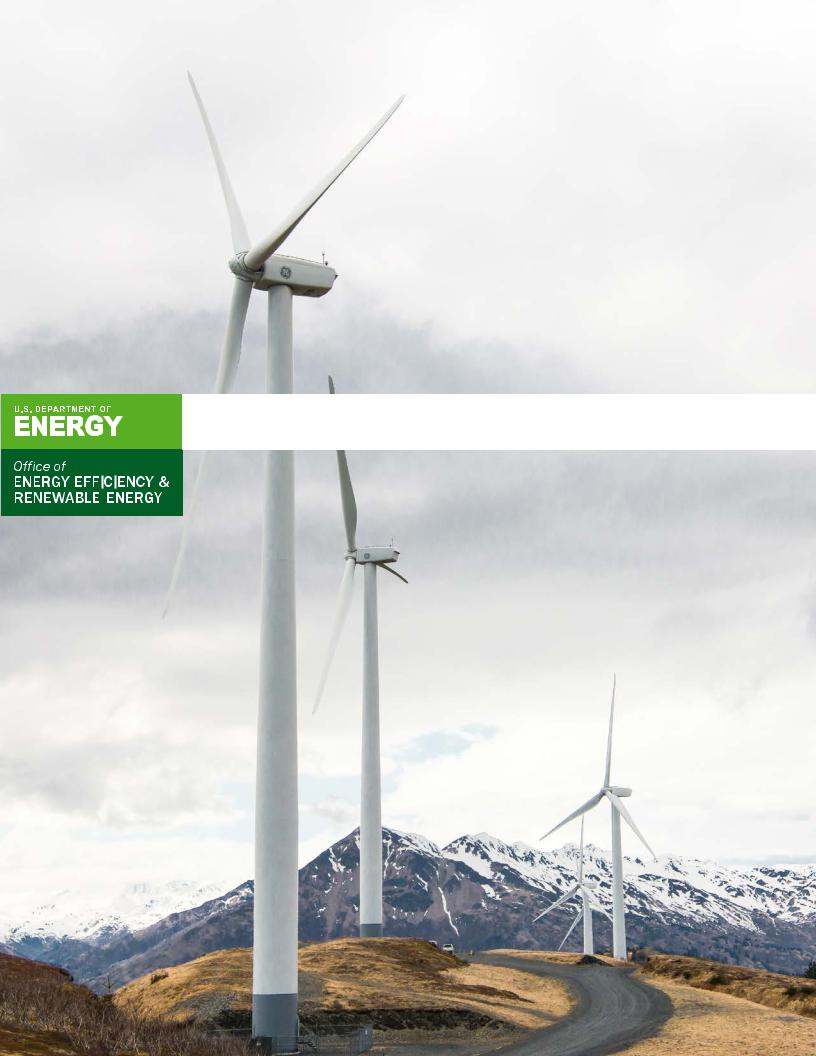
vk.com/id446425943
2018 Wind Technologies Market Report

vk.com/id446425943
This report is being disseminated by the U.S. Department of Energy (DOE). As such, this document was prepared in compliance with Section 515 of the Treasury and General Government Appropriations Act for fiscal year 2001 (public law 106-554) and information quality guidelines issued by DOE. Though this report does not constitute “influential” information, as that term is defined in DOE’s information quality guidelines or the Office of Management and Budget’s Information Quality Bulletin for Peer Review, the study was reviewed both internally and externally prior to publication. For purposes of external review, the study benefited from the advice and comments of nine industry stakeholders, U.S. Government employees, and national laboratory staff.
NOTICE
This report was prepared as an account of work sponsored by an agency of the United States government. Neither the United States government nor any agency thereof, nor any of their employees, makes any warranty, express or implied, or assumes any legal liability or responsibility for the accuracy, completeness, or usefulness of any information, apparatus, product, or process disclosed, or represents that its use would not infringe privately owned rights. Reference herein to any specific commercial product, process, or service by trade name, trademark, manufacturer, or otherwise does not necessarily constitute or imply its endorsement, recommendation, or favoring by the United States government or any agency thereof. The views and opinions of authors expressed herein do not necessarily state or reflect those of the United States government or any agency thereof.
Available electronically at SciTech Connect: http://www.osti.gov/scitech
Available for a processing fee to U.S. Department of Energy and its contractors, in paper, from:
U.S. Department of Energy
Office of Scientific and Technical Information P.O. Box 62
Oak Ridge, TN 37831-0062 OSTI: http://www.osti.gov Phone: 865.576.8401
Fax: 865.576.5728 Email: reports@osti.gov
Available for sale to the public, in paper, from:
U.S. Department of Commerce National Technical Information Service 5301 Shawnee Road
Alexandria, VA 22312 NTIS: http://www.ntis.gov
Phone: 800.553.6847 or 703.605.6000 Fax: 703.605.6900
Email: orders@ntis.gov
ii
